THIS POST IS SPONSORED BY
Bob’s Red Mill, who I’m so excited to partner & share with you all throughout 2021. Bob’s Red Mill is my longtime go-to for natural & whole grain foods! All thoughts & opinions are my own.
How to Make Homemade Pasta – A Comprehensive Guide to Fresh Pasta!
If you’ve been around PWWB for a while, you know that my truest culinary love in life is pasta. There’s nothing I love more than a good pasta recipe, & they’re my absolute favorite to develop! & the really fun thing? You seem to love them just as much as I do! Italian dishes like my Best-Ever Bolognese, Braised Lamb Ragu, & Creamy Marsala Pasta are not only some of my favorite recipes here on PWWB, but they’re also some of the most popular, well-loved recipes within the PWWB community.
It should come with little surprise, then, that developing & sharing a killer fresh pasta recipe for beginners is something that’s been in the back of my mind forever. So, I put it into motion earlier this year, learning about all the ins & outs of making fresh pasta at home. After countless batches of fresh pasta dough – the PWWB Guide to How to Make Homemade Pasta is here!
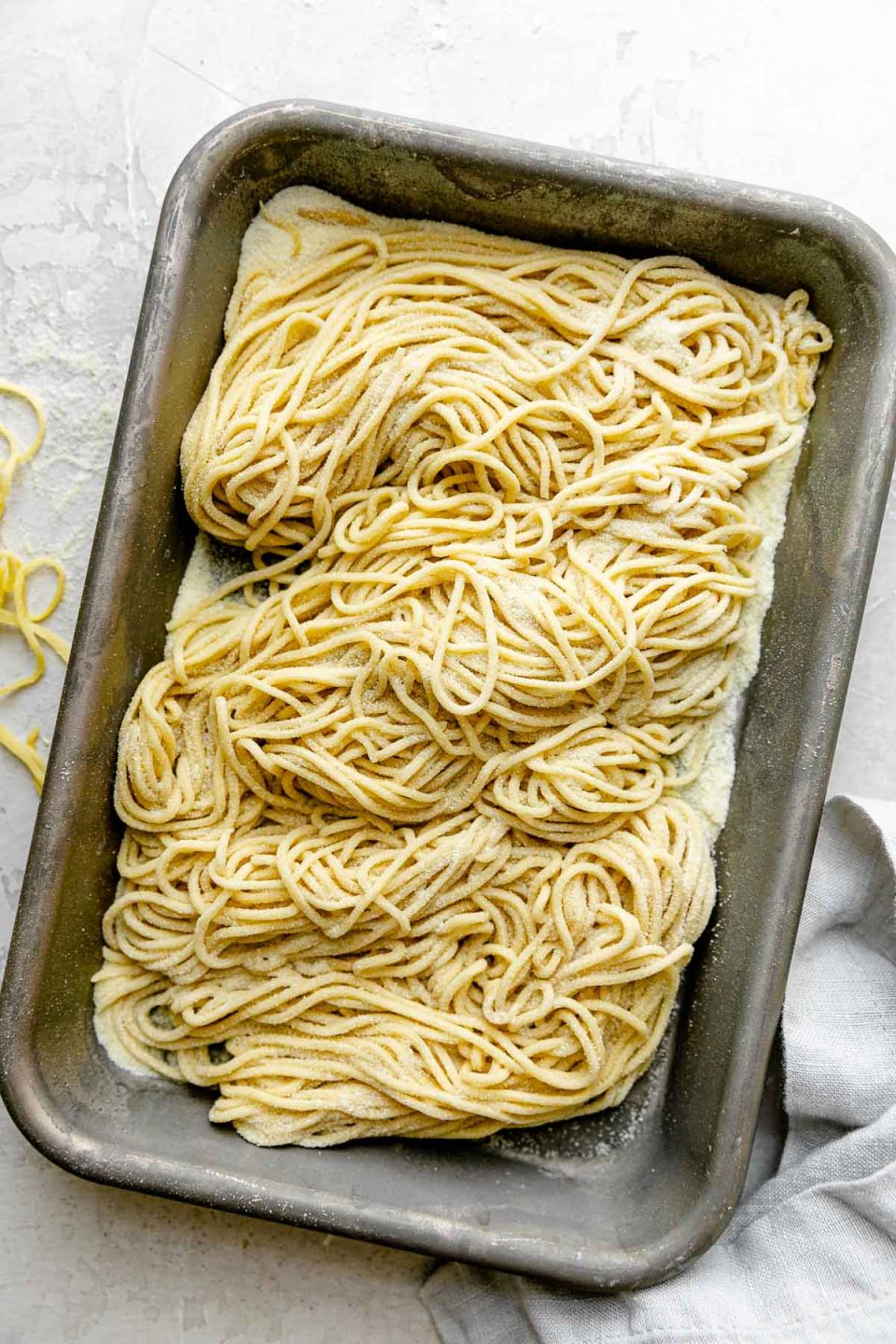
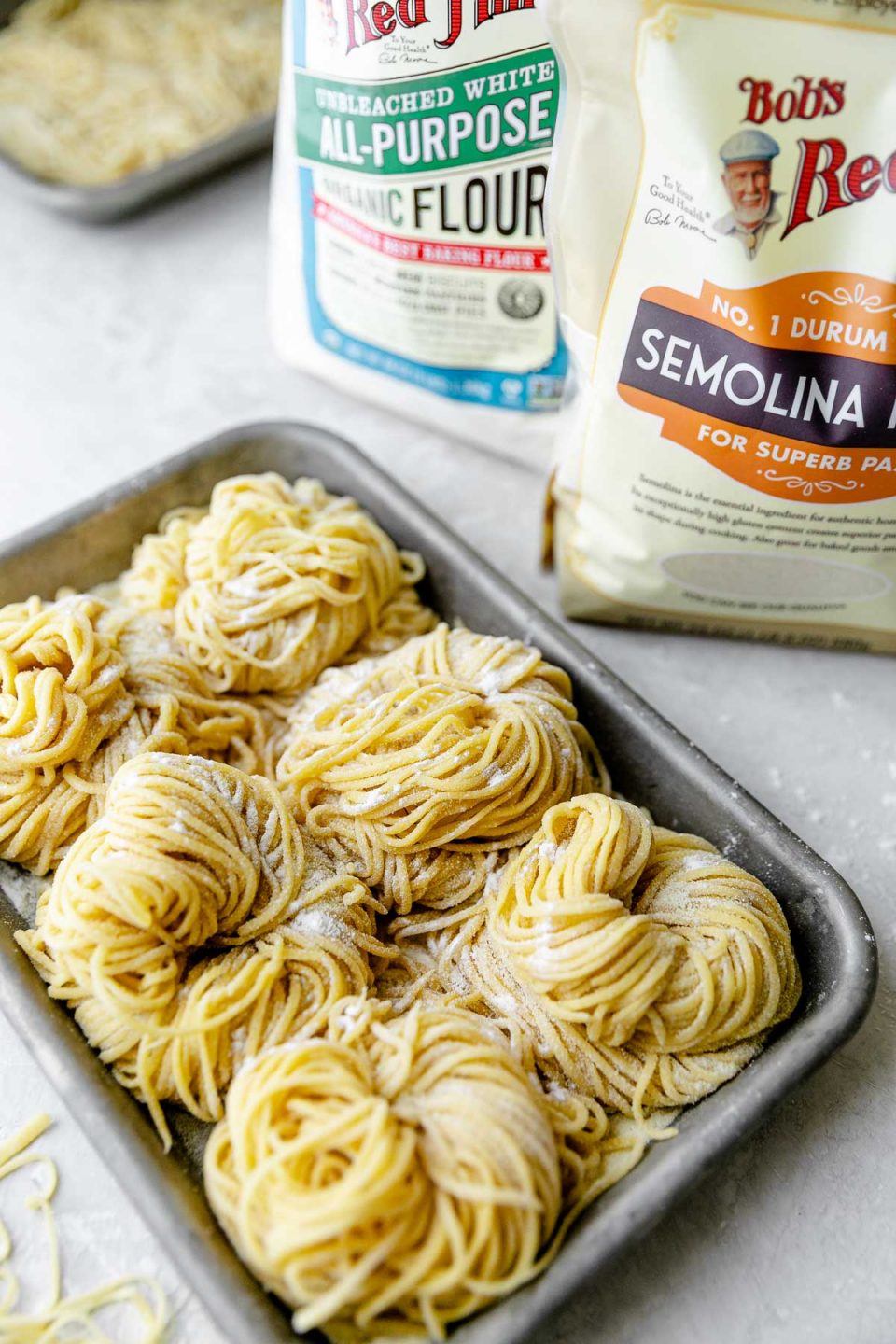
Why learn how to make fresh pasta at home?
Here’s the deal: Every pasta lover – I’d even go so far as to say every food lover – should learn how to make homemade pasta. While we’re fortunate enough to live in times where an abundance of amazing dried pasta is readily available to us, in just about every shape imaginable, there’s something about making it from scratch that gives way to a much deeper appreciation for pasta.
The kinda fun part about it? Making fresh pasta dough at home is truly so simple. You need just 5 staple ingredients – all of which I bet are in your kitchen right now – & it only requires about 30 minutes of active work. I’m not saying you will whip up a batch of homemade pasta dough any ol’ night of the week, but it’s simple enough that you definitely can.
No matter how you end up using it, making fresh pasta at home is a deliciously fun kitchen project that’s perfect for special meals. It’s the ideal for date night at home, Sunday supper, holiday dinners, or dinner parties with the people you love most. Once you learn how to make homemade pasta, a whole new delicious world of possibilities is at your finger tips. (Really, is there anything better than that?!)
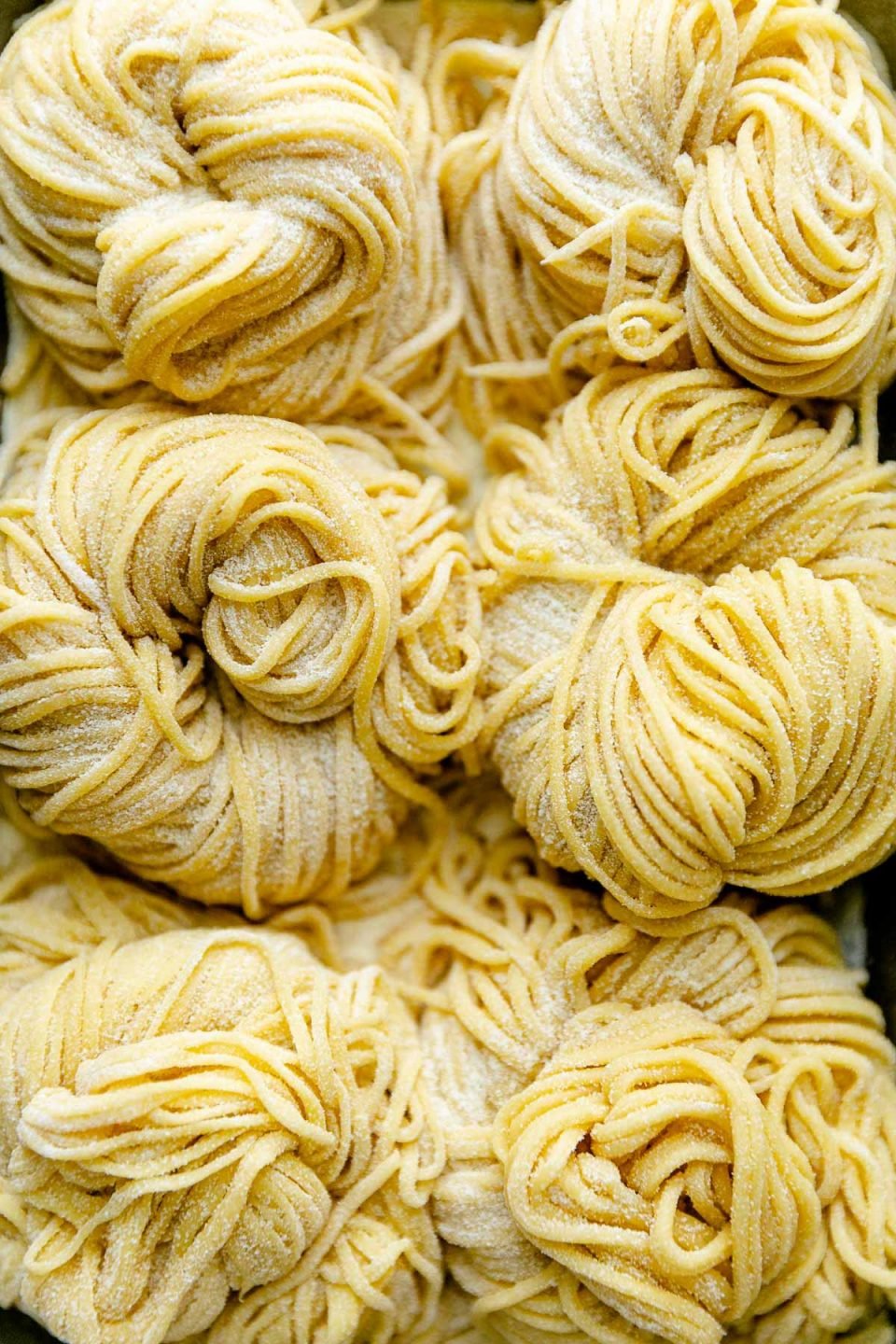
An Overview of What You’ll Find in this Post:
Whether you’ve always been too intimidated to try fresh pasta or you’ve made it a few times but never got the feel for it, you’re in the right place! This post is a comprehensive guide to fresh pasta, including an easy fresh pasta dough recipe & step-by-step instructions with tons of visuals, plus tons of tips & tricks to help you troubleshoot.
While the full how-to is detailed in the Recipe Card at the bottom of this post, the sections of the blog post itself break down all of hows & whys, including (click below for shortcuts within this post)…
- Details on the 5 ingredients you need to make fresh pasta dough including potential ingredient substitutions, plus an overview of the helpful equipment & materials you need to make pasta.
- Step-by-step instructions for how to make fresh pasta without a machine as well as a shortcut method that requires far less elbow grease, plus troubleshooting tips & tricks.
- Everything you need to know about how to cook homemade pasta & tons of recipe inspiration for your first homemade pasta dinner.
Read on to learn more about this Fresh Pasta Recipe, or jump straight to the recipe & get rolling! I’m so excited to make pasta together! ♡
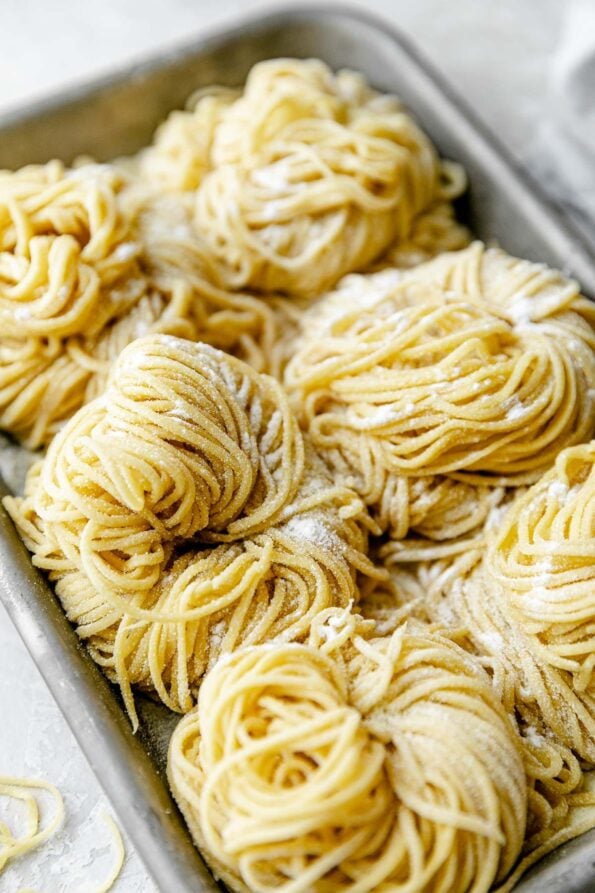
FREE Email Series: PWWB Pasta School
Make restaurant-worthy pasta at home!
Homemade Pasta Ingredients
One of the best things about making homemade pasta dough is that you need very minimal ingredients & they’re all simple staples. To make this fresh pasta recipe, you need just 5 ingredients, which you probably already have in your kitchen:
- Flour
- Eggs
- Extra virgin olive oil
- Water
- Salt
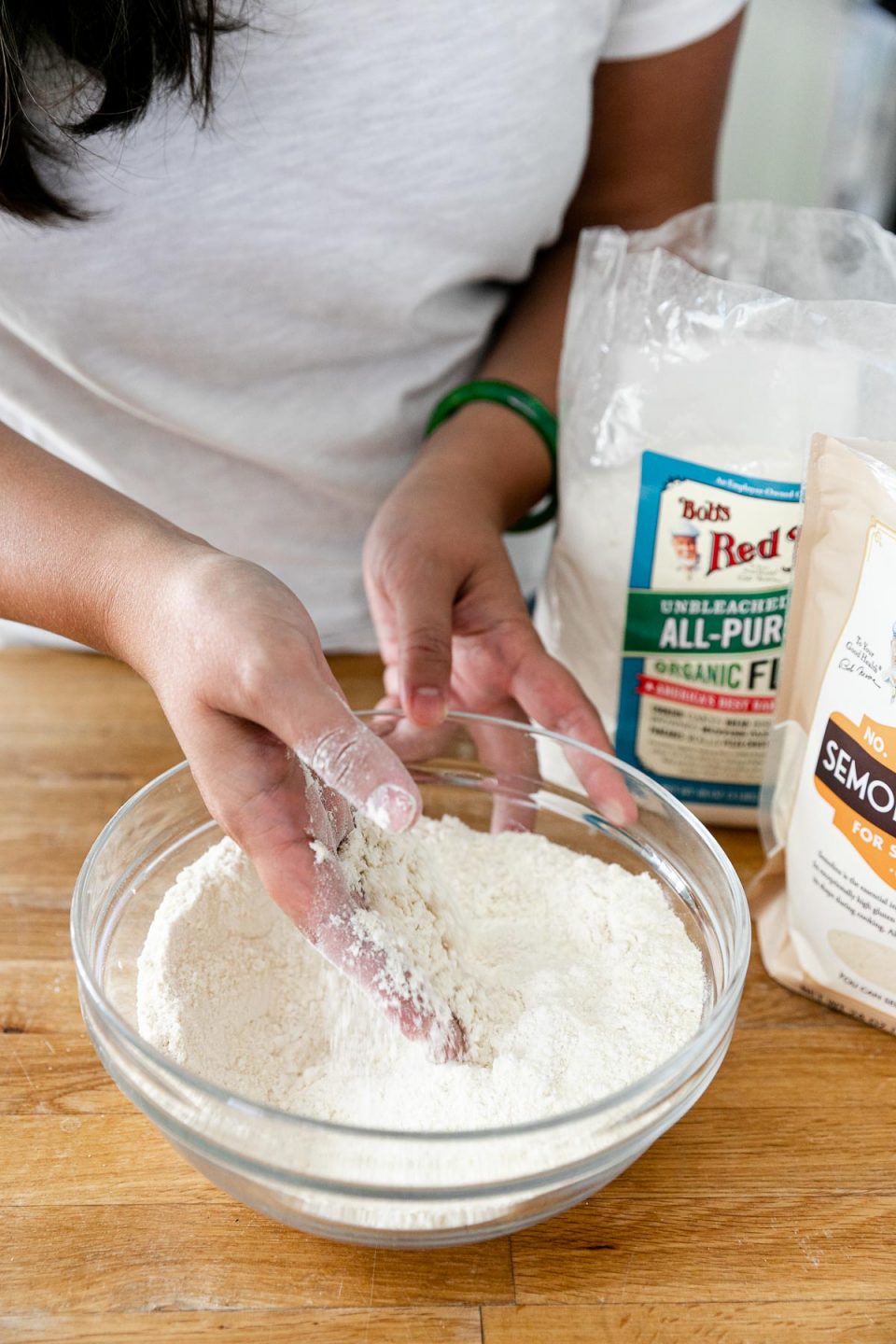
Fresh Pasta FAQ: What’s the best flour for homemade pasta?
There are 3 types of flour commonly used in fresh pasta recipes – 00 flour (i.e. finely milled, high-protein flour), all-purpose flour, & semolina flour. This particular fresh pasta recipe is made with a combination of all-purpose flour & semolina flour, which creates dough that is both easy to work with & has great texture.
While pasta purists may swear by a base of 00 flour (i.e. finely milled, high-protein flour), I’ve opted for all-purpose flour. It yields great results &, especially if you’re just getting started with pasta making, the difference in the pasta is pretty negligible. As a bonus, it’s always in my kitchen (& I’d guess the same can be said about you!). Since the ingredients list is so minimal & since flour plays such an important role in fresh pasta dough, it’s important to use really high-quality flour. That’s where I always turn to my friends Bob’s Red Mill.
Bob’s Red Mill Organic Unbleached All-Purpose Flour is a staple that you’ll always find in my kitchen. It’s milled from the highest quality North American wheat & it has a 10-12% protein content to help facilitate gluten development, crucial for making homemade pasta with satisfying chewy texture.
Ingredient Spotlight ⇢ What is Semolina Flour?
Semolina is a type of flour milled from durum wheat. It’s high in protein, high in gluten, & has a much coarser texture than your typical powdery-fine all-purpose flour. This coarseness is exactly why I’ve added it to my basic pasta dough recipe – it adds amazing weight & texture to fresh pasta:
- Weight: Since semolina is denser than all-purpose flour, the resulting pasta is a littler more substantial & satisfying, which is especially great for hearty sauces like ragu or bolognese.
- Texture: Semolina’s coarseness also helps create pasta with slightly rougher texture, which gives pasta sauce something to cling to as it’s tossed with the pasta & results in a pasta dish that’s simply tastier!
If you don’t keep your kitchen stocked with semolina flour, you can make this fresh pasta recipe using 100% all-purpose flour with great results. I will say – it’s definitely worth picking up a bag! It makes a notable difference in homemade pasta & it’s great for pizza night, too! Here too, I always count on Bob’s Red Mill. Bob’s Red Mill Semolina Flour is absolutely beautiful & has the perfect texture.
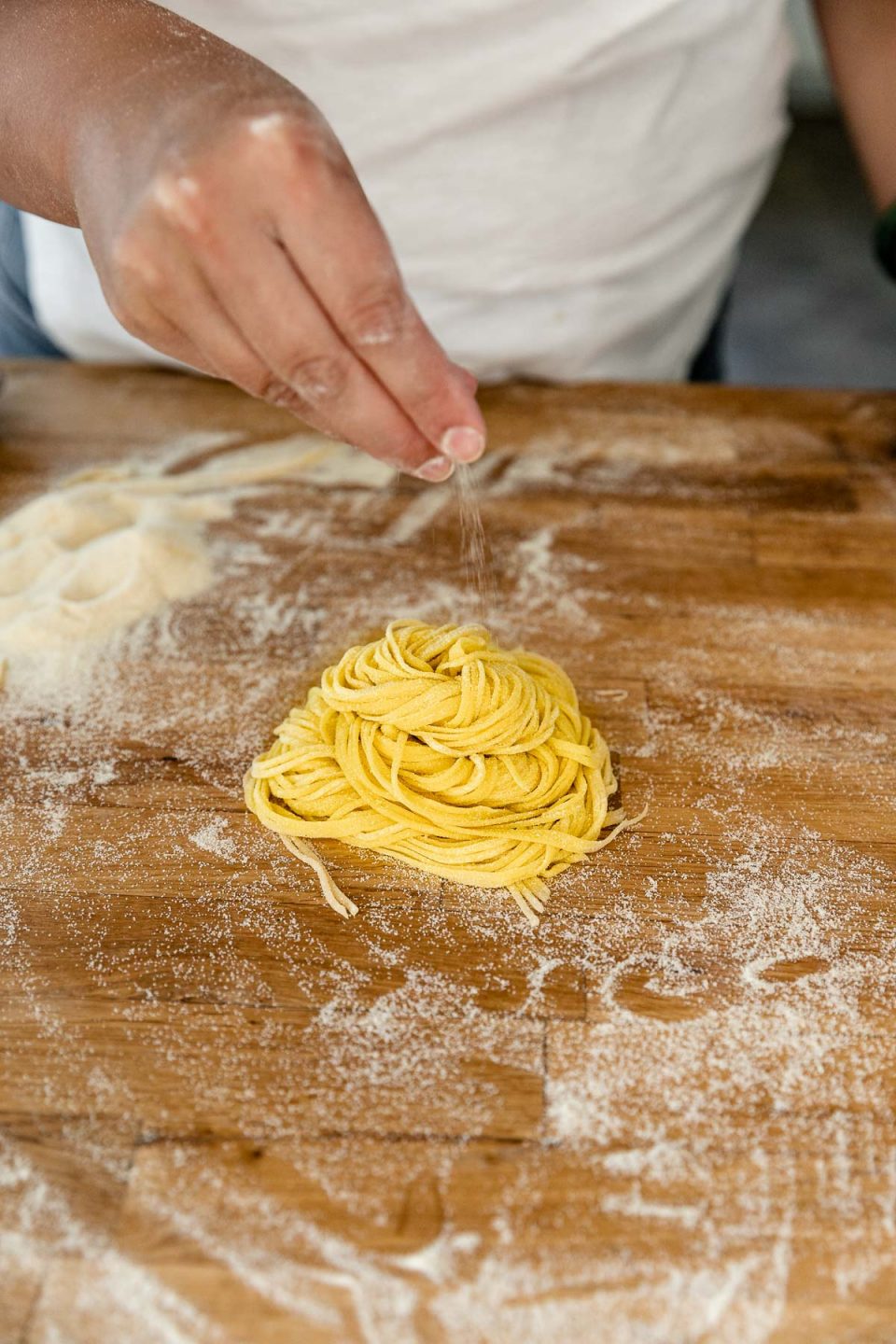
Fresh Pasta FAQ: Is homemade pasta better with or without eggs?
While you can make homemade pasta using just water (no eggs), eggs add not just moisture, but also protein & fat. The resulting fresh pasta dough is much easier to handle. Because gluten development is so important in creating satisfying texture, working with fresh pasta dough that’s a little easier to knead makes a world of difference in the overall texture of the pasta, especially as beginners!
This fresh pasta recipe calls for a combination of whole eggs & egg yolks. The whites of the whole eggs add moisture & the additional yolks add fat, resulting in homemade pasta that’s rich in flavor & has smooth, supple texture.
Other Equipment & Materials You Need to Make Pasta:
You can make a batch of fresh pasta dough with no more than your two hands & a rolling pin, however there are a couple of simple tools that help make learning how to make fresh pasta a whole lot easier! After prepping countless batches of homemade pasta dough, here’s what I suggest:
- Digital scale – Weighing out flour in grams is a more precise method of measurement than using measuring cups. Because hydration is so important in making fresh pasta dough, precise measurements help eliminate any guesswork, which is really helpful for beginners.
- Bench scraper – A bench scraper comes in handy in bringing the pasta dough together, plus you keeping your work station nice & tidy. Eliminating overwhelm – especially in your first time making pasta! – is very helpful.
- Pasta roller – While you can make homemade pasta without any special equipment or machines, rolling out pasta by hand is labor-intensive & a pasta roller makes a world of difference. I invested in these pasta attachments for my KitchenAid mixer, which I absolutely love. Since the motor of the KitchenAid does all of the cranking, they make rolling out fresh pasta dough so much easier. They are an investment, but I couldn’t recommend them more – especially if you’re really interested in making homemade pasta with any sort of regularity. If you’d like to start with something a little smaller, hand crank pasta machines are great – I’ve used this hand crank pasta roller with great results (& it’s only $40!).
How to Make Fresh Pasta:
Preparing a batch of homemade pasta consists of three key steps. The rest of this post details all of the hows & whys of (click below for shortcuts within this post!):
- Mixing & Kneading Homemade Pasta Dough by hand & using a KitchenAid stand mixer
- Rolling Out & Cutting Fresh Pasta with a pasta roller & by hand
- Cooking Fresh Pasta
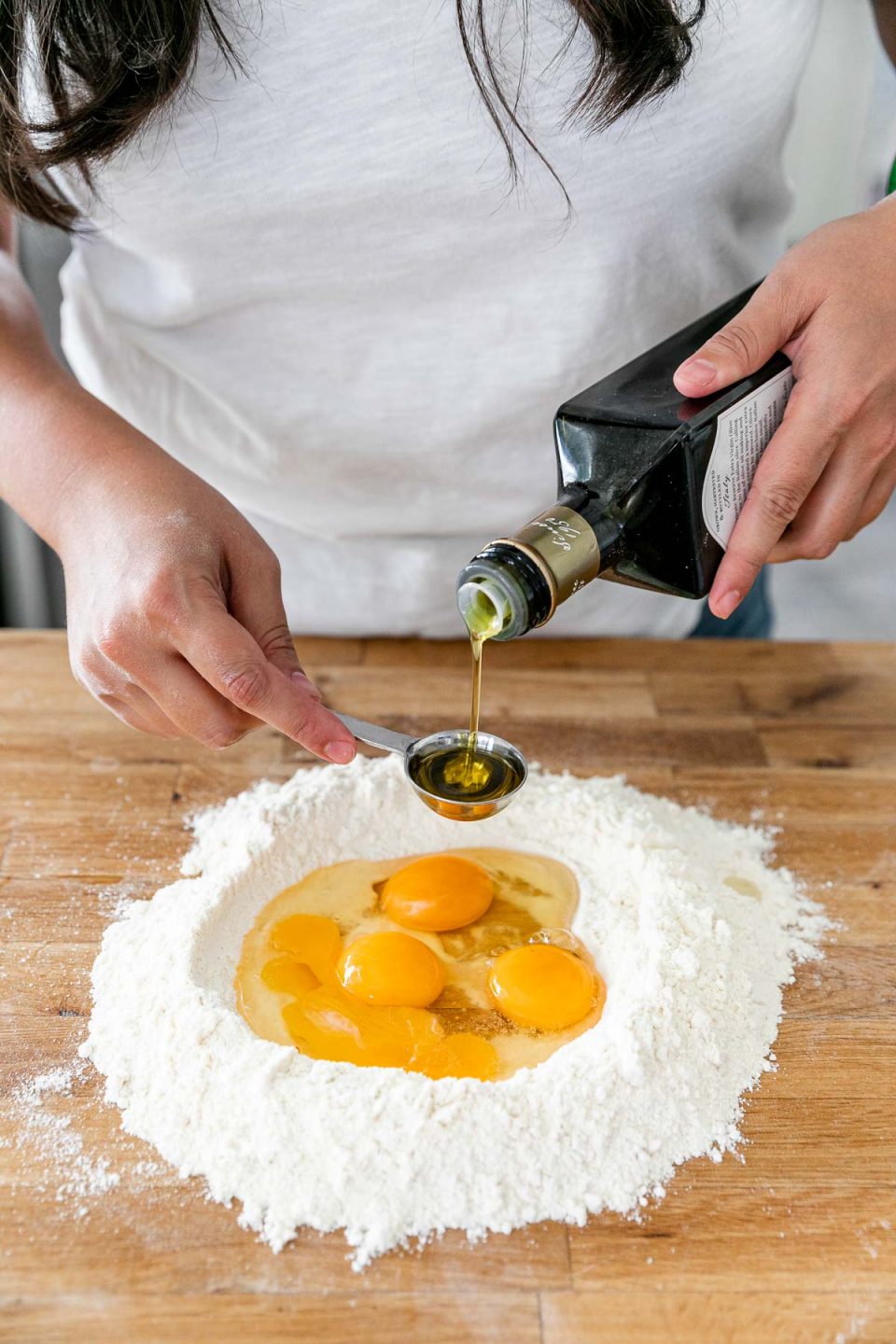
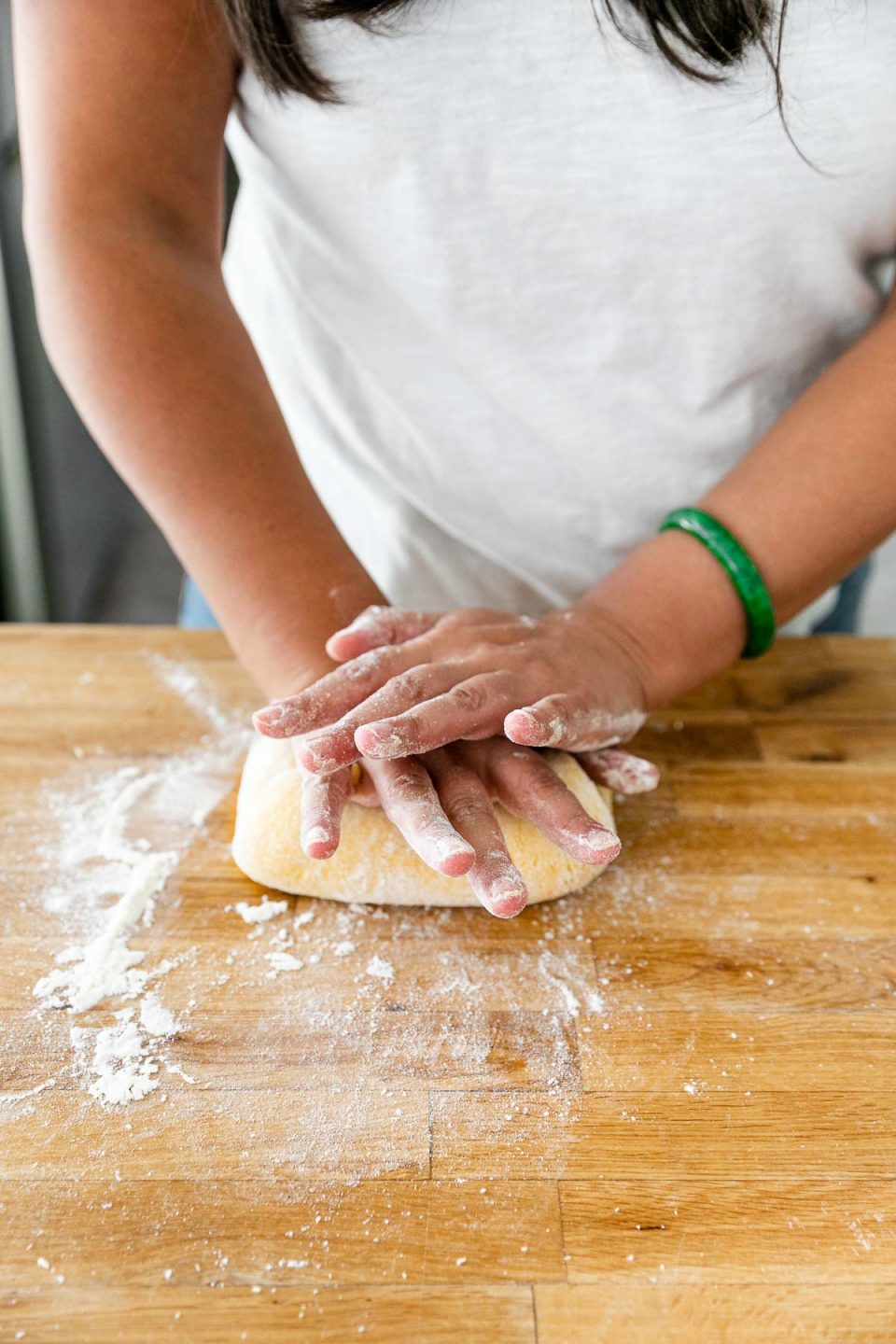
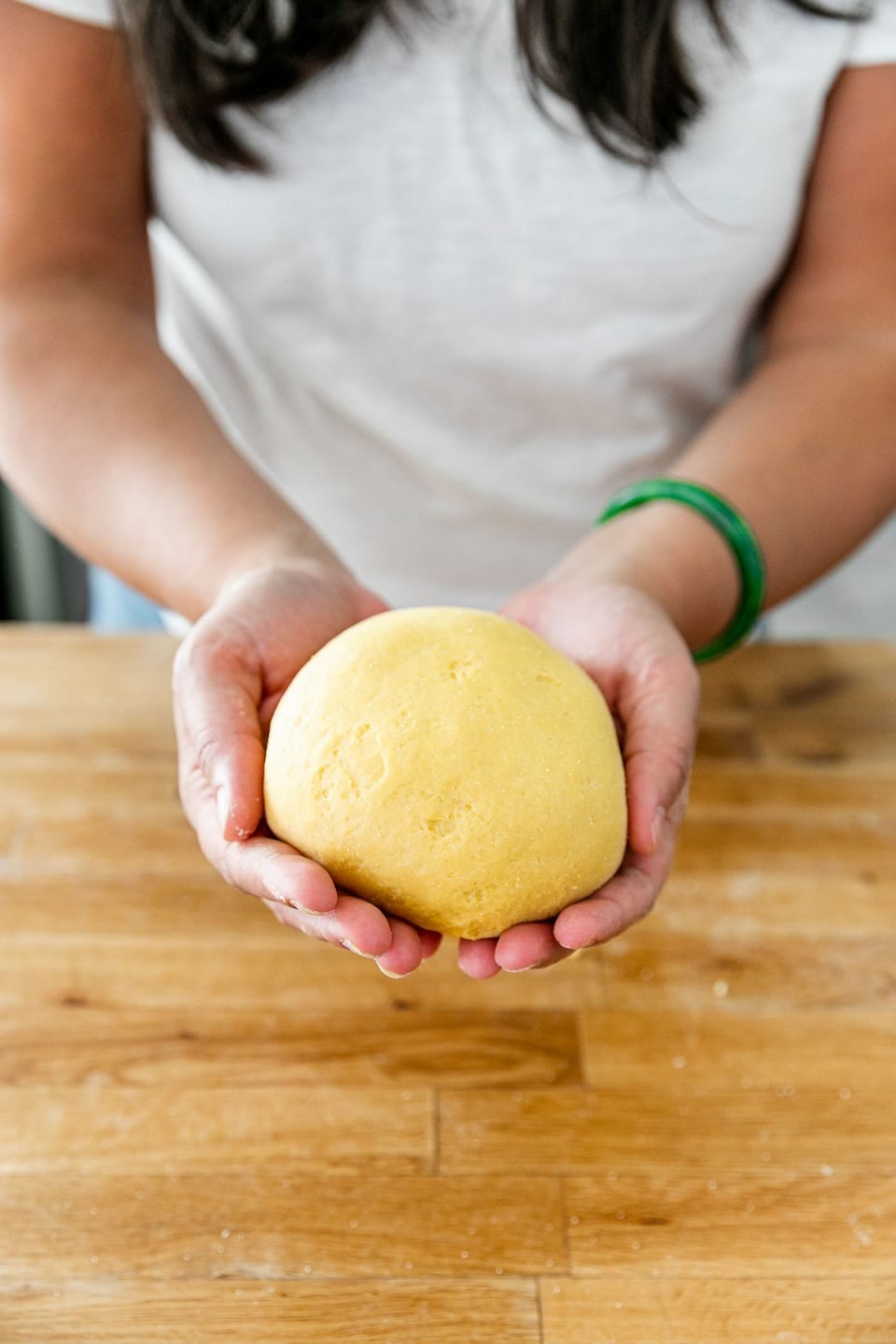
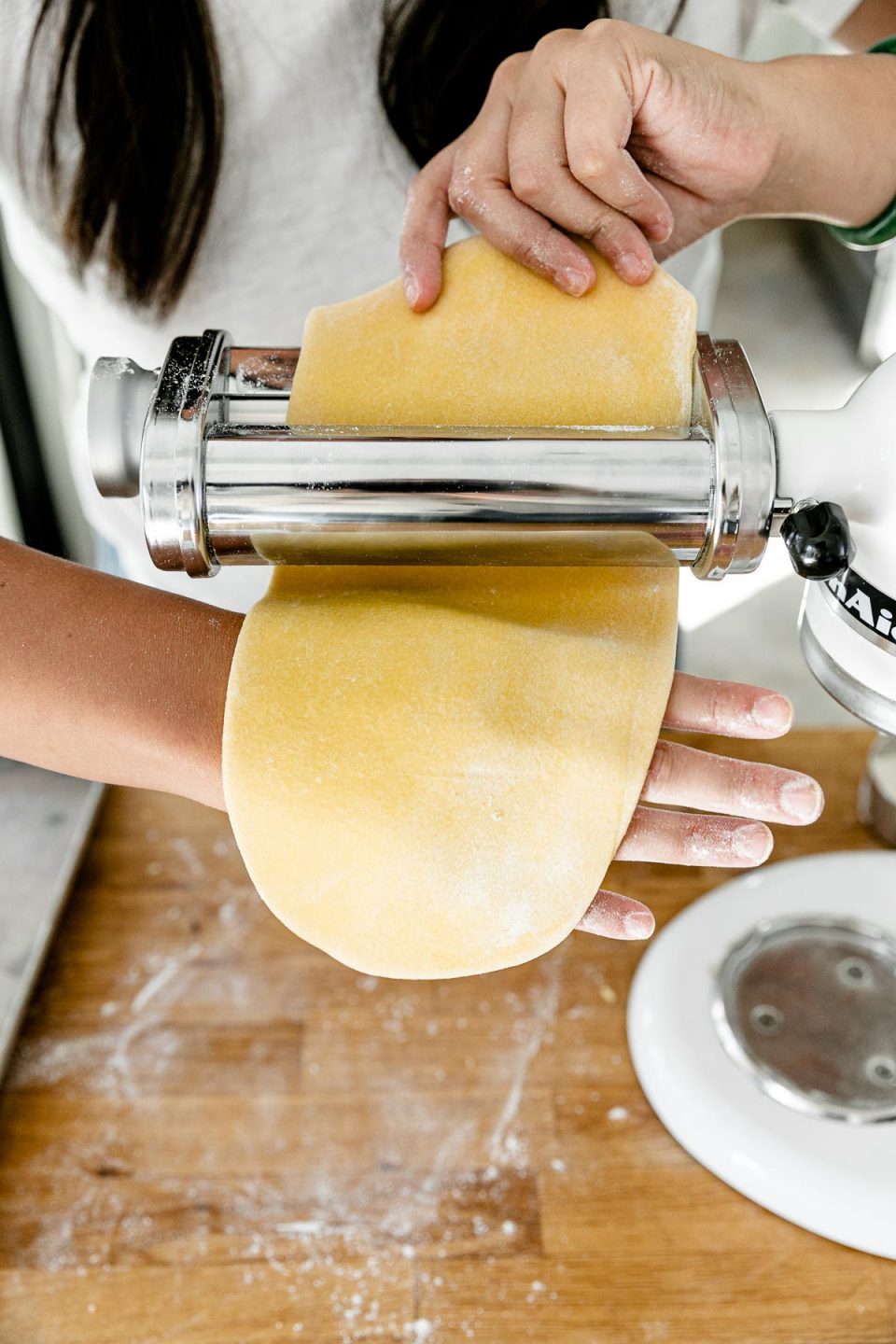
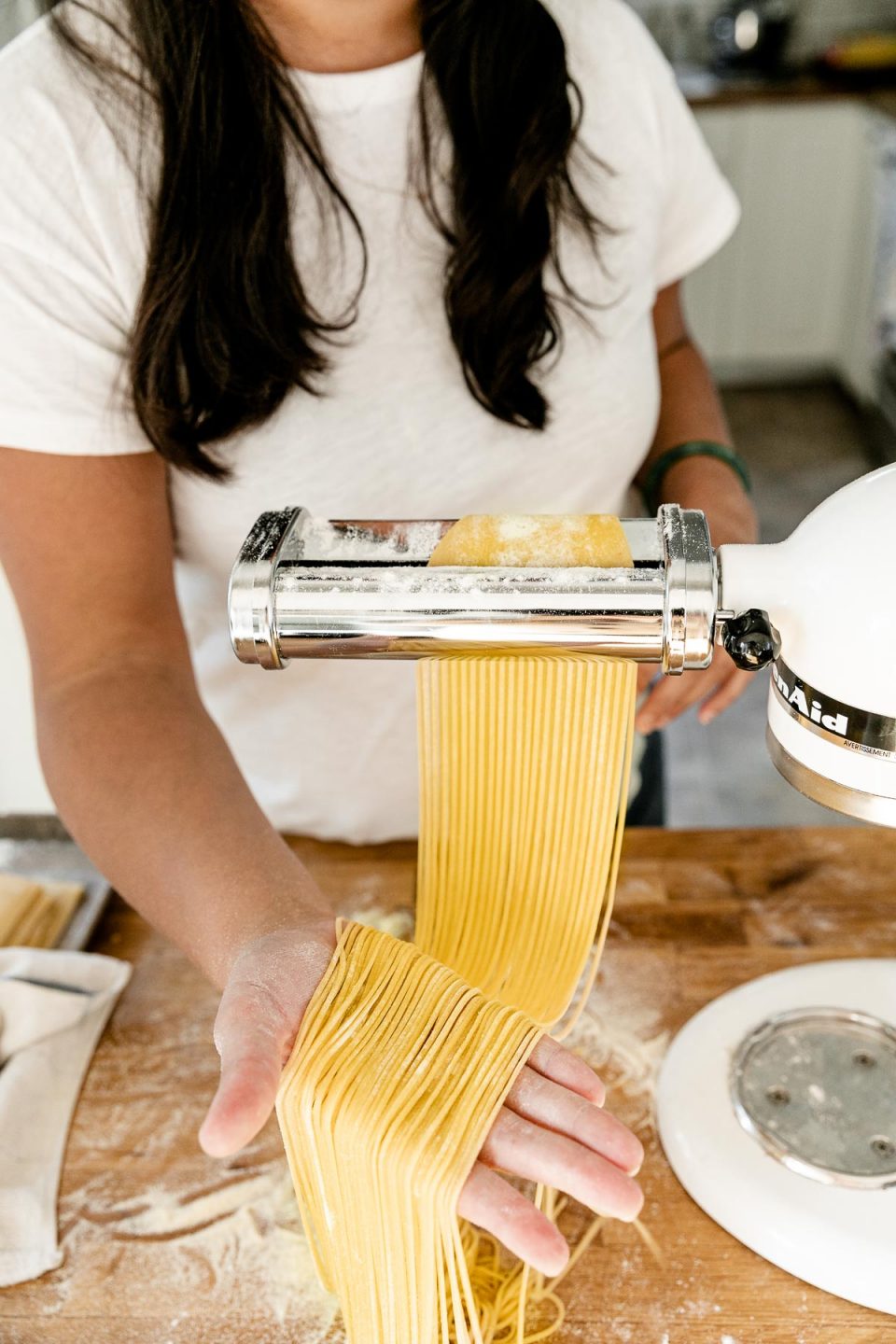
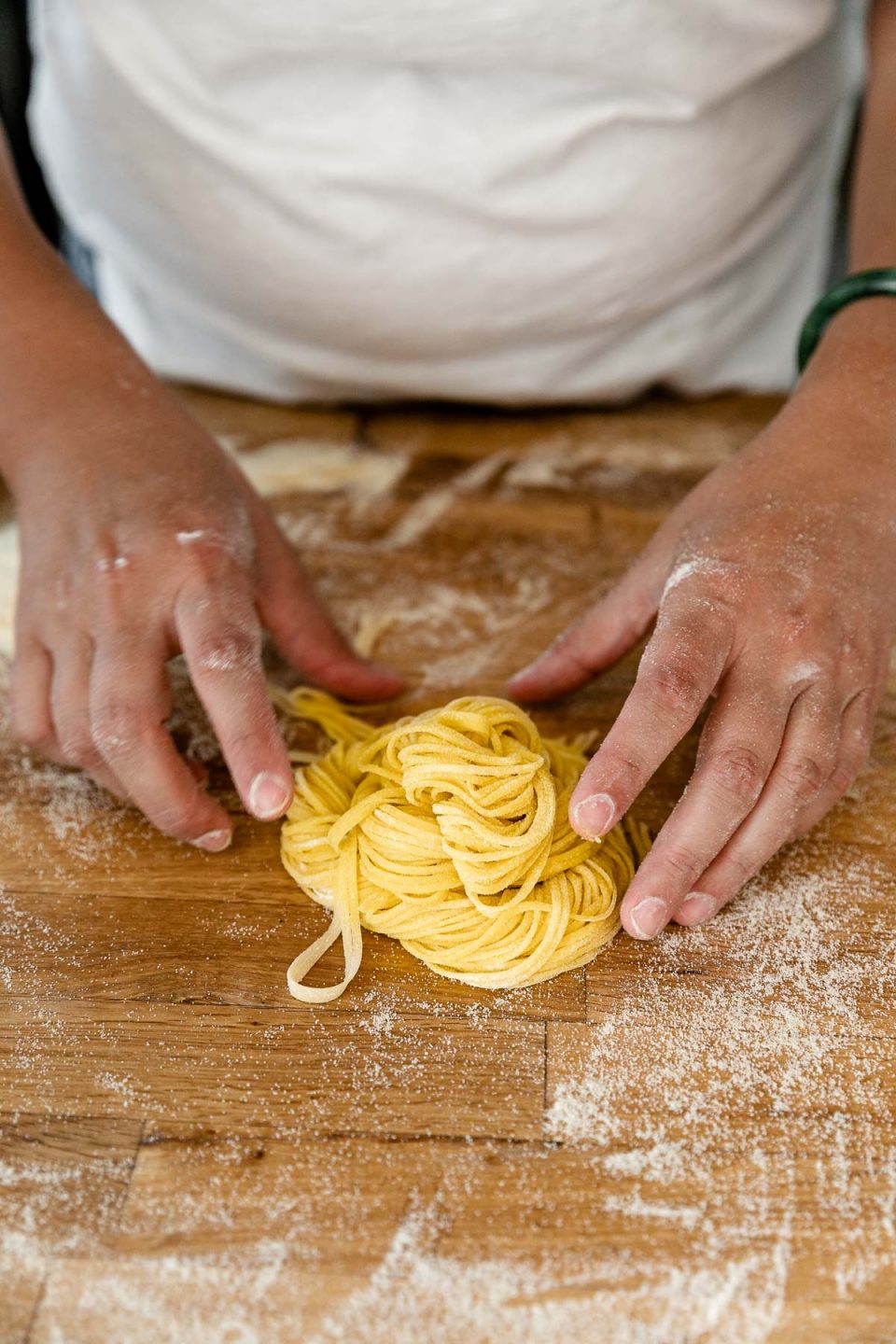
Fresh Pasta Pep Talk!
Some real talk before we jump into all the details. Your first attempt at making this fresh pasta recipe won’t be perfect. Learning how to make homemade pasta is more technique than recipe. It takes practice to get a feel for what fresh pasta dough feels like as you mix & knead it together. That said, I’m confident that if you read through the steps & troubleshooting tips below, you’ll be sure to create a delicious pasta meal to be proud of. Approach it with an open mind & have fun – you might end up falling in love with it! (I did!)
Kneading Homemade Pasta Dough by Hand:
Mixing & kneading fresh pasta dough by hand is my preferred method. Why knead homemade pasta dough by hand? ⇢ Working the fresh pasta dough with your hands allows for greater control of working & stretching the dough. In doing so, you develop the glutens that ultimately create beautiful homemade pasta with chewy, springy texture. It takes about 10 minutes & requires a good deal of elbow grease, but the results are so worth it!
How to Mix & Knead Fresh Pasta Dough by Hand:

First, form a flour well:
Combine the flours in a pile on a clean, sturdy work surface. Create a well in the center; the well needs to be large enough to contain all of the wet ingredients. Add the eggs, olive oil, & water in the prepared well. Use a fork to whisk the egg mixture thoroughly.
Why? ⇢ This traditional technique allows us to thoroughly mix the wet ingredients before pulling in the flours gradually, giving us more control over the dough & eliminating any lumps, bumps, or flour pockets.
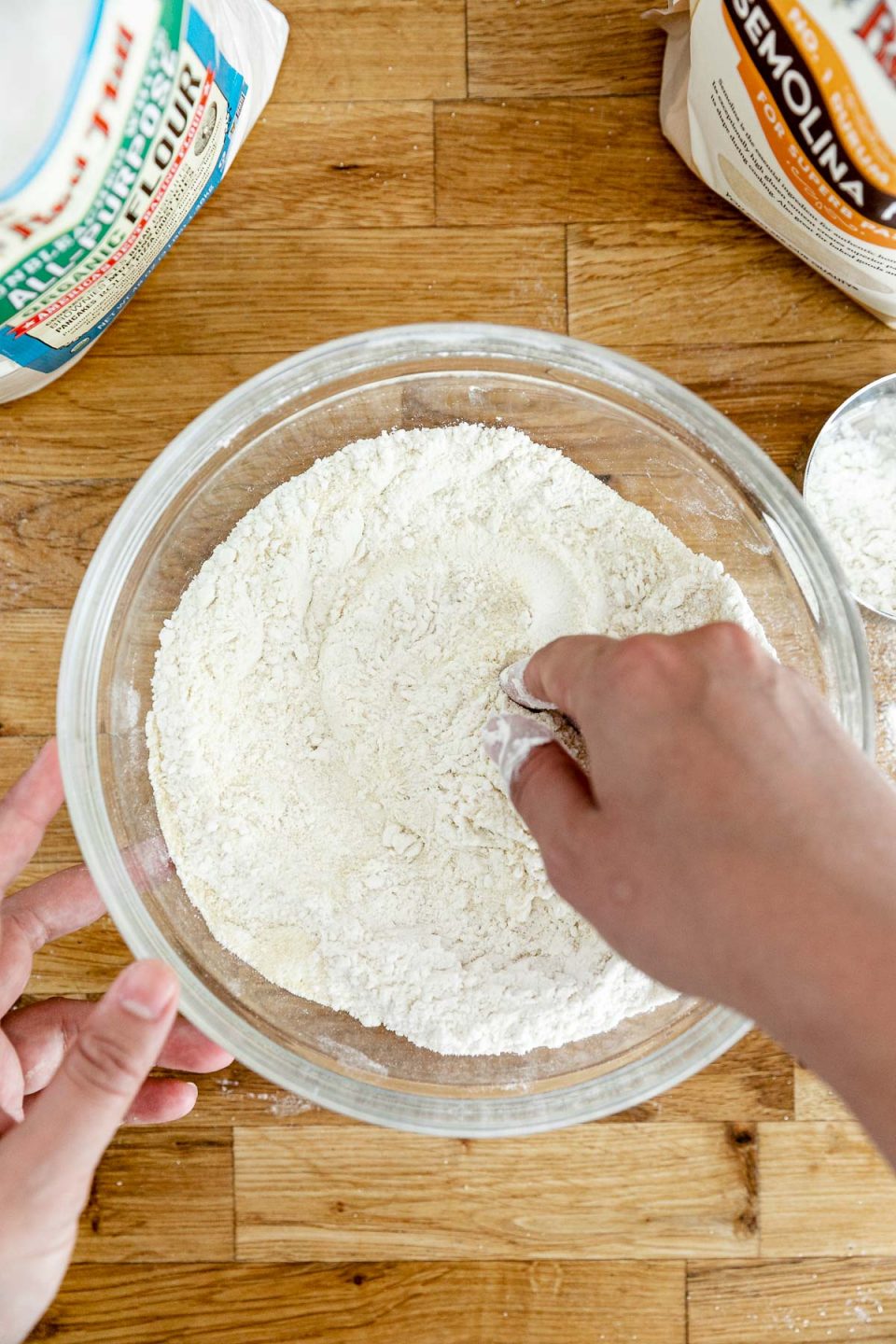
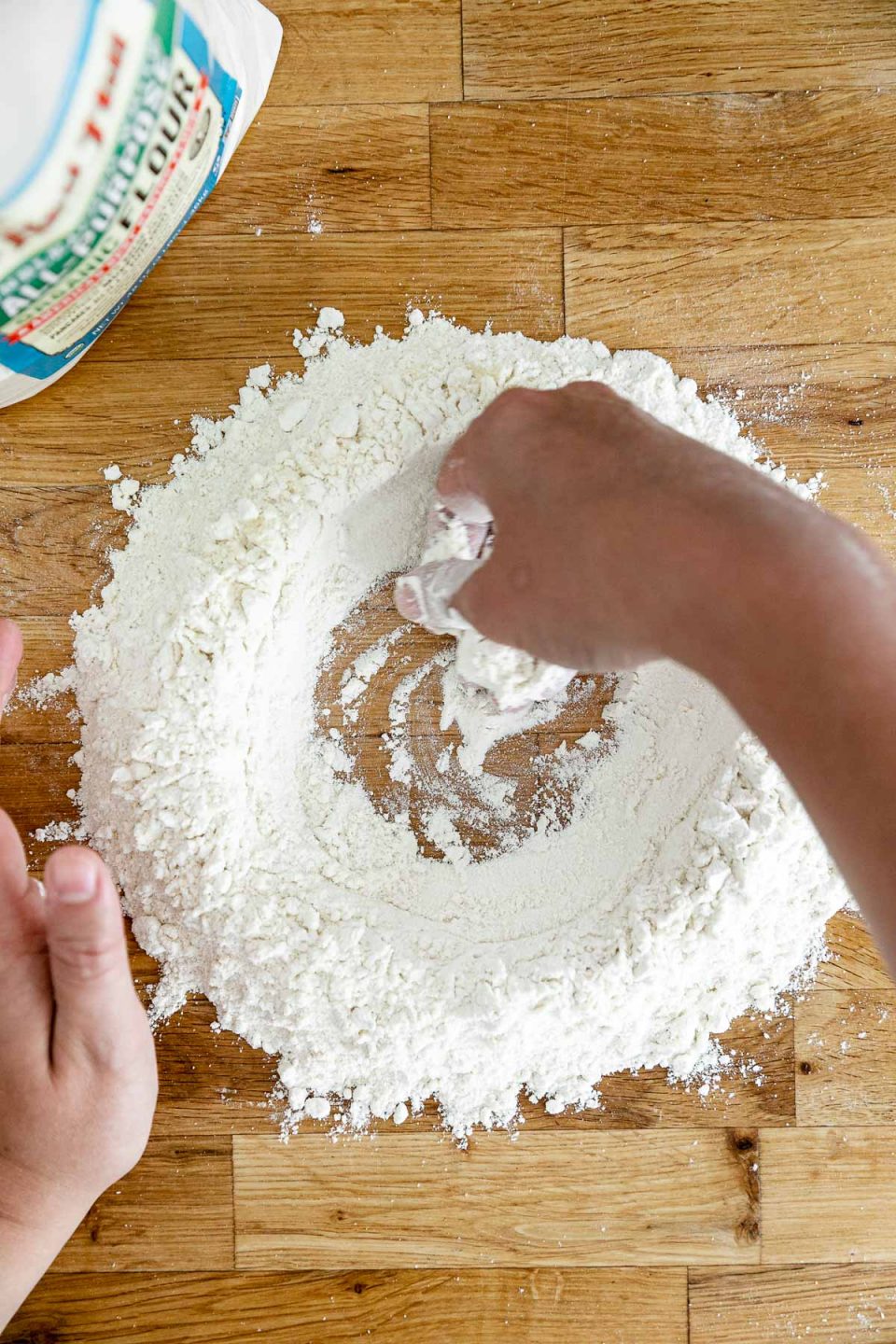

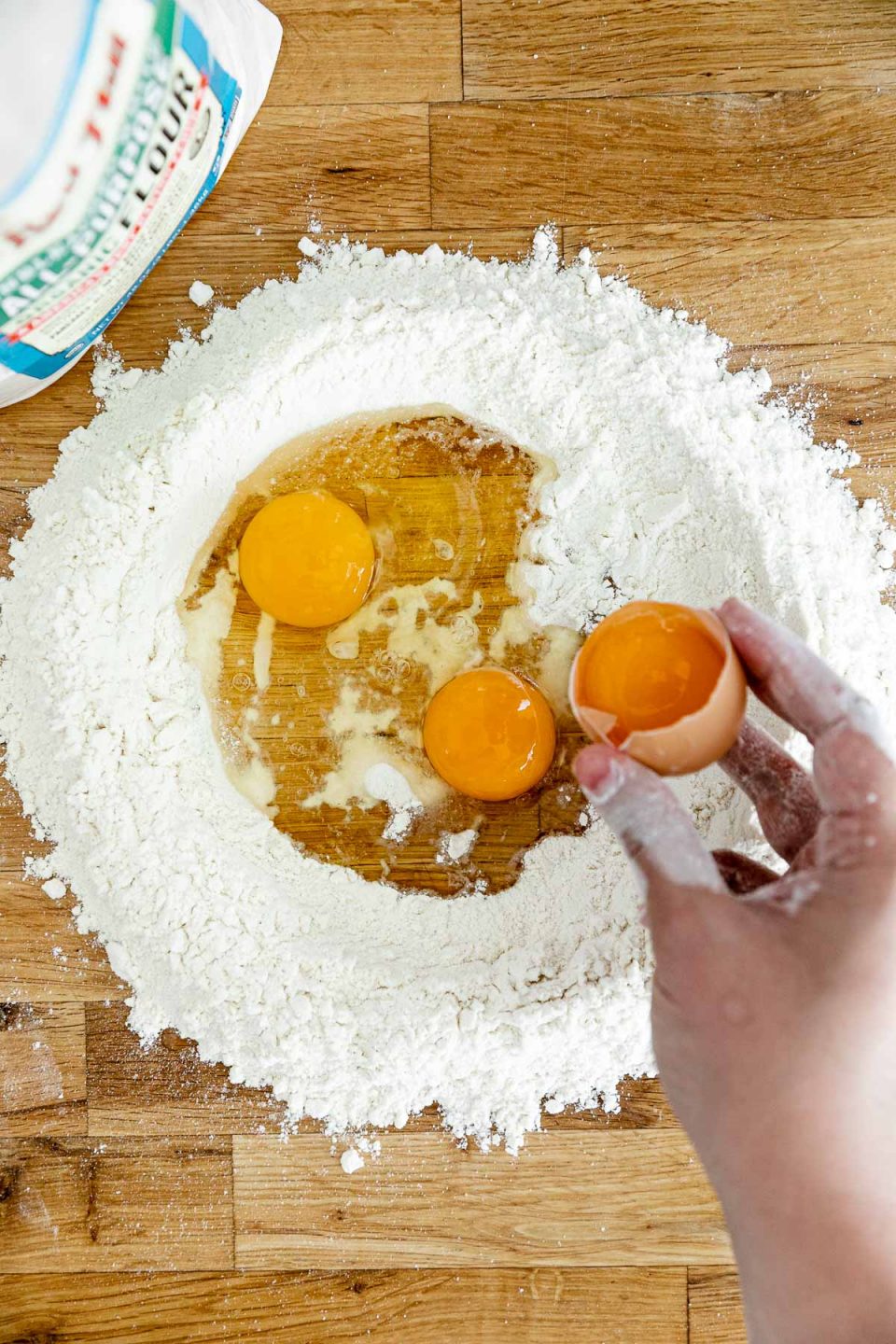
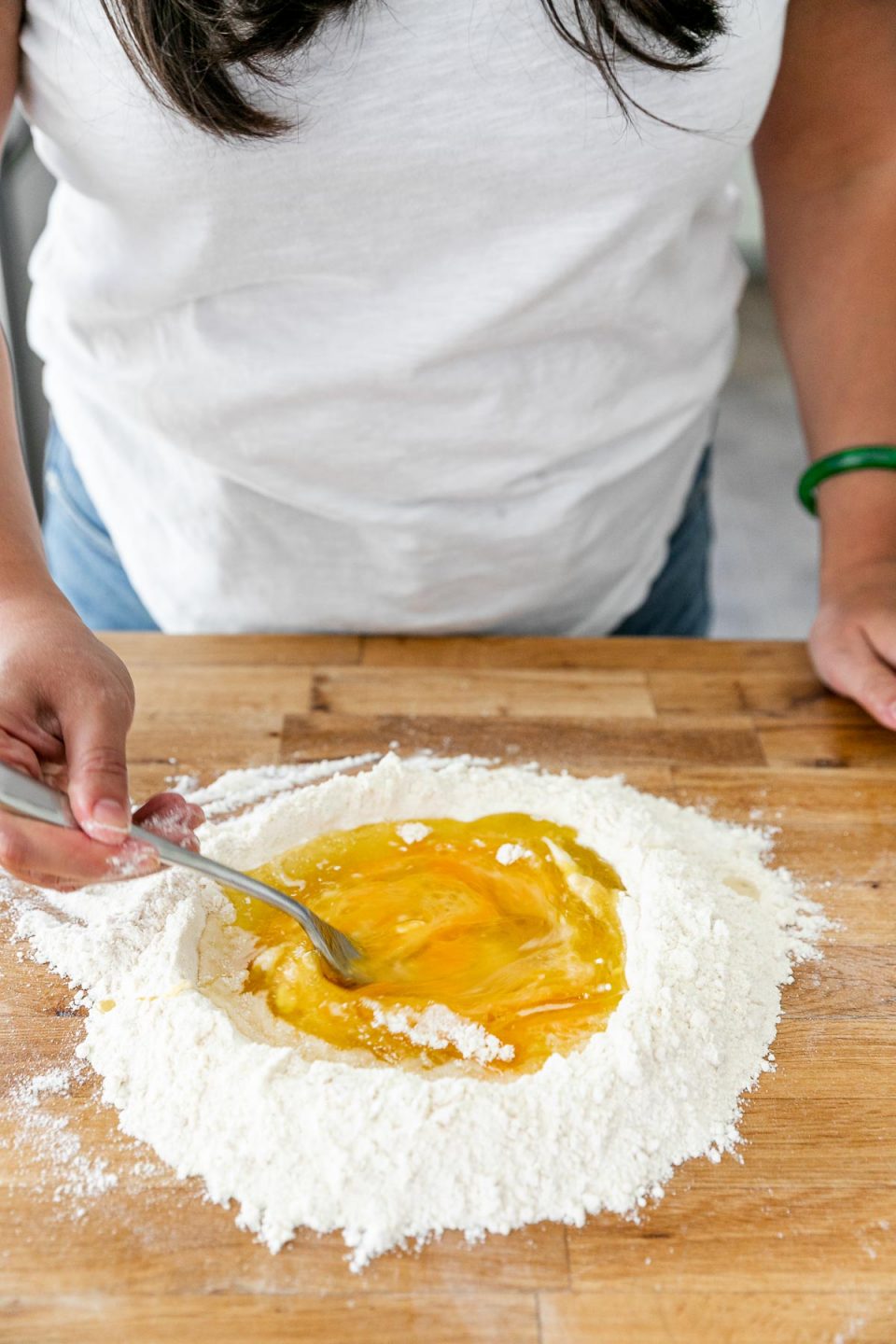
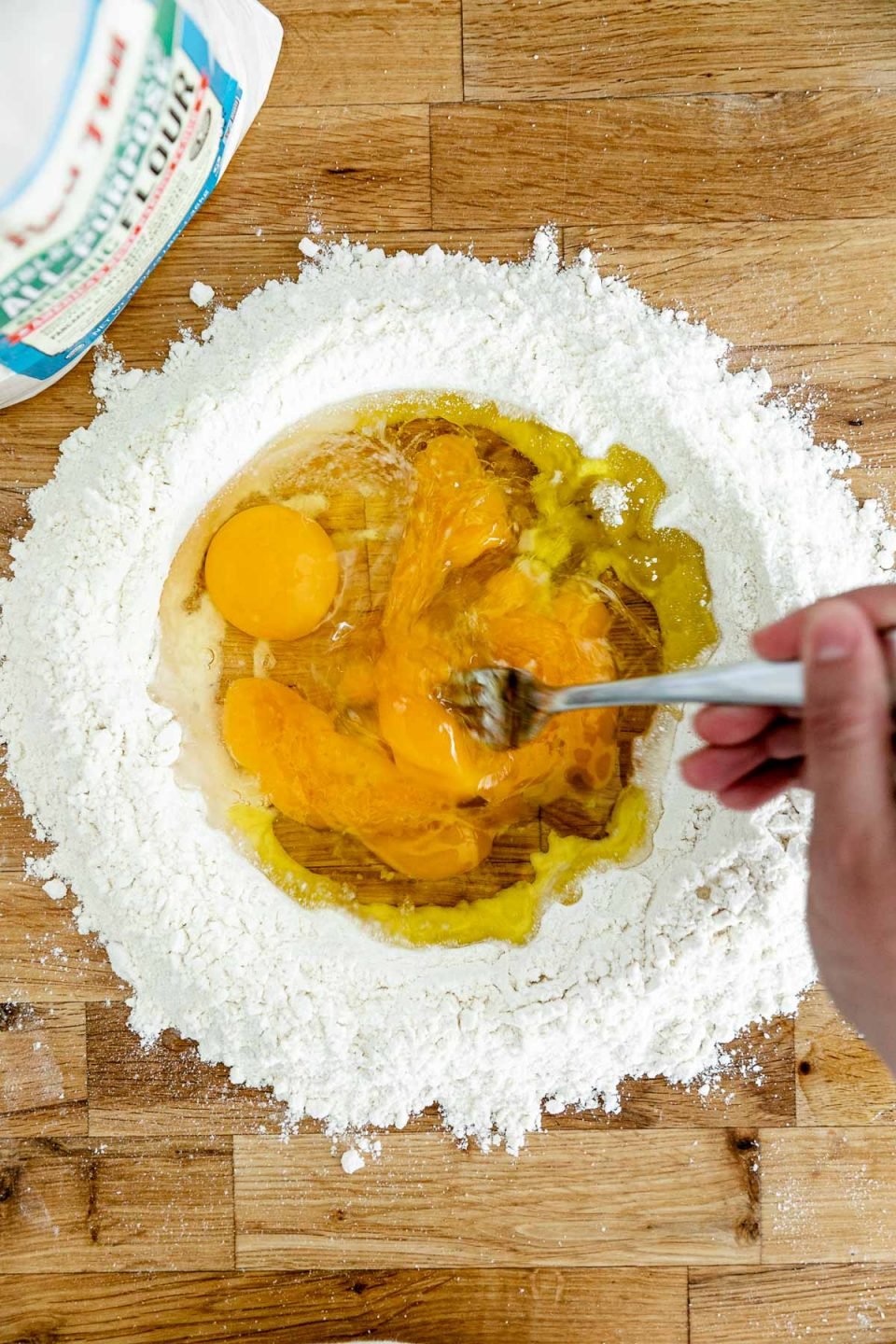
Full Recipe Directions, including step-by-step photos, included in the Recipe Card, below.
Mix the pasta dough:
While whisking steadily, gradually pull flour from the edges of the well into the wet mixture. Once the mixture is too thick to continue whisking, use your hands to bring the dough together into a ball.
Homemade pasta dough tip! ⇢ Because the dough is rather wet & sticky at this point, I like to use a bench scraper to pull it together. Its flat edge makes it easy to fold the loose flour into the dough without creating an overwhelming mess on your hands or your workspace.
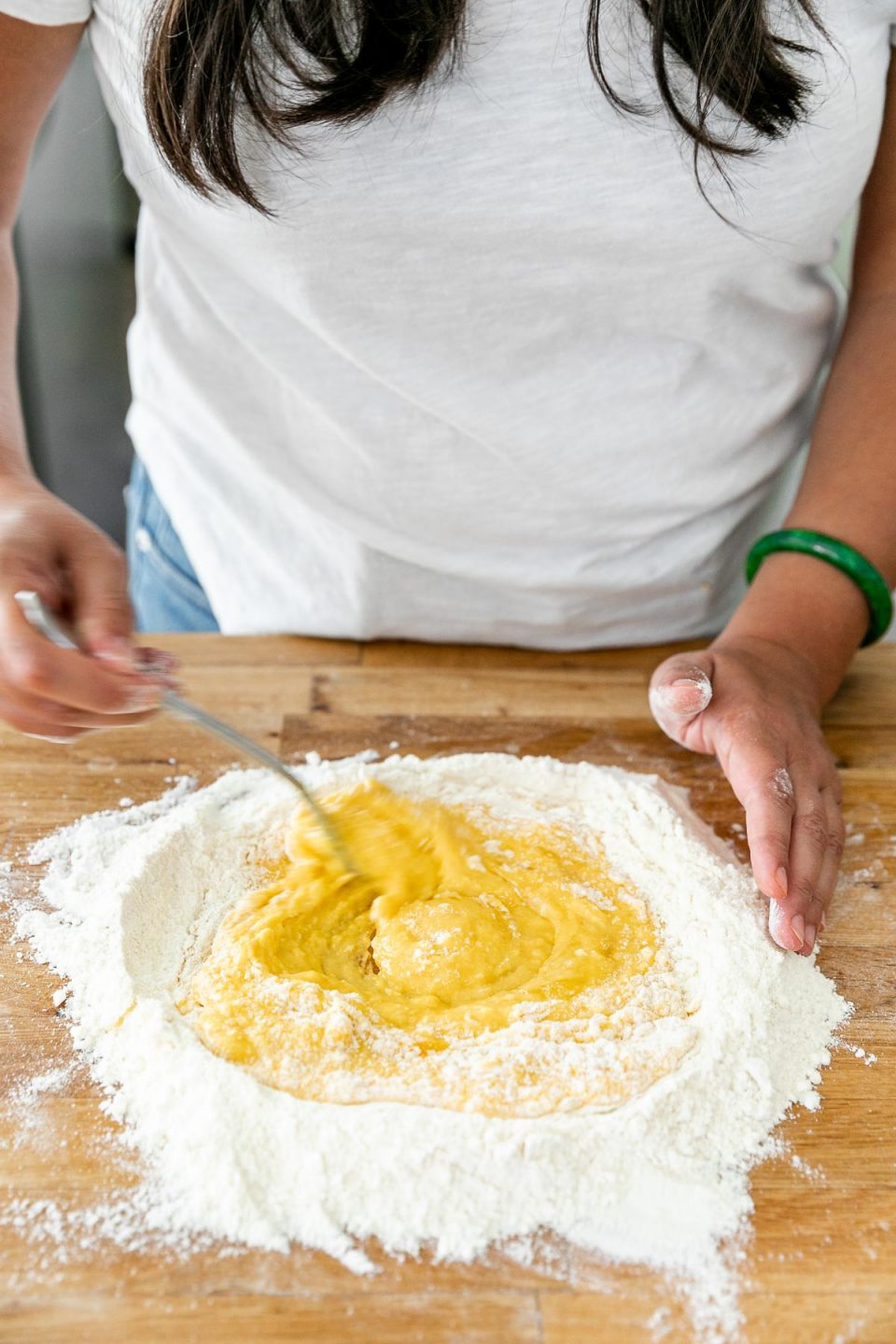
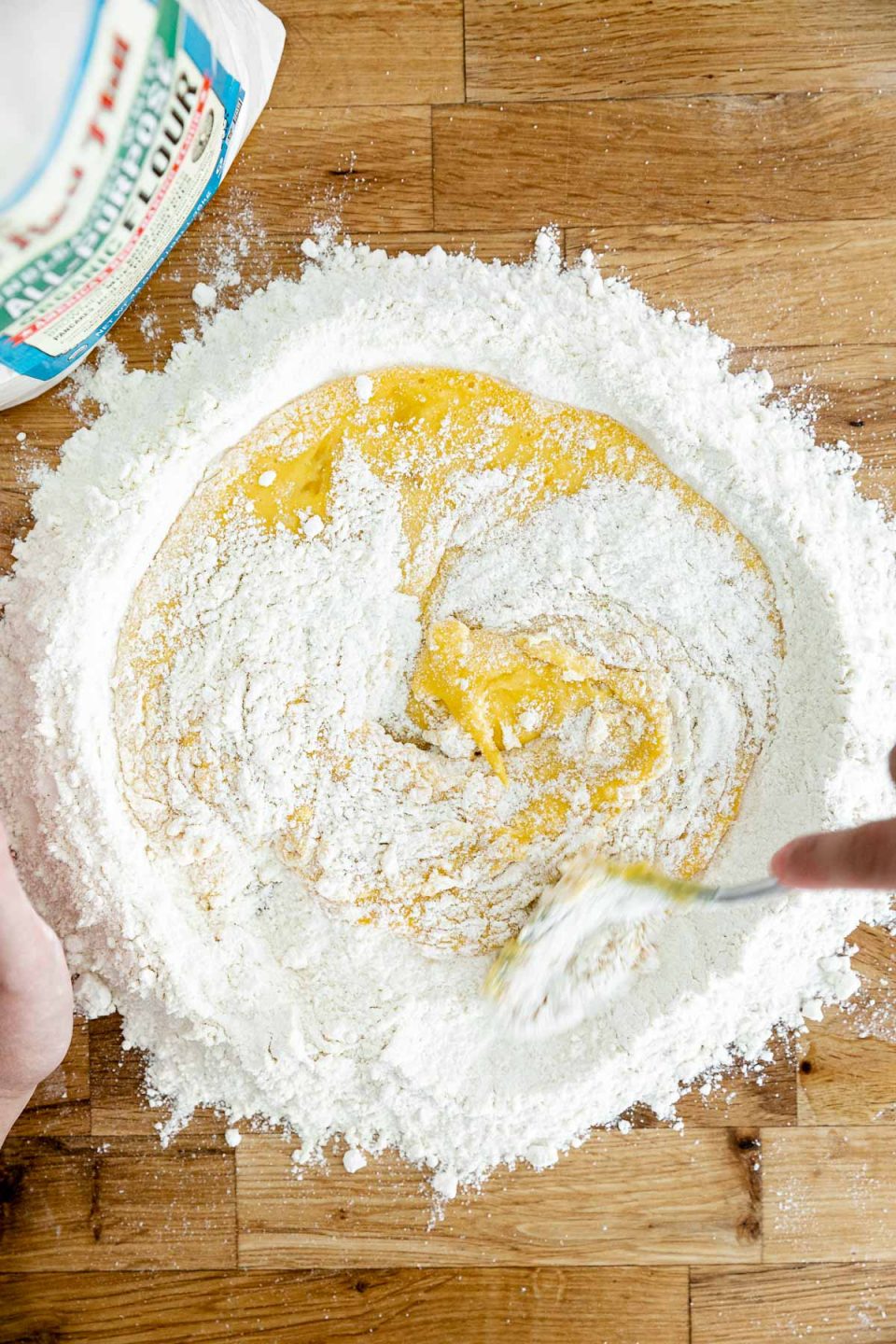
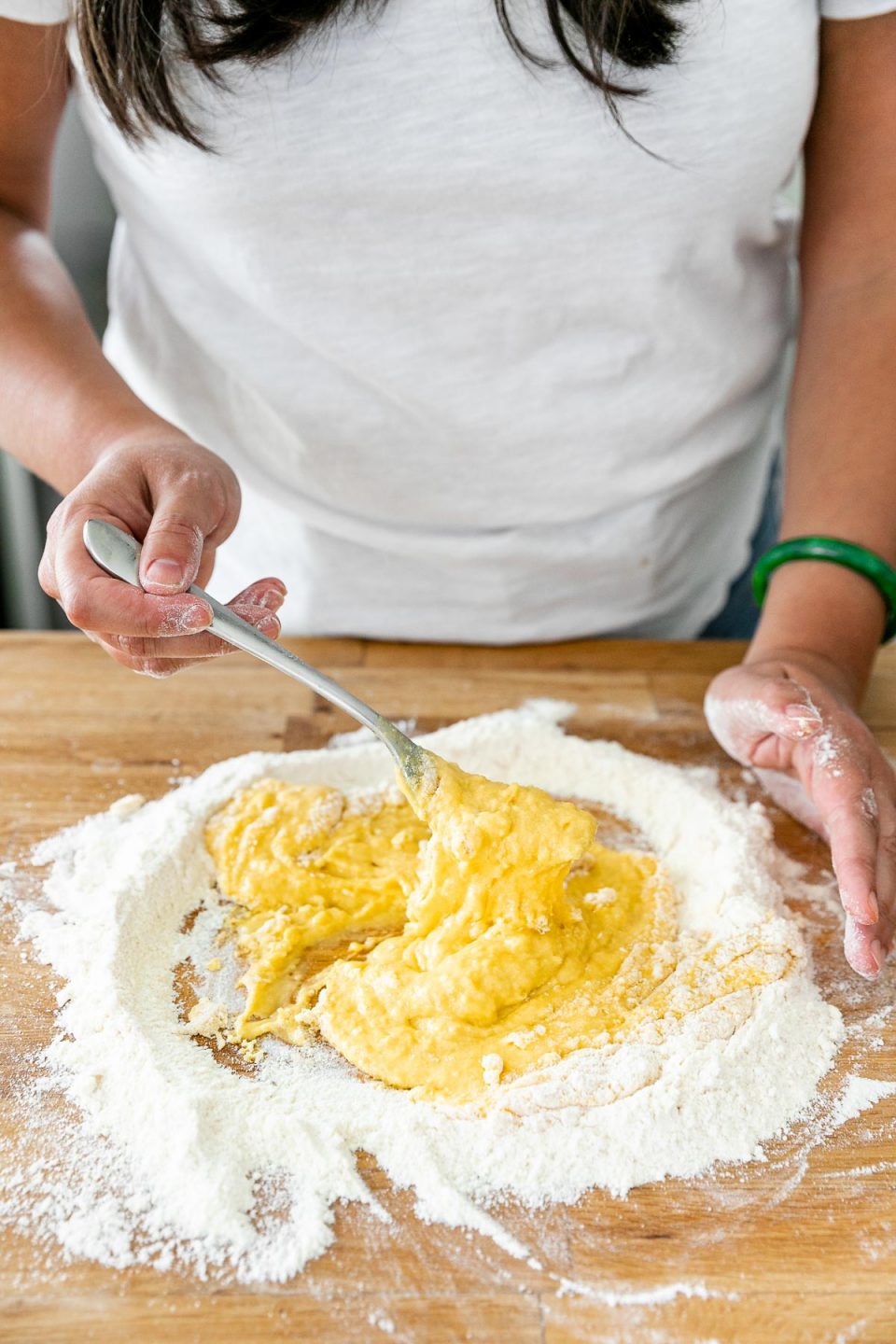
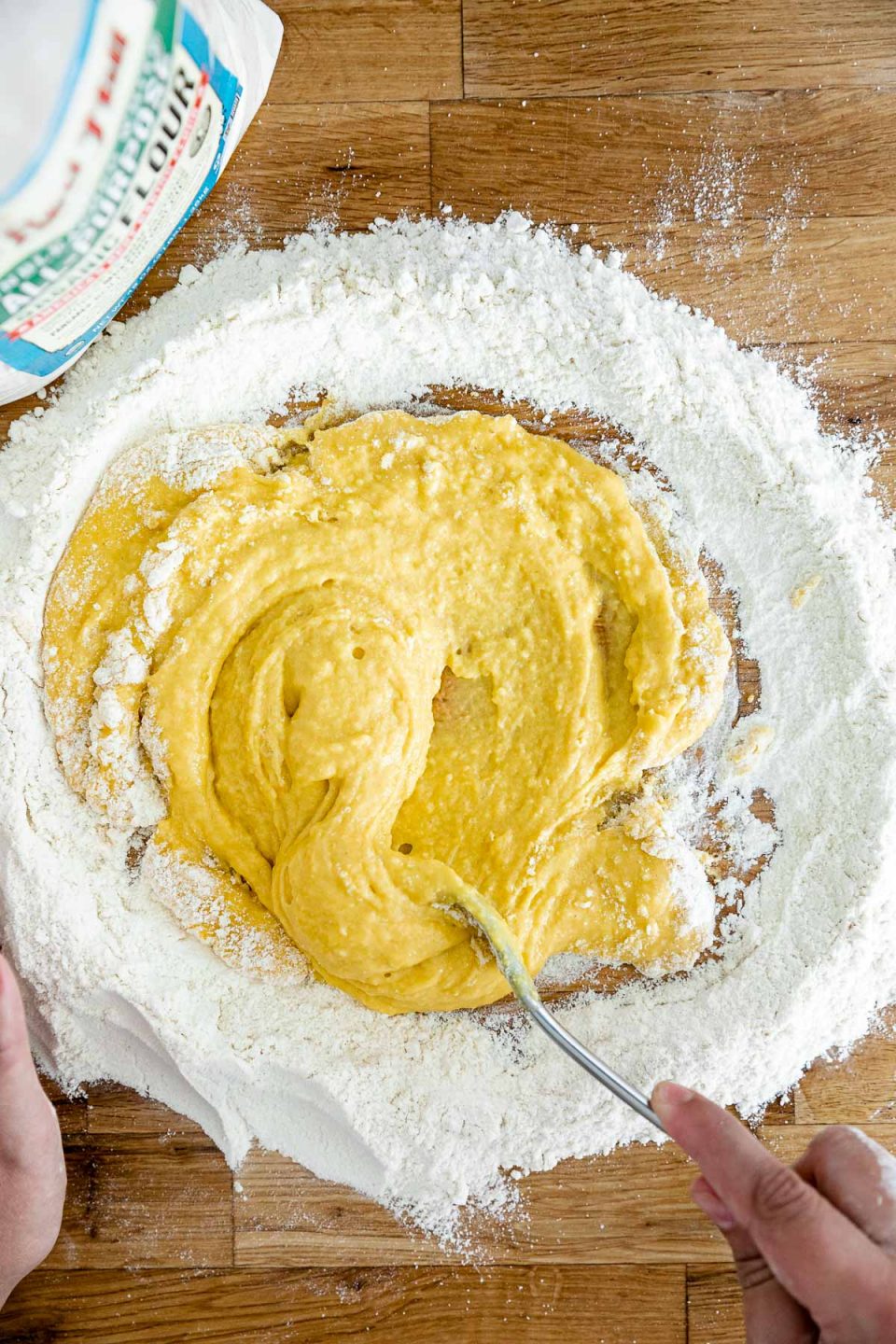
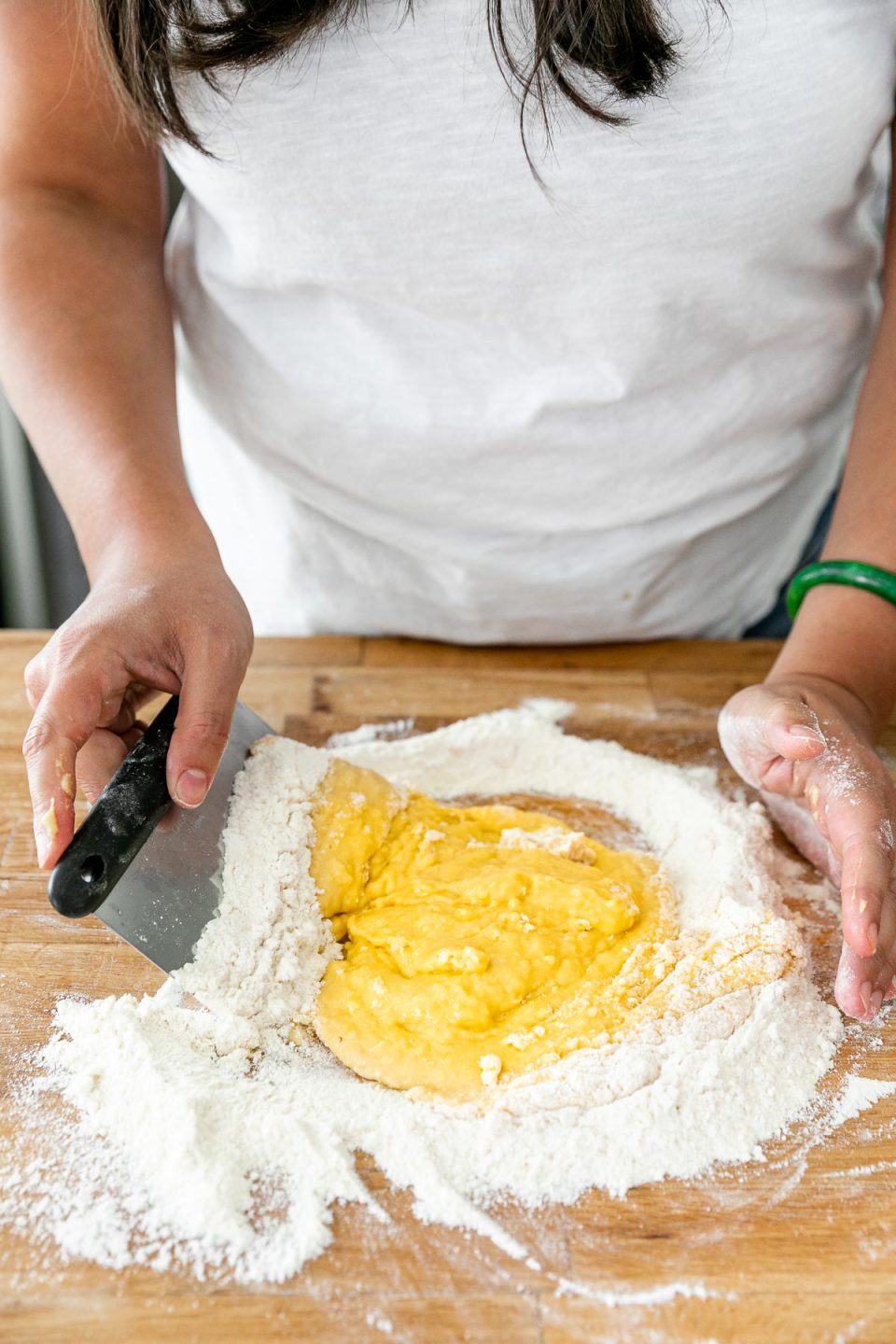
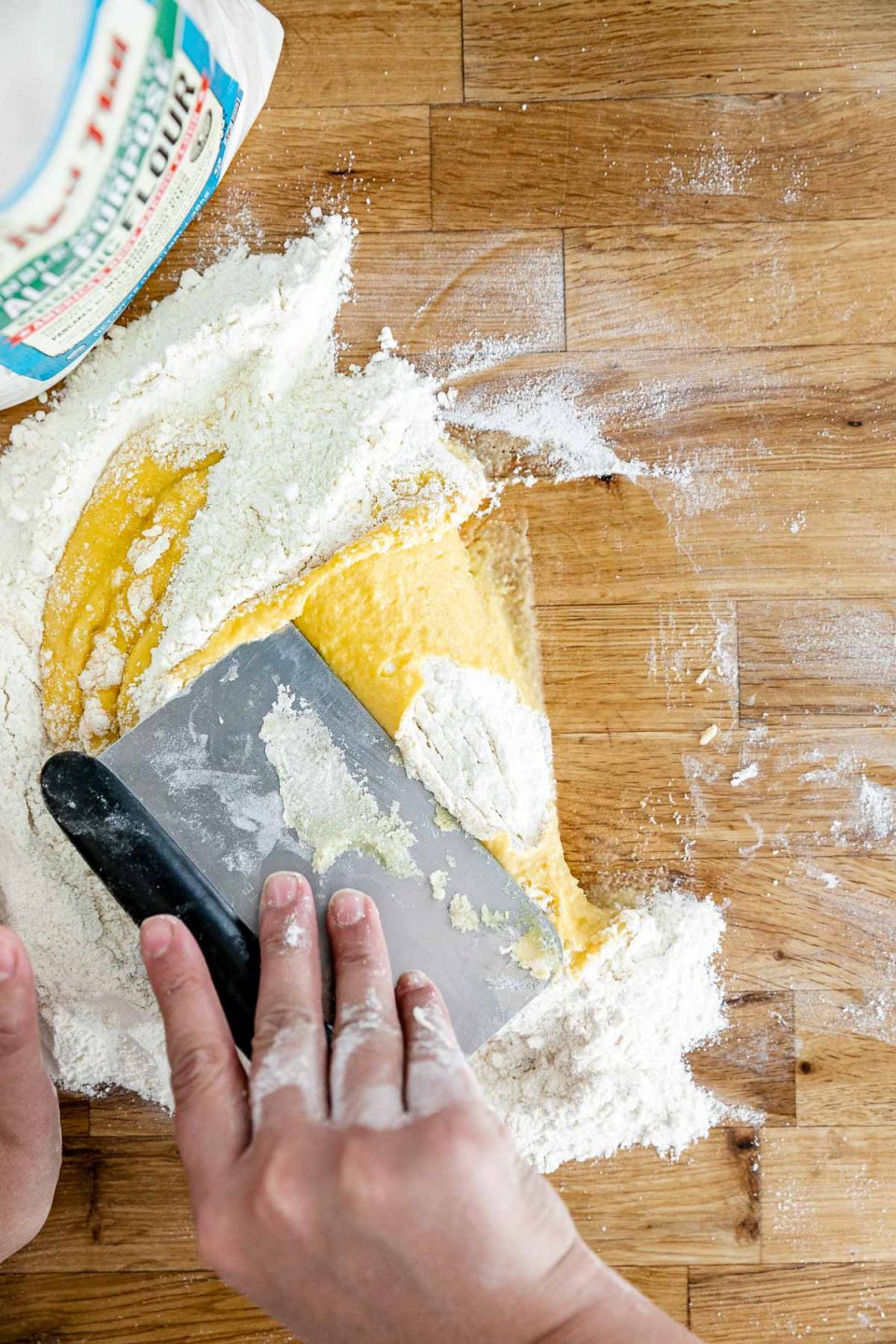
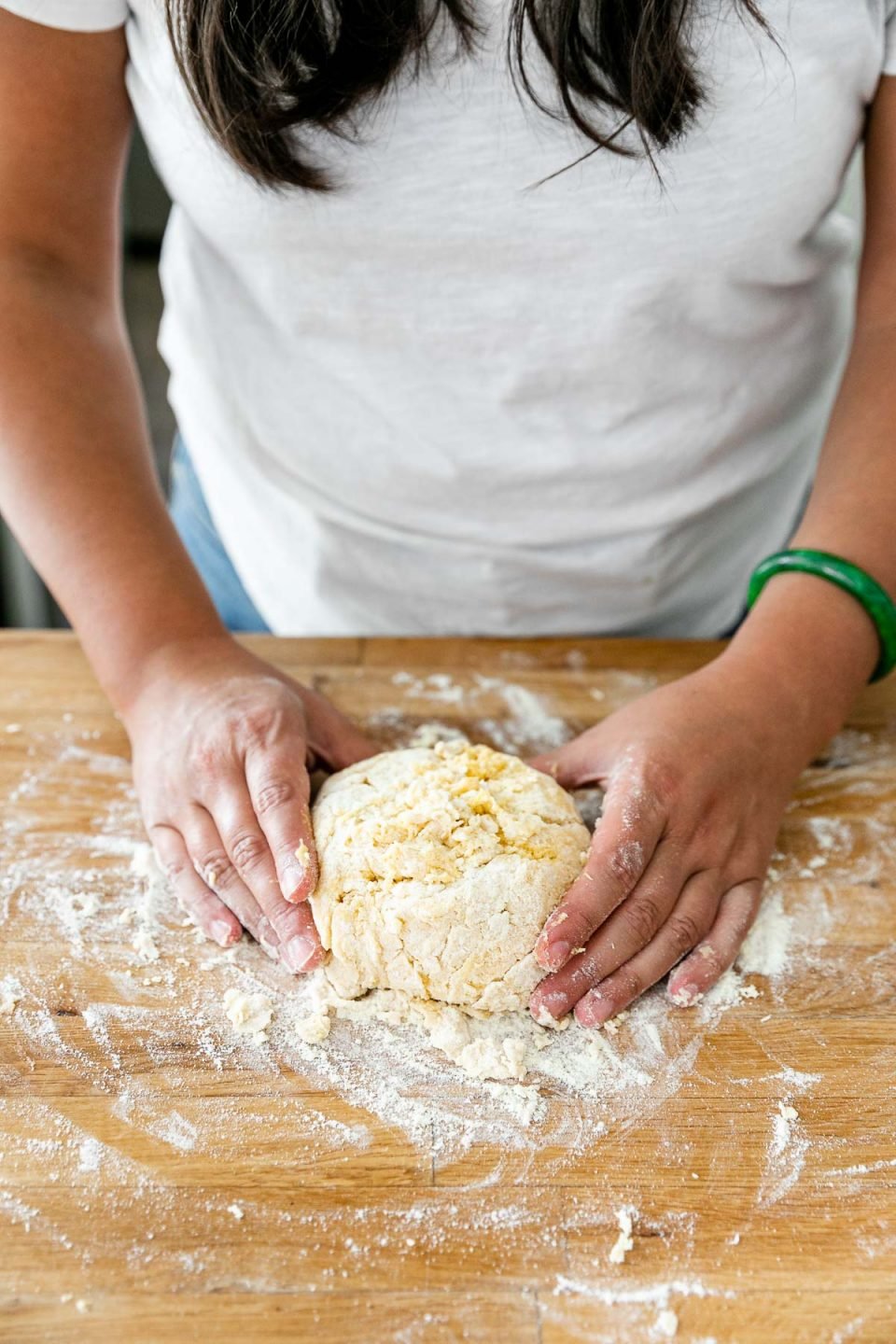
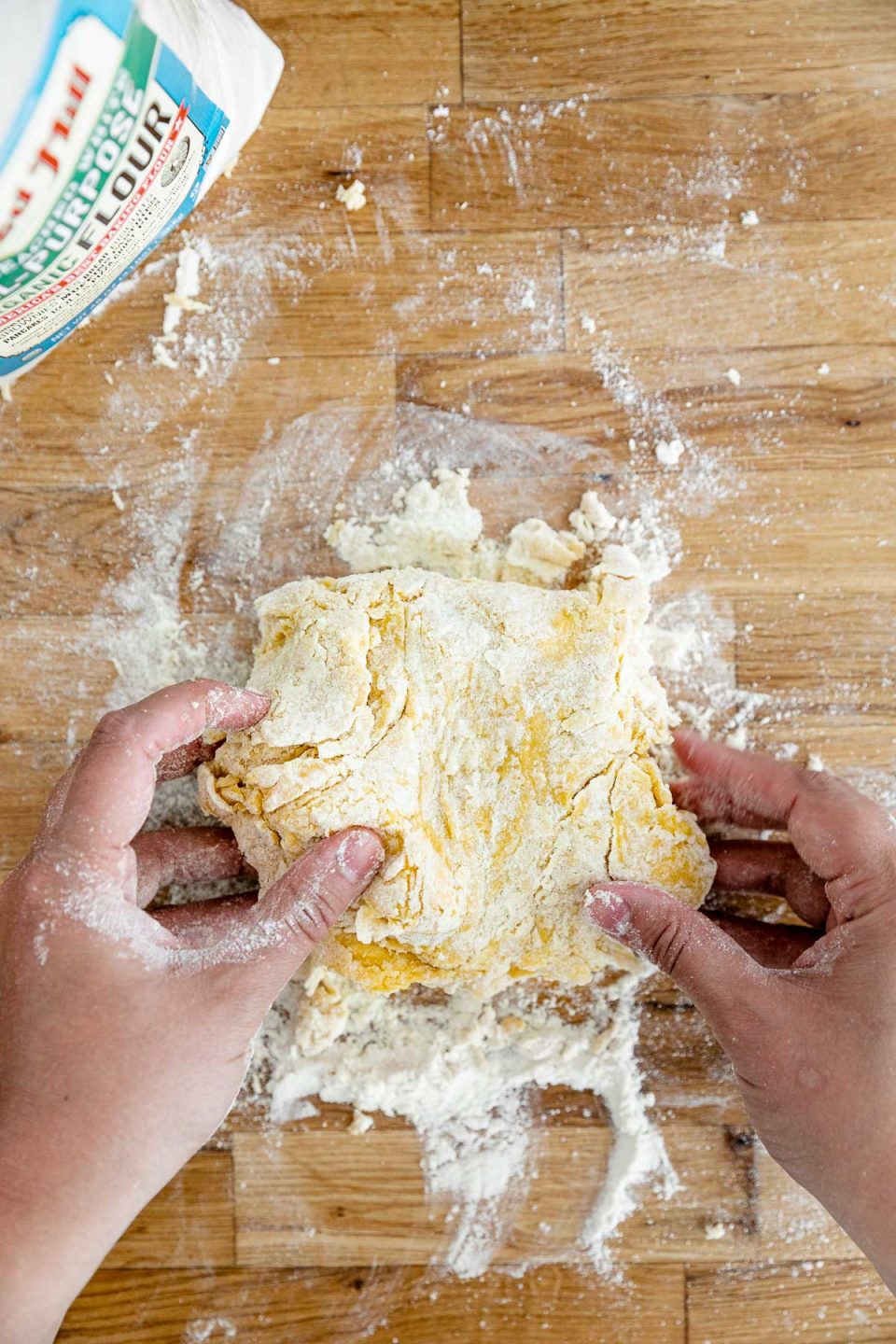
Full Recipe Directions, including step-by-step photos, included in the Recipe Card, below.
Knead the pasta dough:
Knead the pasta dough until it’s tight, tense, smooth, & supple. Be sure to really use your body weight to roll & stretch the dough but avoid tearing (as it breaks the glutens). You’ll know the dough is ready when you can press it with your finger & it bounces back quickly, about 10-12 minutes.
Why? ⇢ Kneading develops the glutens in the flour, creating homemade pasta with a beautiful springy, chewy texture.
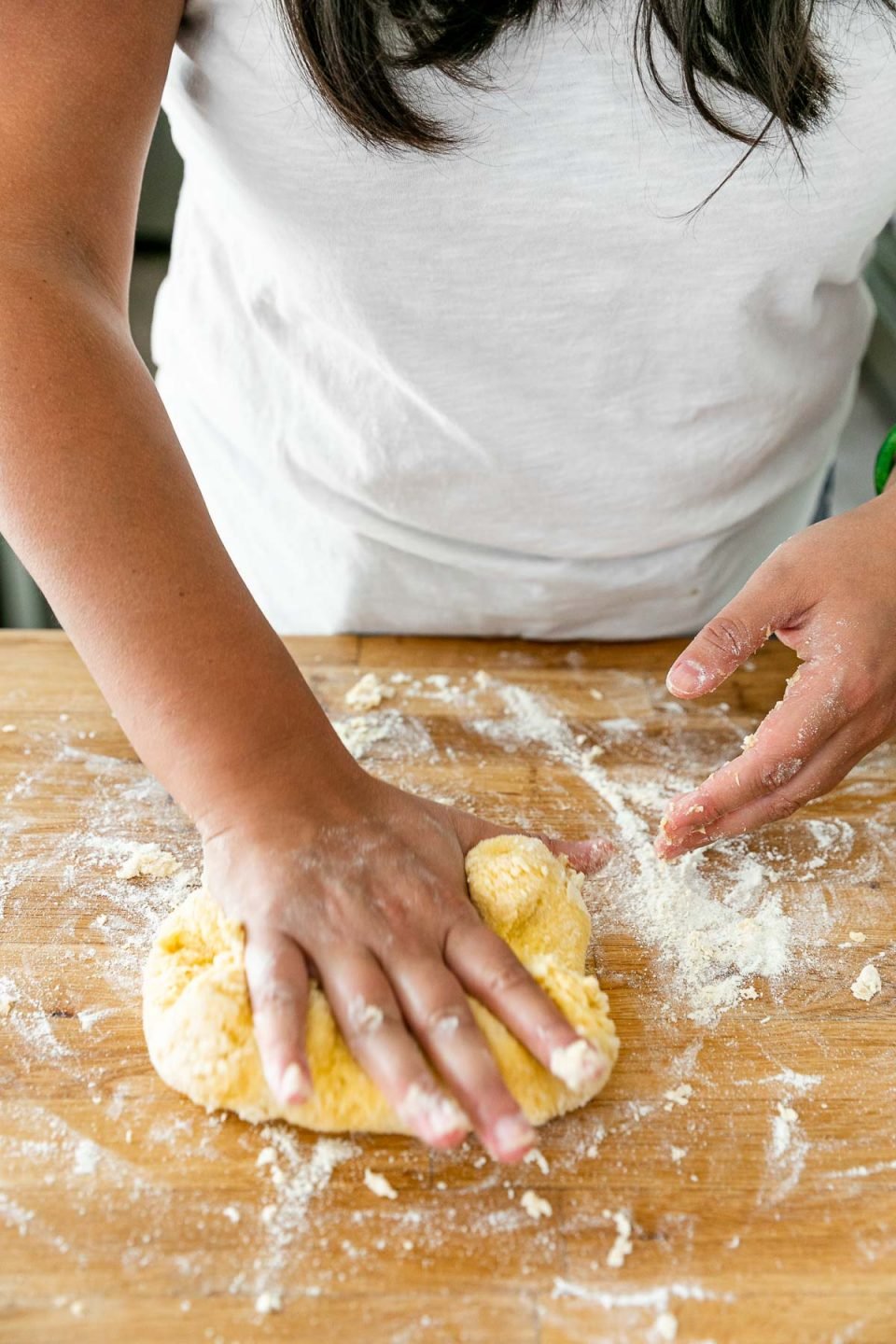
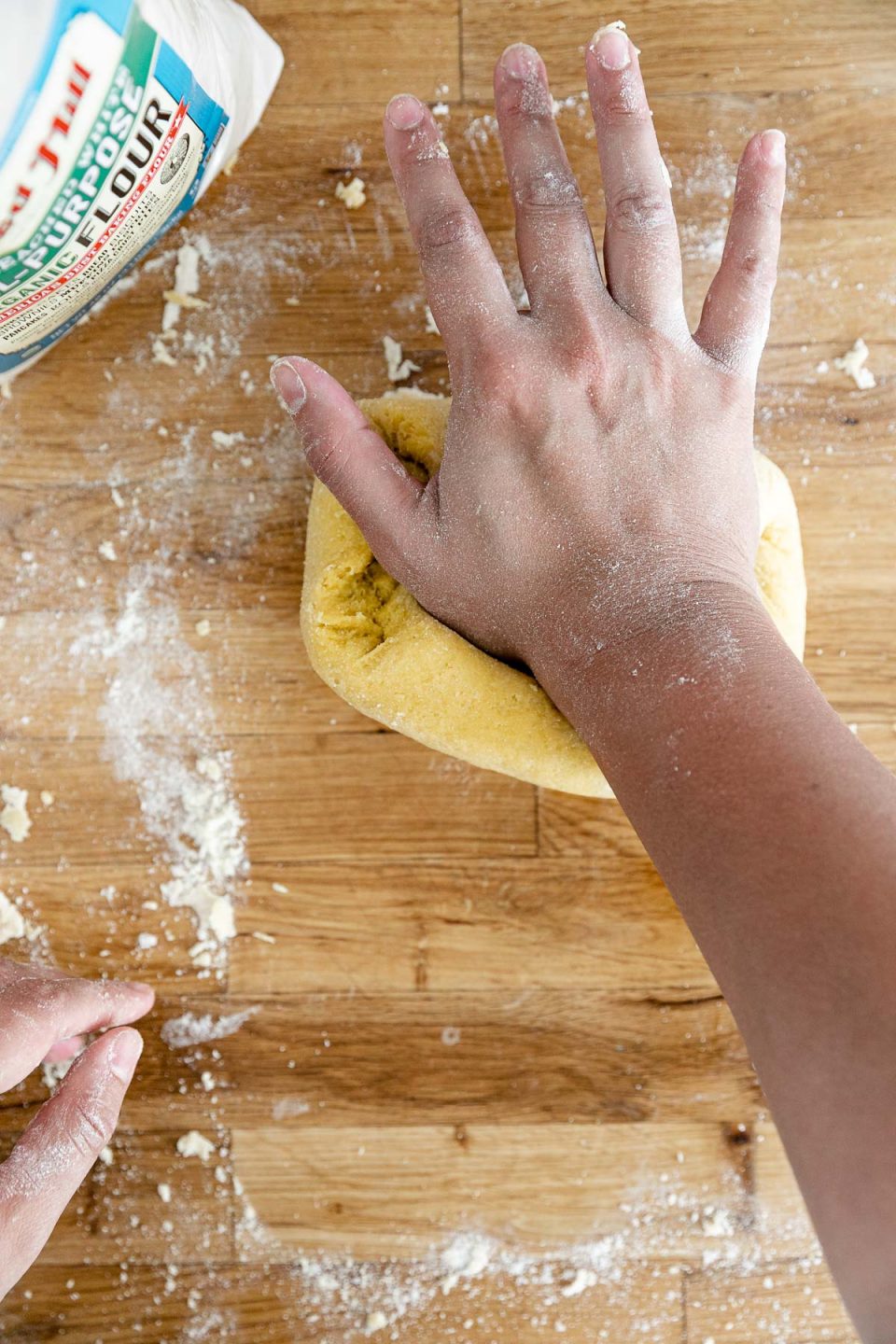

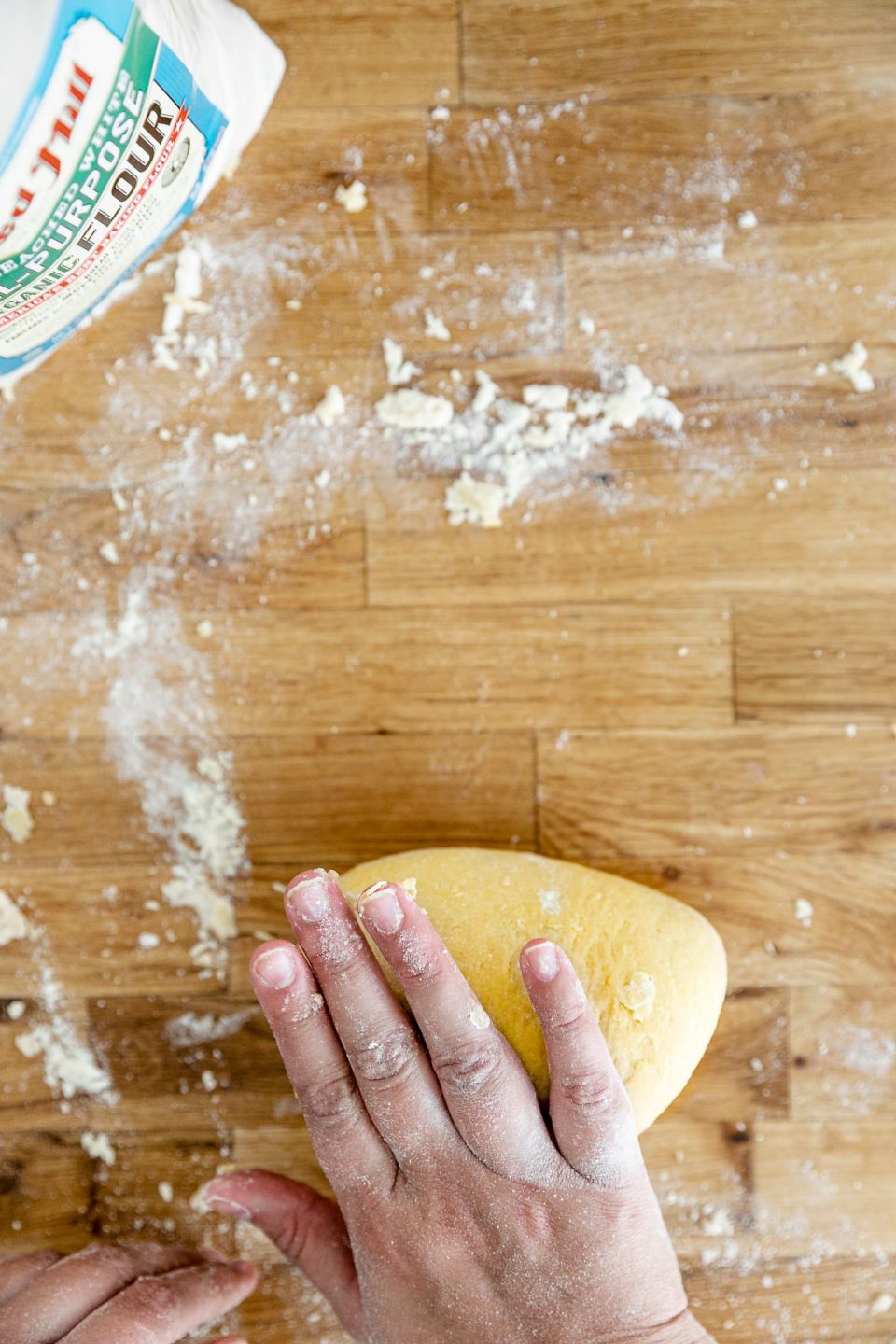
Full Recipe Directions, including step-by-step photos, included in the Recipe Card, below.
Rest:
Wrap the dough in plastic & set aside to rest for at least 1 hour.
Why? ⇢ A resting period allows all of the wonderful glutens developed in kneading to relax a little bit, making the homemade pasta dough much easier to roll out & cut for cooking.

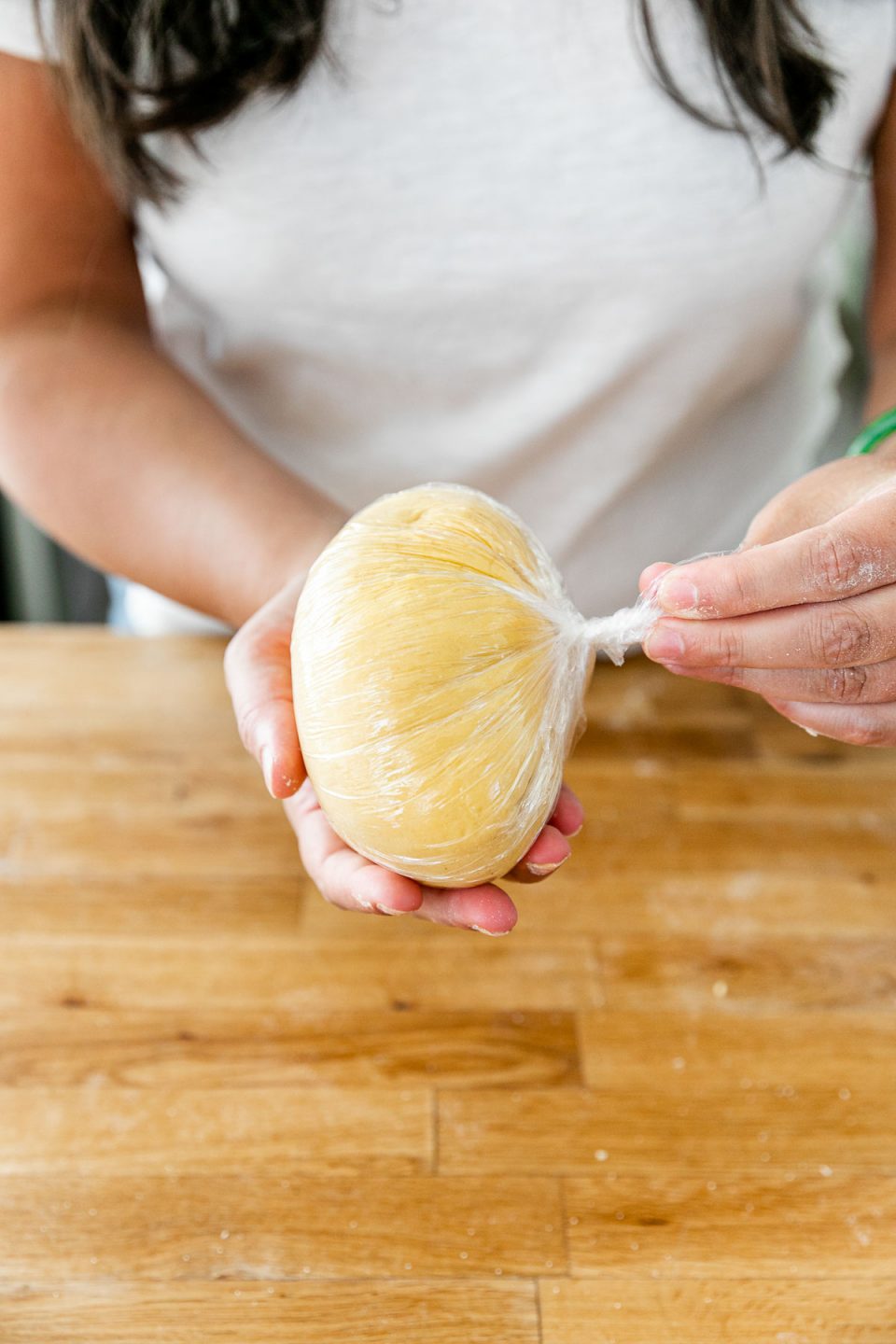
Full Recipe Directions, including step-by-step photos, included in the Recipe Card, below.
Tip! Make-Ahead Fresh Pasta Dough. ⇢ Once you’ve reached this point, your pasta dough will keep, wrapped tightly in plastic & stored in the refrigerator, for up to 1 day. Feel free to mix & knead your pasta dough up to 1 day in advance, allowing it to come up to room temperature for 30 minutes – 1 hour before rolling & cutting your pasta.
Shortcut Method – Kneading Homemade Pasta Dough in a Stand Mixer
As I developed this fresh pasta recipe, I realized that a KitchenAid or comparable stand mixer’s bowl provides a similar shape for creating a flour well to mix together homemade pasta dough. Using the stand mixer’s dough attachment, you can mix up great fresh pasta dough without the level of elbow grease required to knead it by hand.
Remember, kneading fresh pasta dough by hand allows for greater control of working & stretching the dough. This ultimately creates the chewy, springy texture we’re after here. While a stand mixer does a good job kneading the dough, this method results in fresh pasta that’s slightly less toothsome & slightly more tender. While mixing & kneading fresh pasta dough by hand is still my preference, this stand mixer method offers a slightly more approachable & less labor-intensive alternative. Not to mention, it still results in a pretty darn good batch of fresh pasta.
How to Mix & Knead Fresh Pasta Dough in a Stand Mixer:
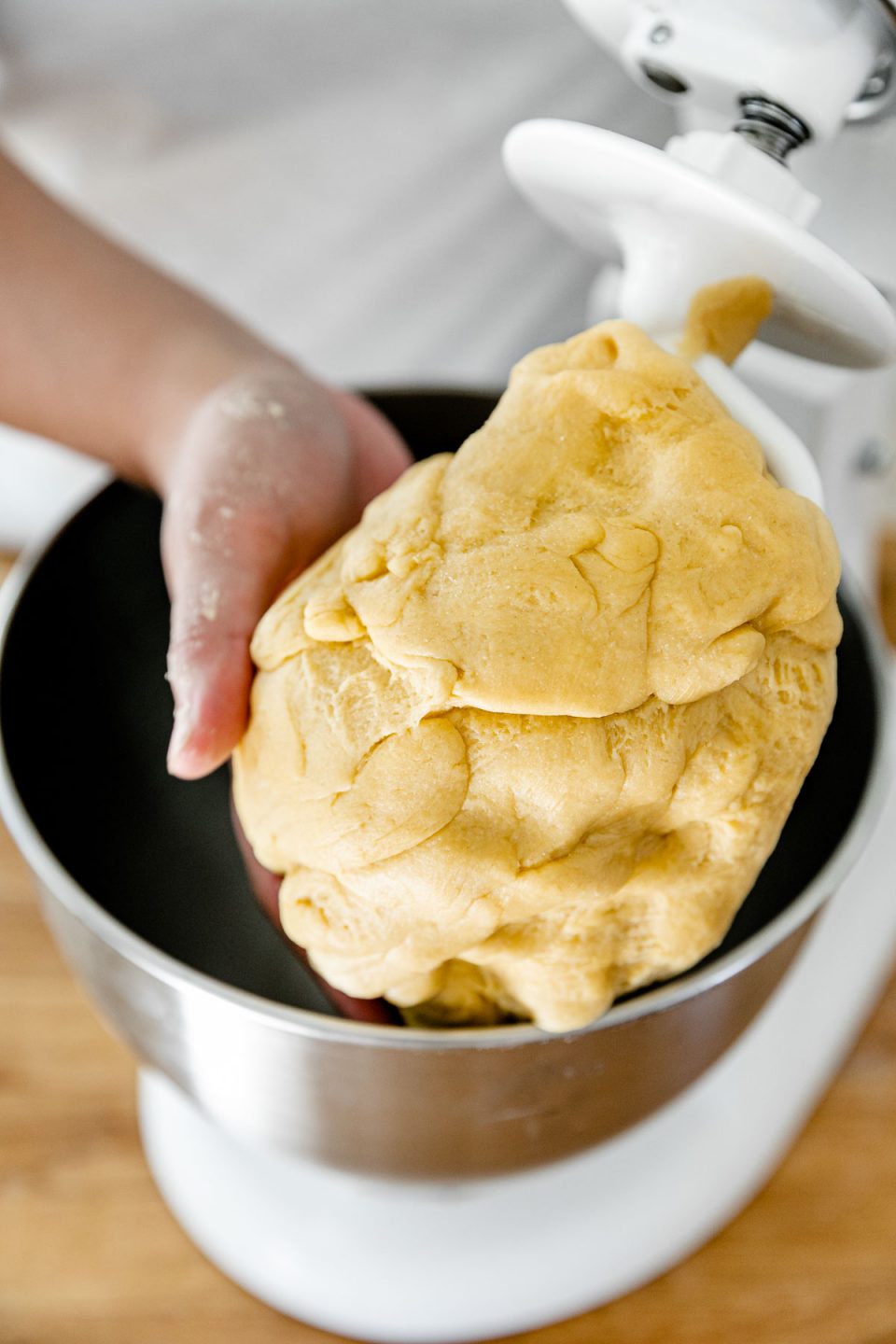
Create a flour well:
Add the flours to the bowl of a stand mixer fitted with its dough hook attachment & mix to combine. Create a well in the center; it needs to be large enough to contain all of the wet ingredients. Add the eggs, olive oil, & water in the prepared well. Run the mixer on low, allowing the dough hook to mix the wet ingredients.
Why? ⇢ The rotating dough hook emulates the traditional flour well technique, thoroughly mixing the wet ingredients & gradually pulling in the flours to create fresh pasta dough without lumps, bumps, or flour pockets.
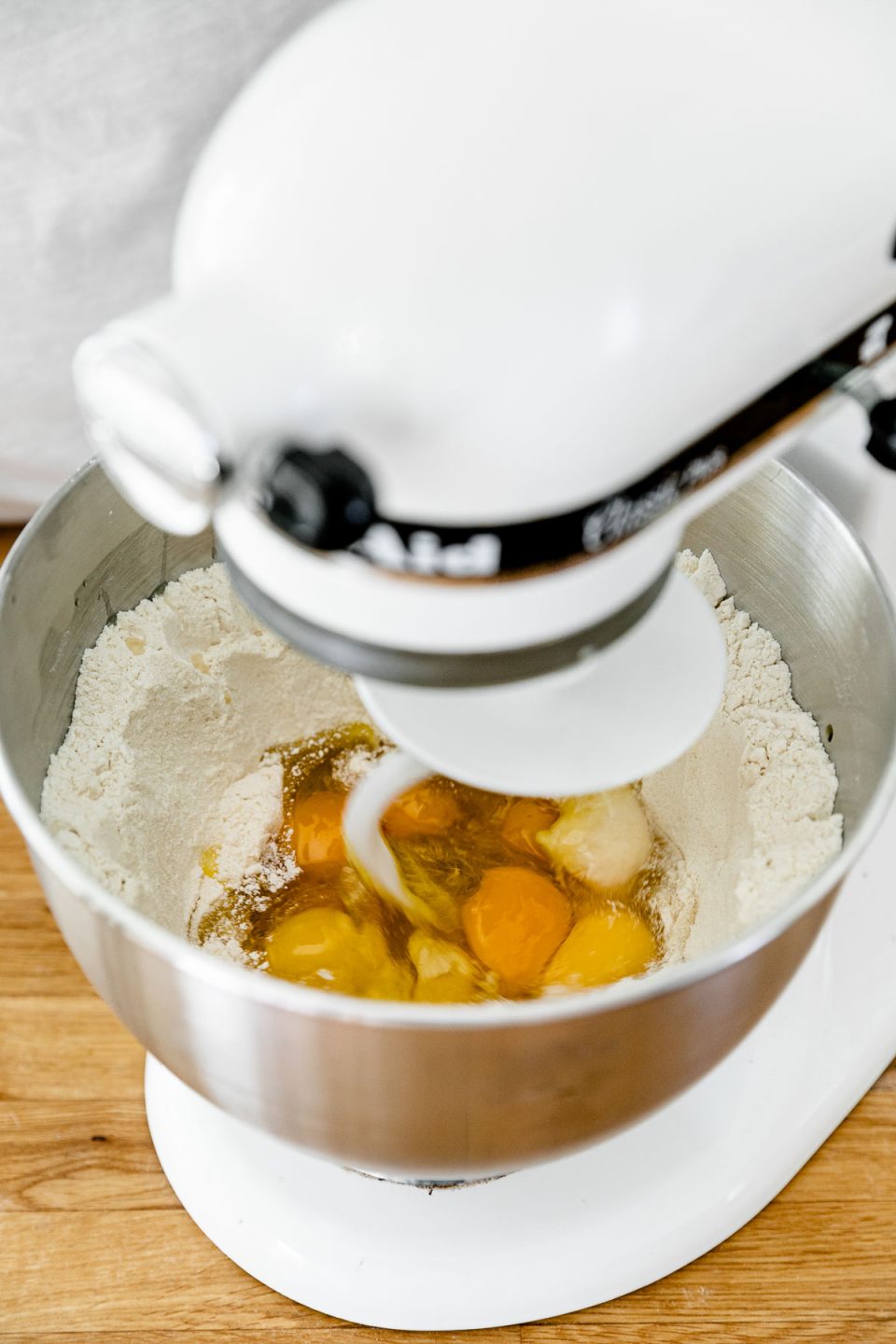
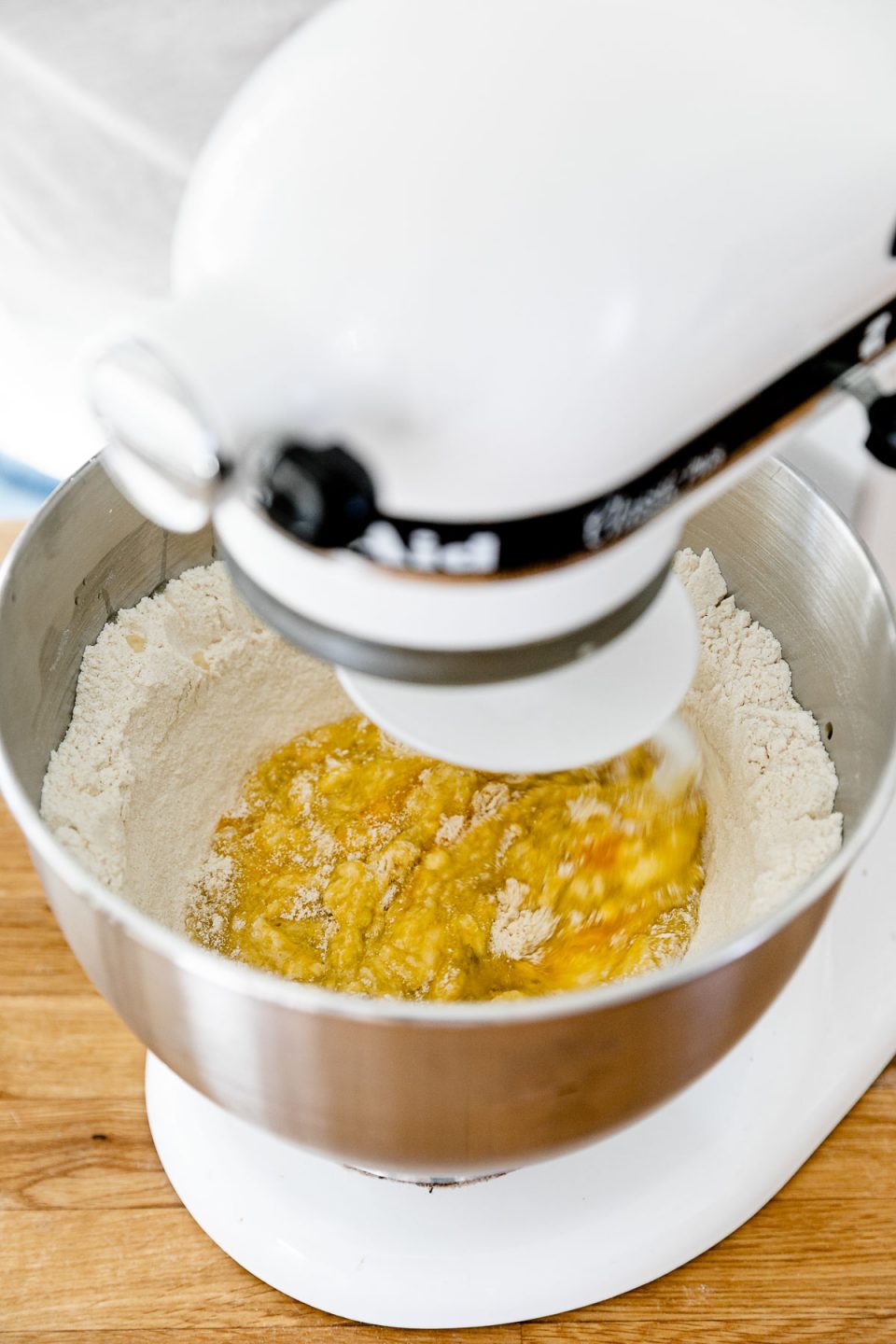
Full Recipe Directions, including step-by-step photos, included in the Recipe Card, below.
Continue to mix to knead the pasta dough:
Once a dough ball is formed, increase the mixer’s speed to medium & let it knead the dough for 8-10 minutes. The resulting dough should be smooth & supple, though it won’t be quite as tense & tight as it is when you knead it by hand.
Quick tips! ⇢ As the dough initially comes together into a shaggy ball, some flour may hang out at the bottom of the bowl. If so, simply shut off the mixer & use your hands to knead a few times, incorporating the loose flour into the dough. Note, the dough ball will be pretty sizable compared to the bowl – this is exactly what we want, as it allows the dough hook to really knead the dough against the side of the bowl. This can cause your mixer to shake a little bit as it kneads, so be sure to position the mixer a safe distance from the edge of your countertop to prevent it from walking off.
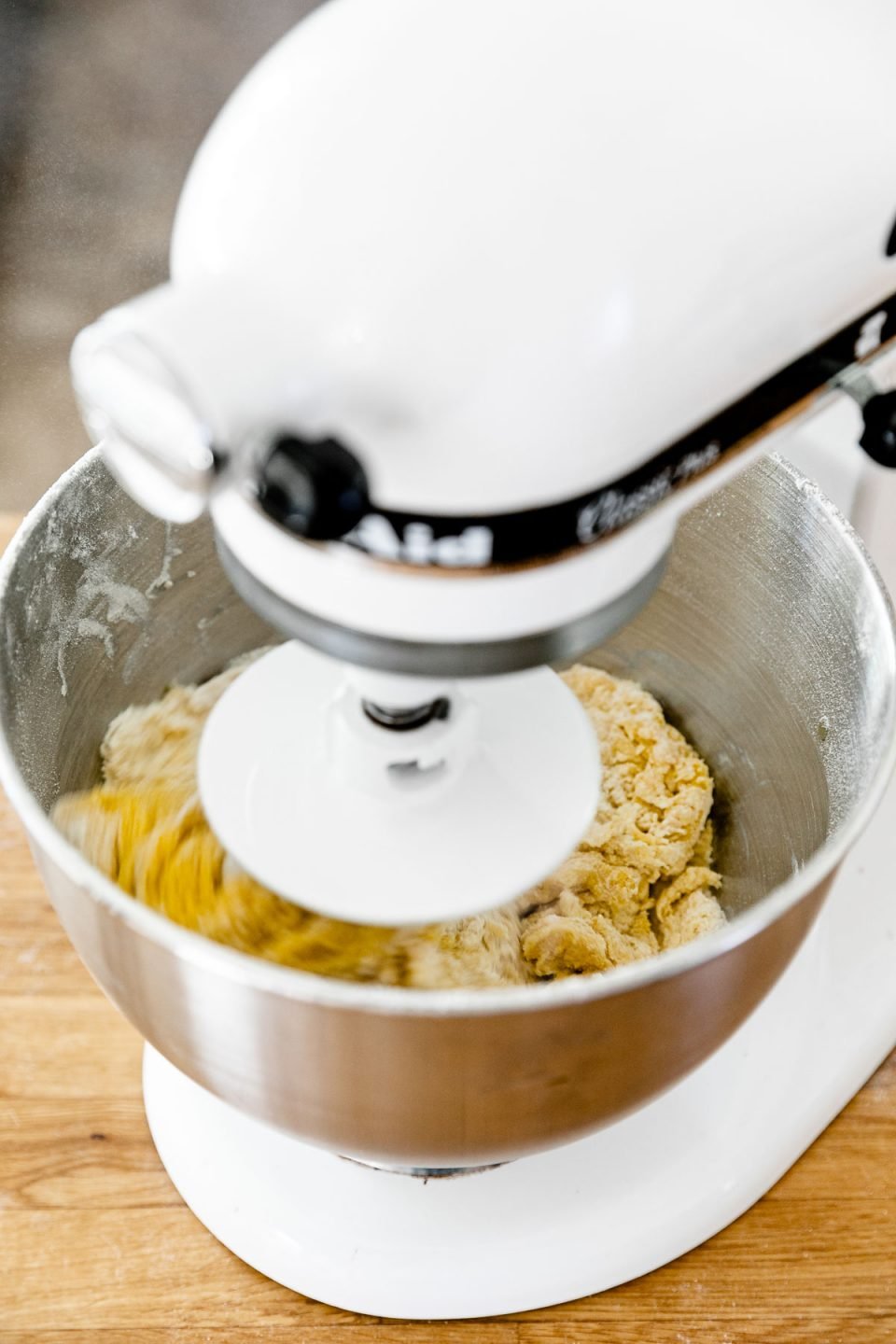
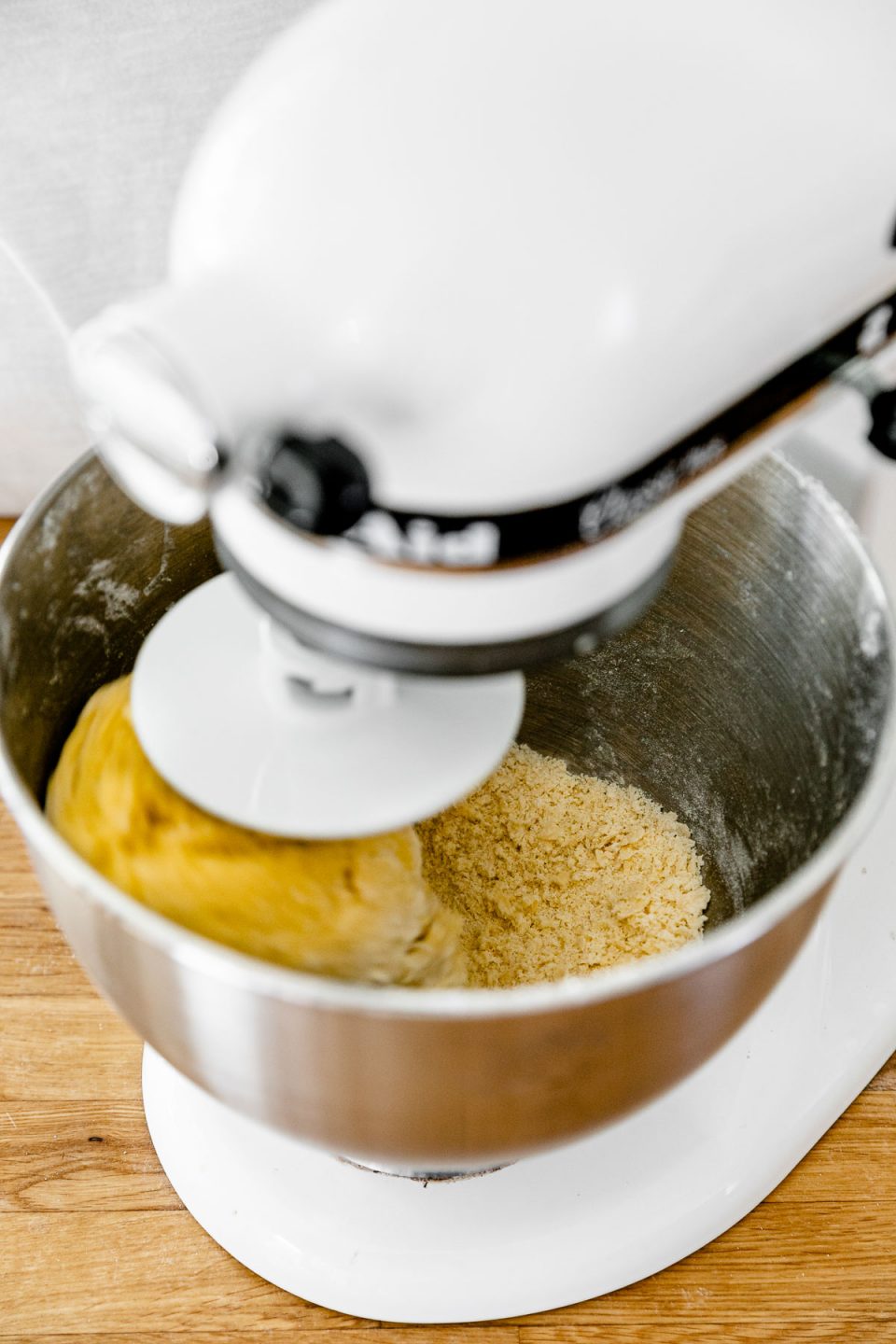
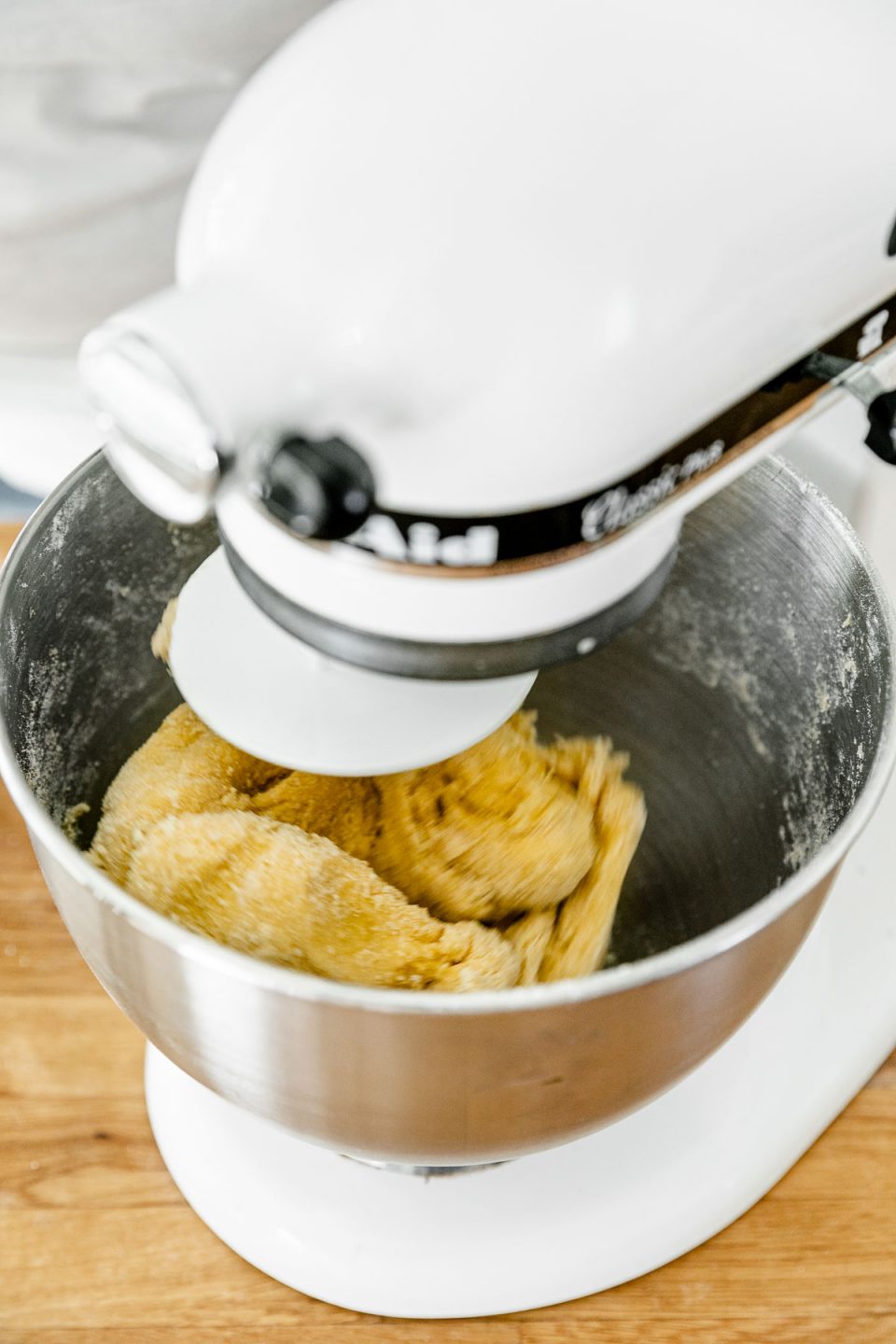
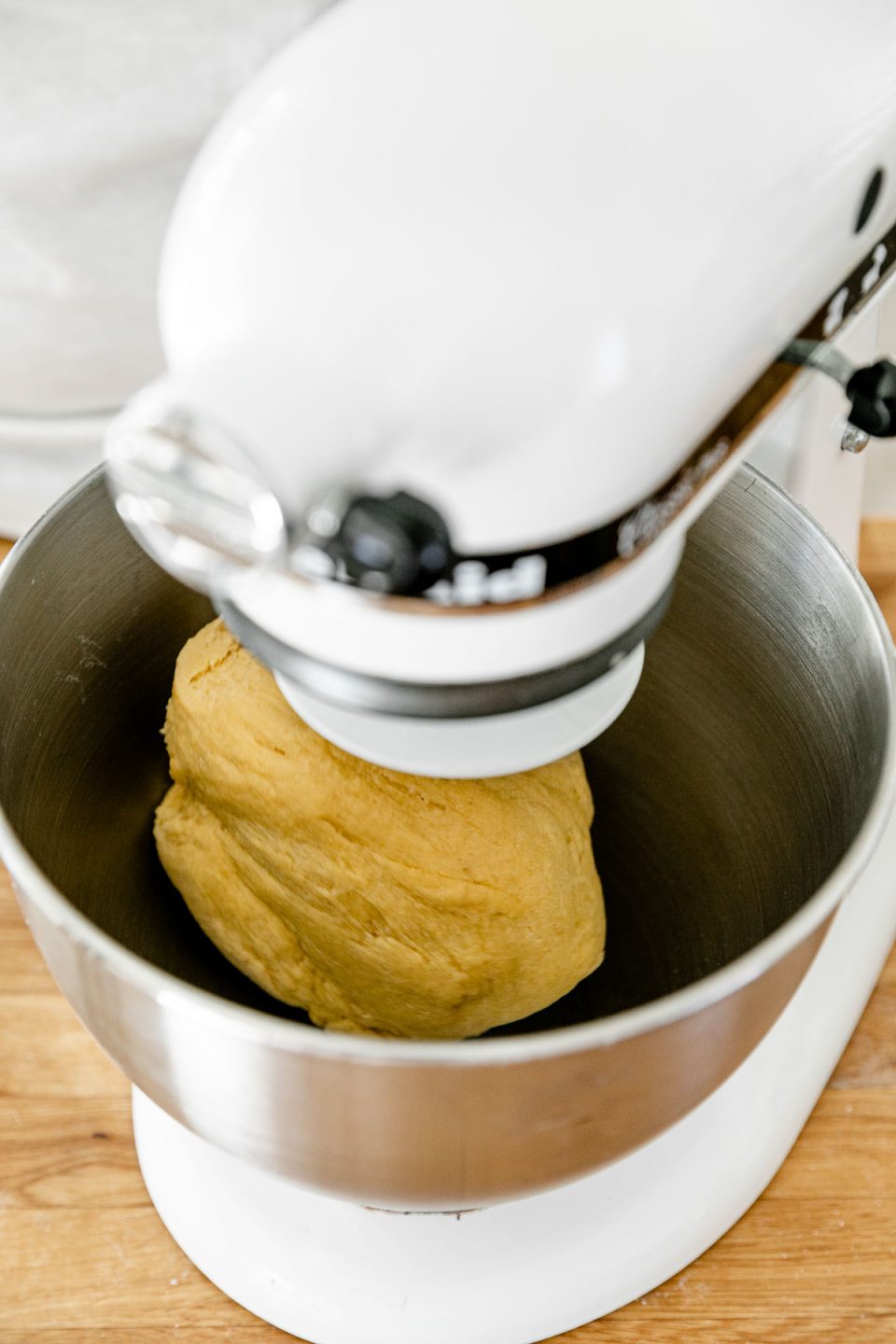
Full Recipe Directions, including step-by-step photos, included in the Recipe Card, below.
Rest:
Turn the pasta dough on a lightly floured surface & knead it a few times by hand, just to bring the dough together into a smooth ball. Wrap the dough in plastic & set aside to rest for at least 1 hour.
Why? ⇢ A resting period allows all of the wonderful glutens developed in kneading to relax a little bit, making the homemade pasta dough much easier to roll out & cut for cooking.
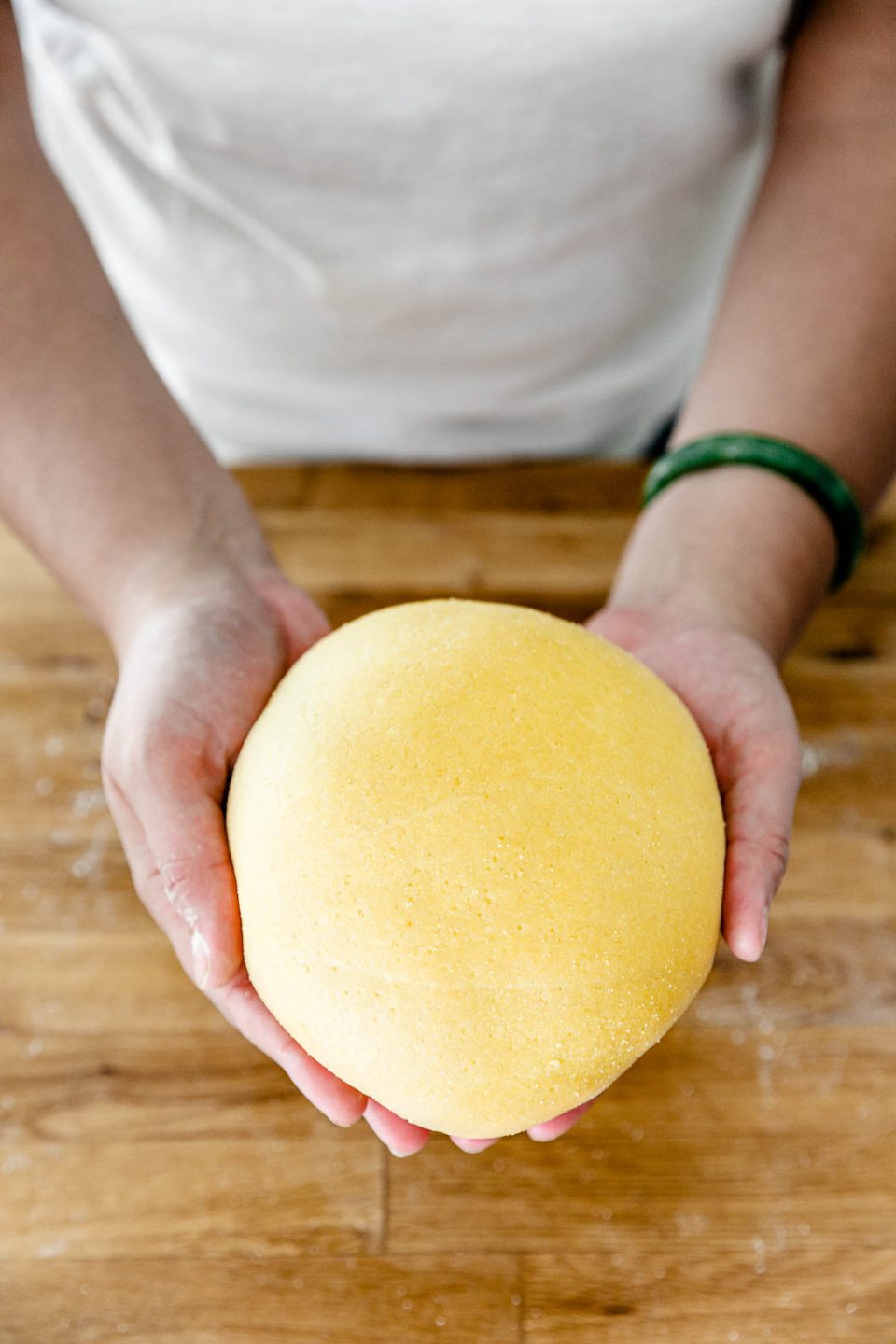

Full Recipe Directions, including step-by-step photos, included in the Recipe Card, below.
Tip! Make-Ahead Fresh Pasta Dough. ⇢ Once you’ve reached this point, your pasta dough will keep, wrapped tightly in plastic & stored in the refrigerator, for up to 1 day. Feel free to mix & knead your pasta dough up to 1 day in advance, allowing it to come up to room temperature for 30 minutes – 1 hour before rolling & cutting your pasta.
Fresh Pasta Dough FAQs:
As is the case in making any homemade dough, there are a number of variables that can affect your fresh pasta dough (the accuracy of your measurements, the weather & humidity in the air, etc.).
A few pasta dough tips & tricks to keep in mind:
- Troubleshooting – My homemade pasta dough is too wet! ⇢ Your pasta dough is too wet if it is sticky to the touch & doesn’t come together in a nice ball. Wet pasta dough is a nightmare to roll out since it sticks to everything it touches – your hands, the counter, the pasta rollers or rolling pins, etc. Fortunately, of all the problems you could have, this is the easiest one to fix! Working 1 tablespoon at a time, knead more flour into the dough until it’s barely tacky.
- Troubleshooting – My homemade pasta dough is too dry! ⇢ Your pasta dough is too dry if it tears easily as you knead it or if the edges crumble. Working 1 teaspoon at a time, knead more water into the dough until it’s barely tacky. The added moisture will make the surface of the dough ball really slippery & sticky at first, but it will smooth out as you continue to knead.
- Troubleshooting – How to tell when pasta dough is properly kneaded & ready to rest? ⇢ After 10-12 minutes of kneading, the surface of the dough will be totally smooth & supple, though the ball itself will be really tight & tense as a result of proper gluten development. Press it with your finger – if it bounces back quickly, the pasta dough is ready to rest.
Rolling Out & Cutting Fresh Pasta
Once you’ve let it rest, the homemade pasta dough is ready to be rolled & cut into fresh pasta. Rolling out the pasta dough gradually stretches it into long, thin sheet that can be used for lasagna or filled pastas (e.g. ravioli, tortelloni, mezzelune, agnolotti, etc.) or cut &/or shaped into smaller noodles (pappardelle, spaghetti, tagliatelle, farfalle, garganelli, etc.). You can roll out & cut fresh pasta by hand (with a rolling pin & knife) or make use of a machine for quicker, easier work.
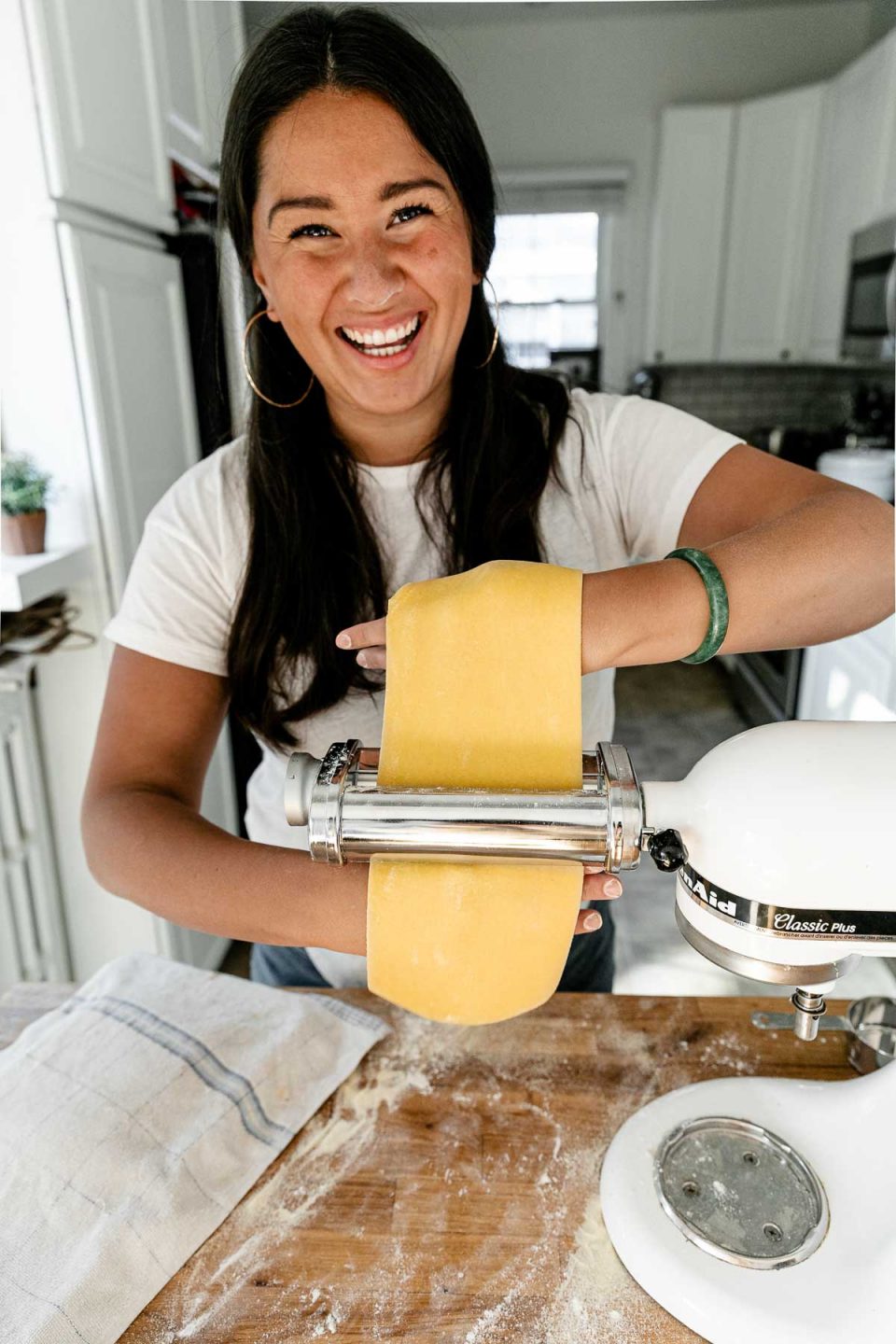
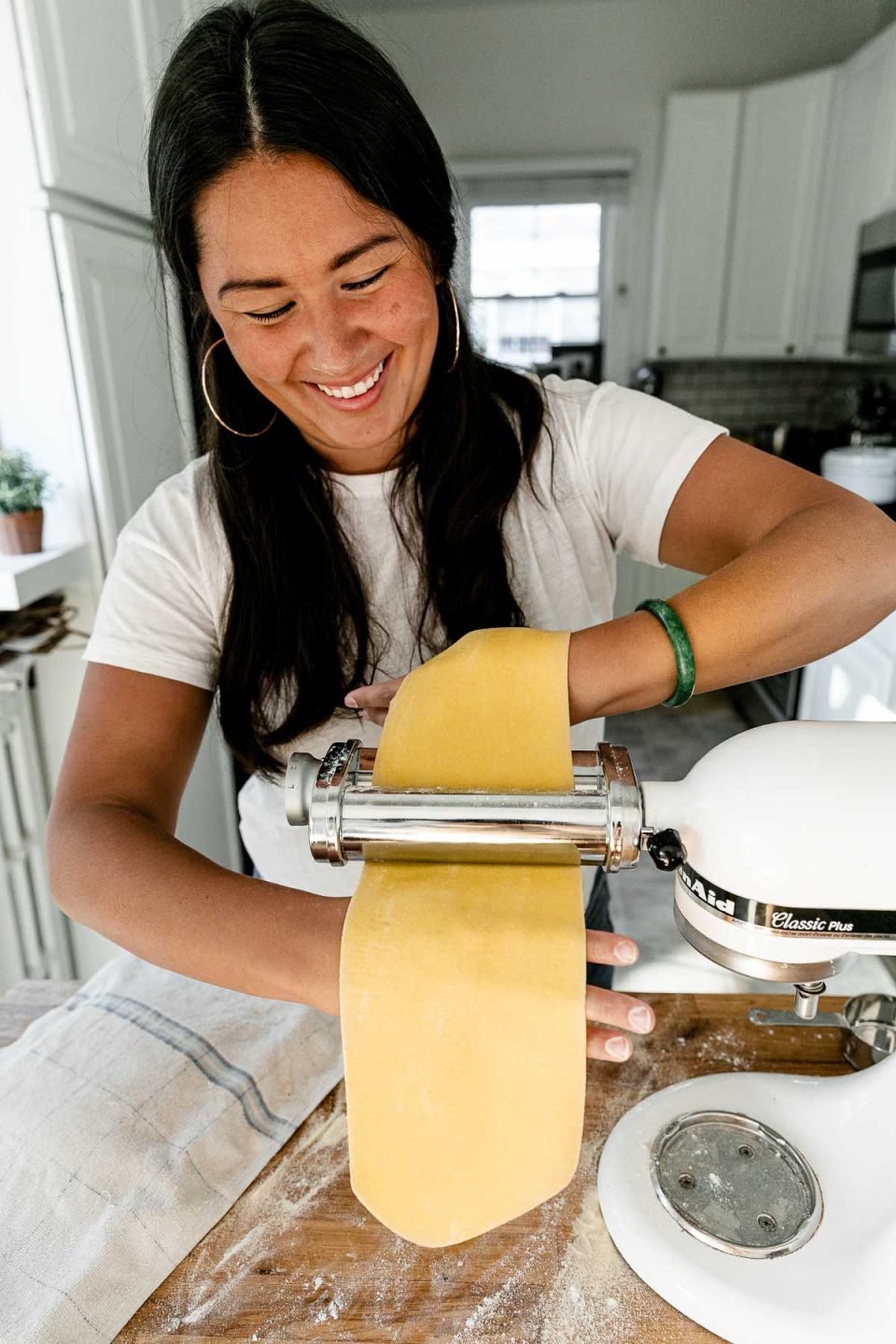
How to Roll Out Fresh Pasta by Hand:
Rolling out & cutting fresh pasta dough by hand is the most old school way to do it – you don’t need any special equipment (like a pasta machine or hand-crank roller), just a good ol’ rolling pin & a sharp knife. Disclaimer! ⇢ This method is quite labor-intensive, takes a long time, & can result in fresh pasta with inconsistent thickness. For best results, I definitely suggest investing in a pasta roller – they make a world of difference!
Rolling out Fresh Pasta Dough with a Rolling Pin:
- Roll out the pasta dough with a rolling pin: Divide your fresh pasta dough into 2 pieces. Lightly dust your work surface, a rolling pin, & a section of fresh pasta dough with flour. Use your bodyweight to roll the dough as thinly & evenly as possible. Because you did such a great job developing its glutens, the dough will want to snap back into a smaller shape as you roll it, so be patient & persistent! If the dough gets sticky, simply dust everything with a little more flour & keep at it until the sheet of pasta reaches your desired thickness. Repeat the process with the remaining fresh pasta dough.
- Cut the pasta with a sharp knife: Once all of the pasta is rolled, cut as desired. Leave the sheets whole for lasagna or filled pastas or use a sharp knife to cut into noodles (e.g. pappardelle, spaghetti, fettuccini, tagliatelle, etc.). Generously dust the cut pasta with semolina flour & cover with a kitchen towel until you’re ready to boil it.
How to Roll Out Fresh Pasta with a Pasta Roller:
While you can make homemade pasta without any special equipment or machines, rolling out pasta by hand is labor-intensive & a pasta roller will make a world of difference. I invested in these pasta attachments for my KitchenAid mixer, which I absolutely love. Since the motor of the KitchenAid does all of the cranking, they make rolling out fresh pasta dough so much easier. The attachments are an investment, but I couldn’t recommend them more – especially if you’re really interested in making homemade pasta with any sort of regularity. If you’d like to start with something a little smaller, hand crank pasta machines are great – I’ve used this hand crank pasta roller with great results (& it’s only $40!).
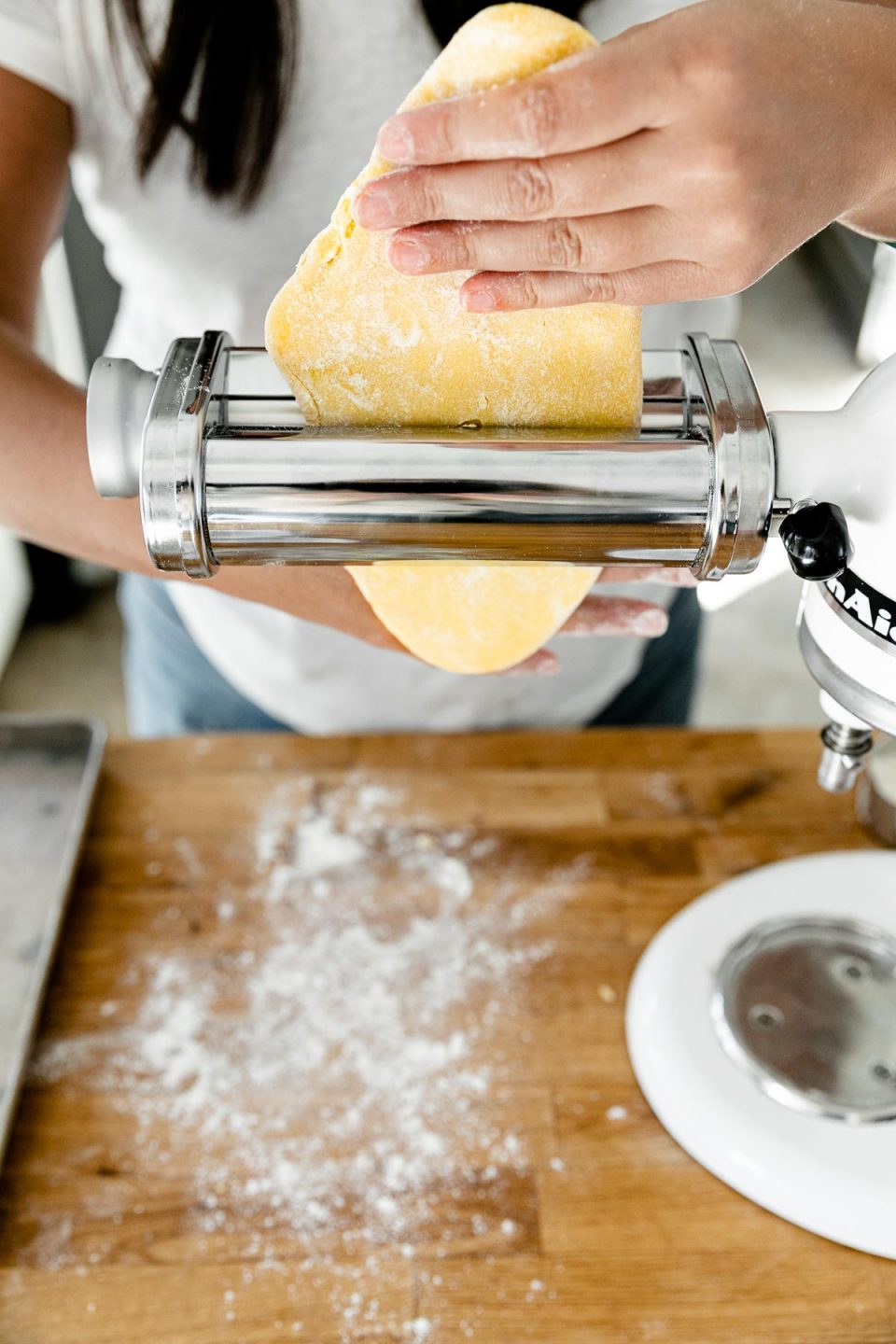
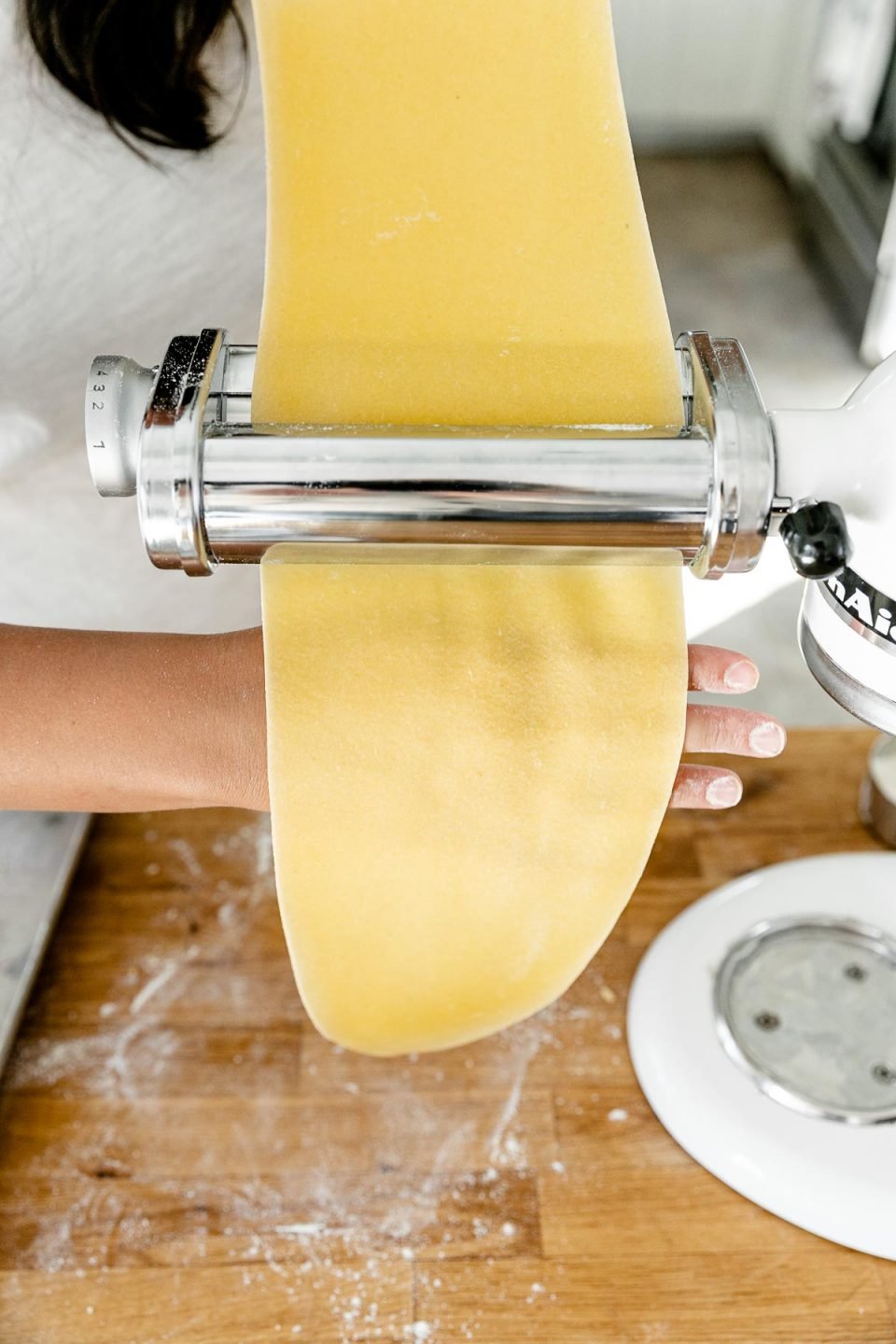
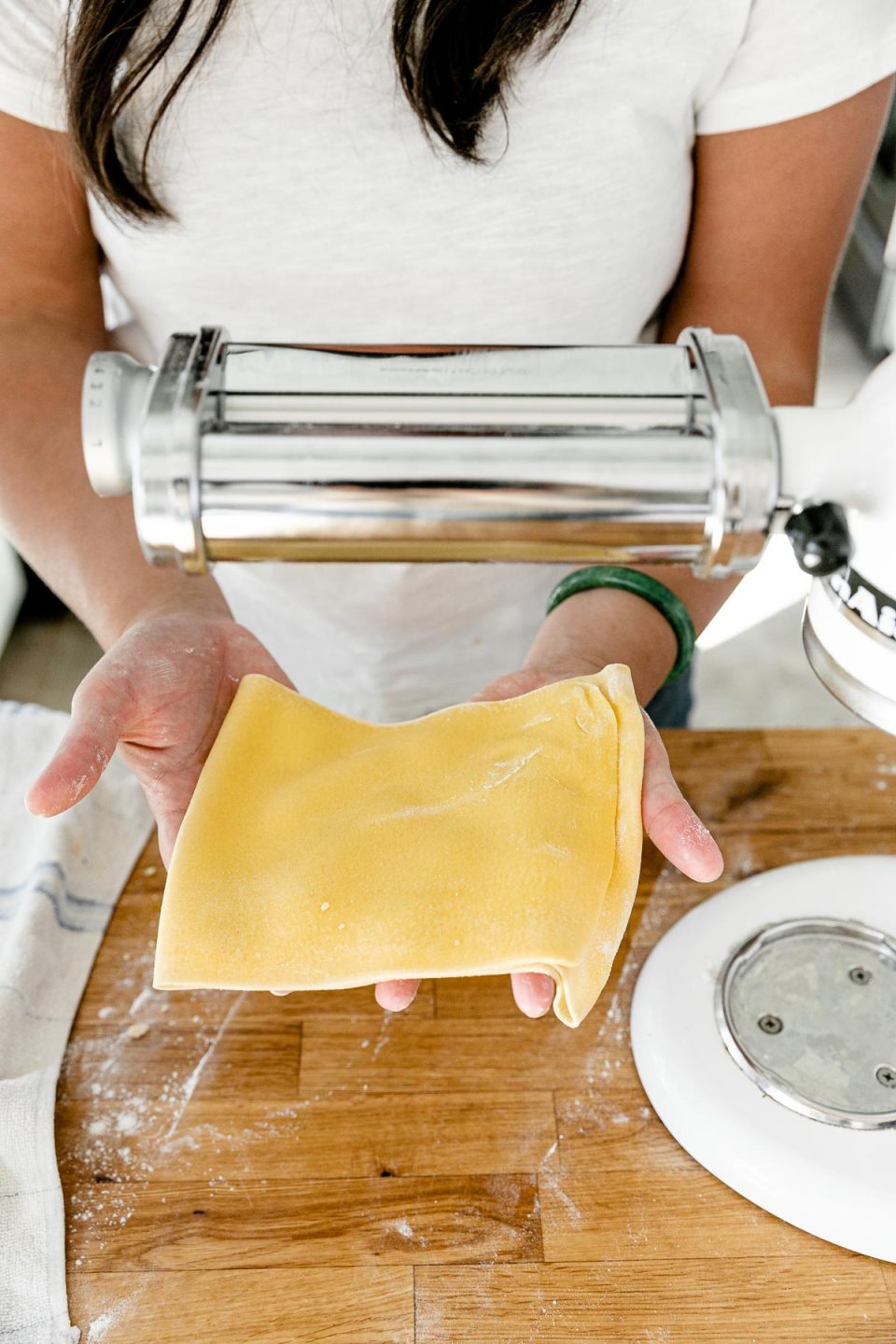
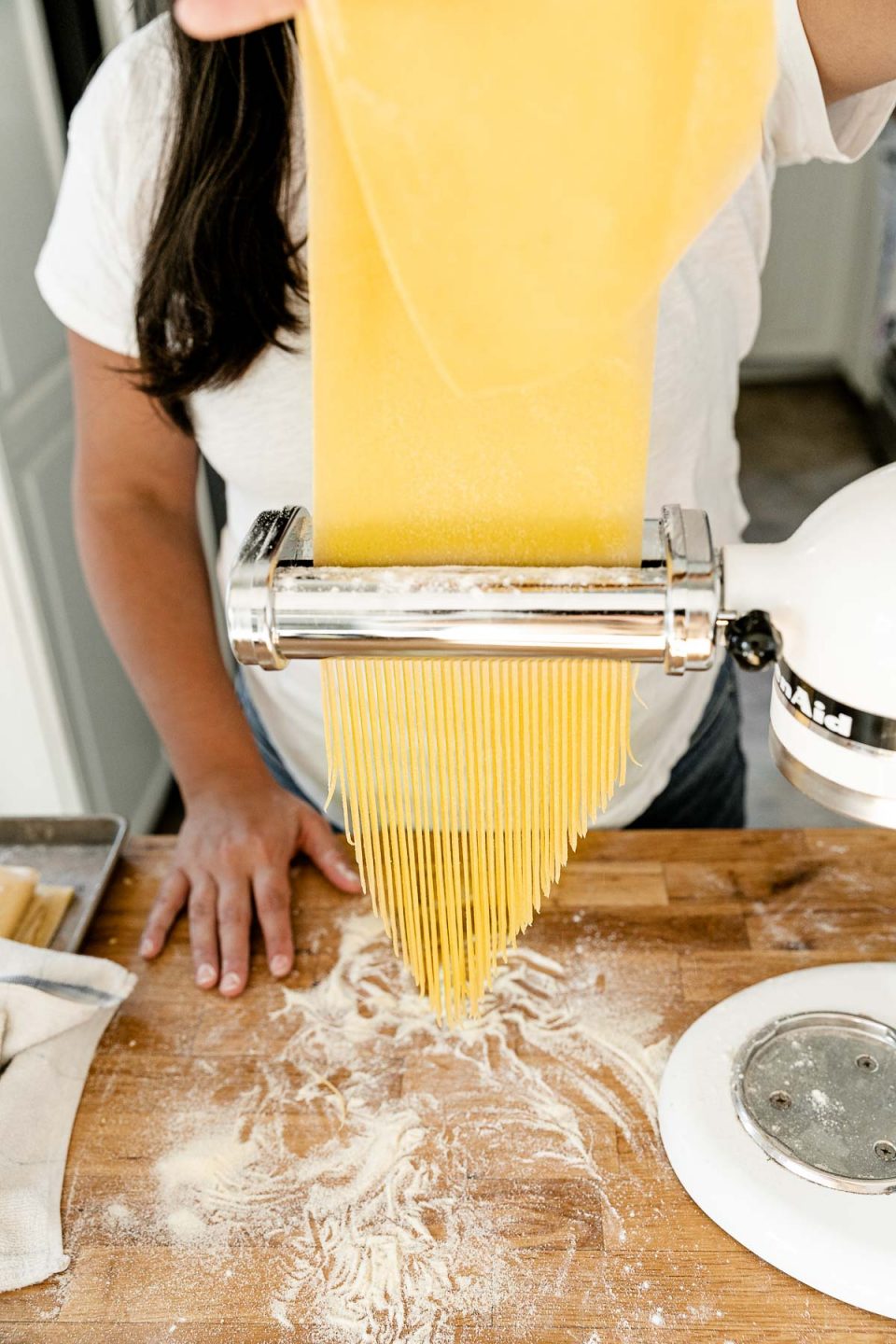
Rolling Out Fresh Pasta Dough with Pasta Roller:
- Prep: Set up your pasta roller according to manufacturer directions. Divide the rested dough into 4 pieces.
- Laminate the dough: Lightly dust the dough with flour & use your hands to press it into a thin, even layer. I like to press it into as rectangular a shape as possible to make it easier to roll out into long, rectangular sheets of pasta. Pass the dough through the pasta machine, with its rollers set to their widest setting. Fold the dough in half, pressing down on it to seal the edges, then give it a quarter turn & run it through the machine again. Repeat 1-2 more times, until the sheet of pasta is about as wide as the roller.
- Roll out the pasta dough: Adjust the pasta machine to its next setting & run the dough through. Continue running the dough through the roller, adjusting to its next setting after each pass through, until you reach your desired thickness.
- Cut the pasta: Once all of the pasta is rolled, cut the pasta as desired. Leave the sheets whole for lasagna or filled pastas, use a sharp knife to cut into thicker noodles (e.g. pappardelle), or use your pasta machine’s attachments to cut into another desired shape (e.g. spaghetti, fettuccini, tagliatelle, etc.). Generously dust the cut pasta with semolina flour & cover with a kitchen towel until you’re ready to boil it.
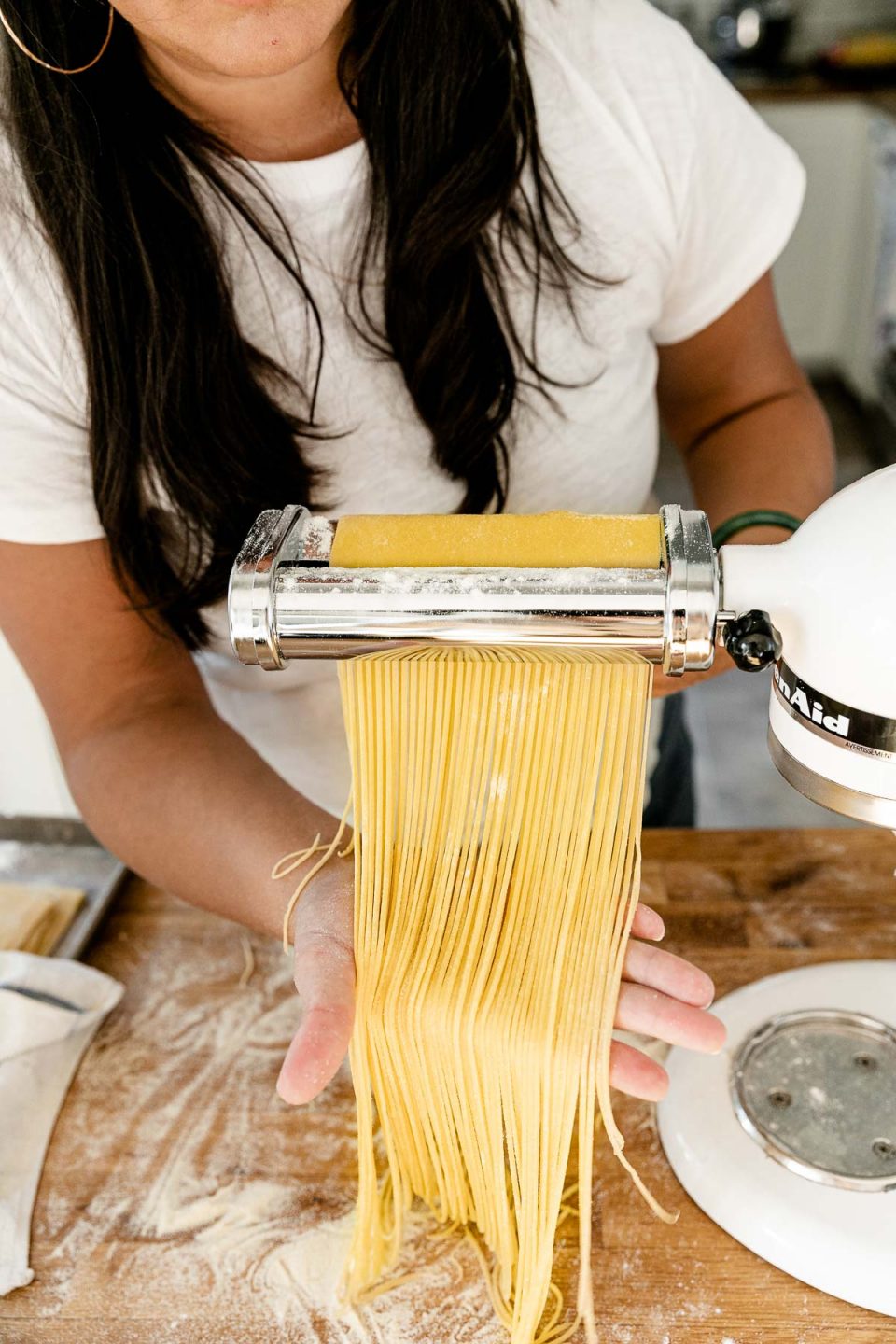
Fresh Pasta FAQ: Can you cook fresh pasta immediately?
Yes, once it’s rolled & cut your fresh pasta can be cooked immediately. There is no need to let it dry further before cooking it.
Tip! Make-Ahead Fresh Pasta. ⇢ Once you’ve reached this point, your pasta will keep, stored in an airtight container in the refrigerator for up to 1 day. If you’re planning on a make-ahead approach, it is best to let it dry ever so slightly before storing it to prevent sticking. Let it rest, uncovered, for 15-20 minutes before transferring to an airtight container & refrigerating.
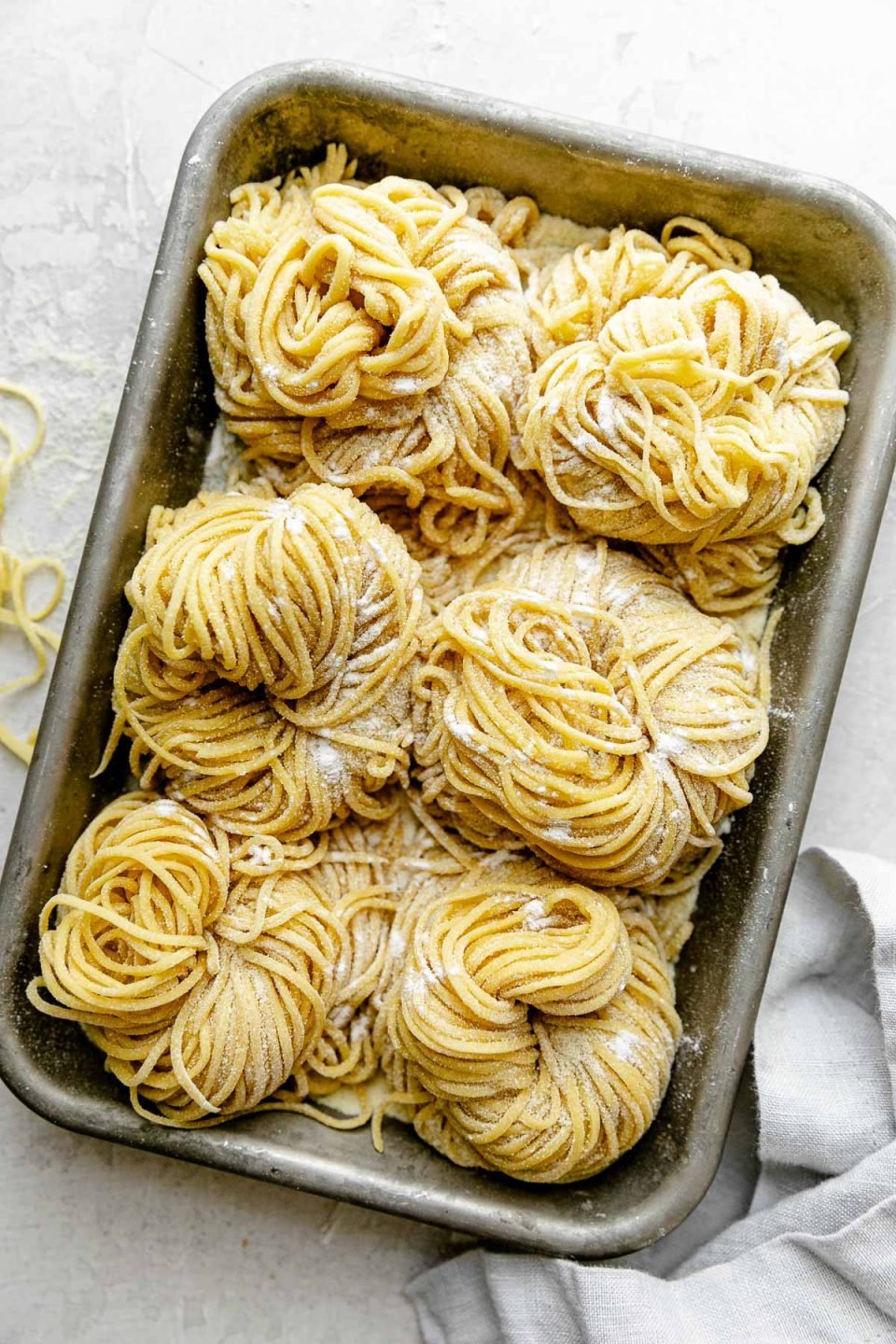
How to Cook Homemade Pasta?
Cooking pasta at home isn’t quite as simple as plopping some sauce on top of al dente pasta. This is the #1 mistake I see people make when it comes to serving pasta at home. Please, please don’t do this!
Instead, cooking pasta should always be approached as a 2-step process: first, boil the pasta to al dente, then finish it in the sauce for a couple of minutes on the stovetop. This allows the two separate components (i.e. the pasta & the sauce) to come together into one cohesive dish. If you feel like your pasta never turns out as good as it does in a restaurant, simply following this step will help tremendously!
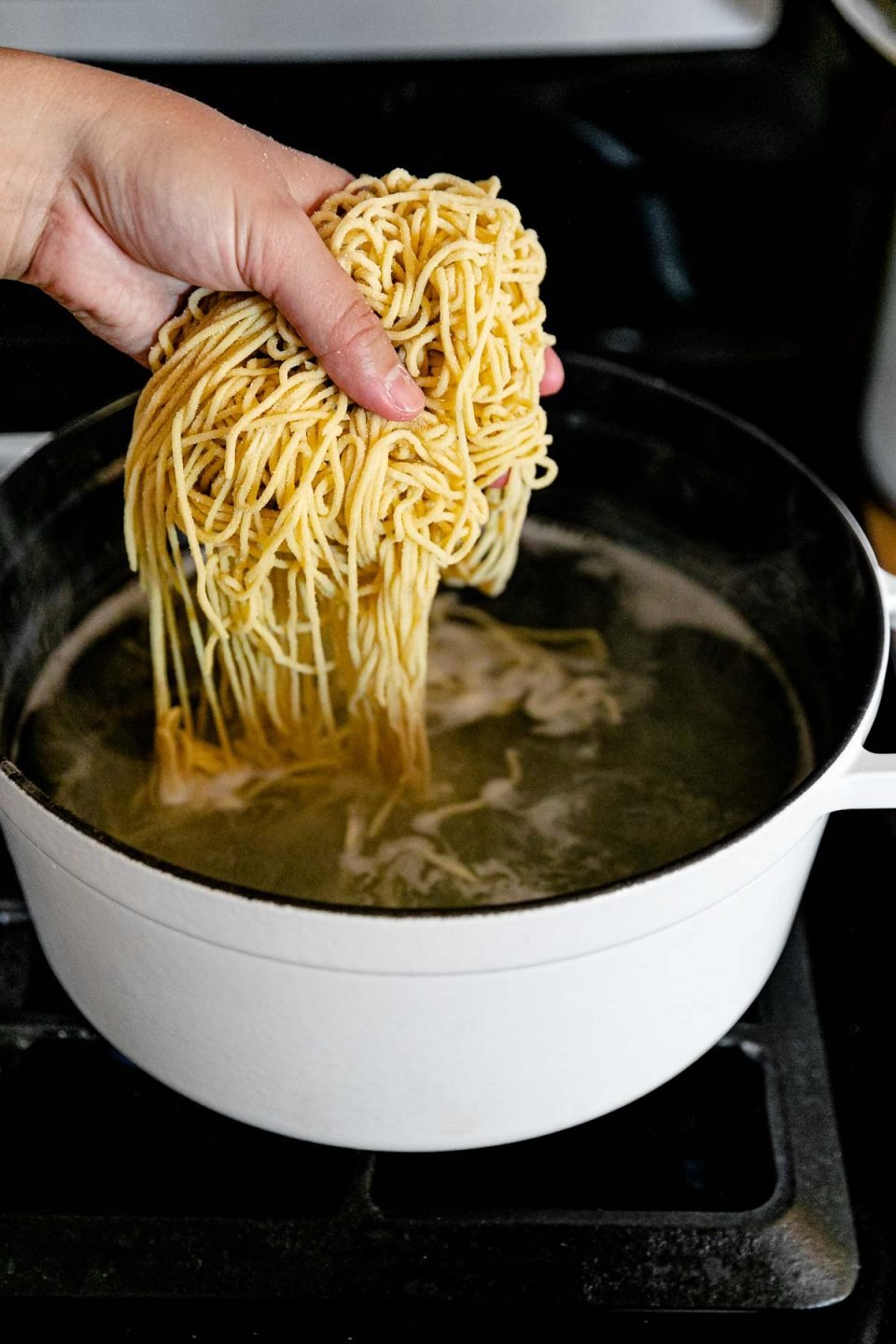
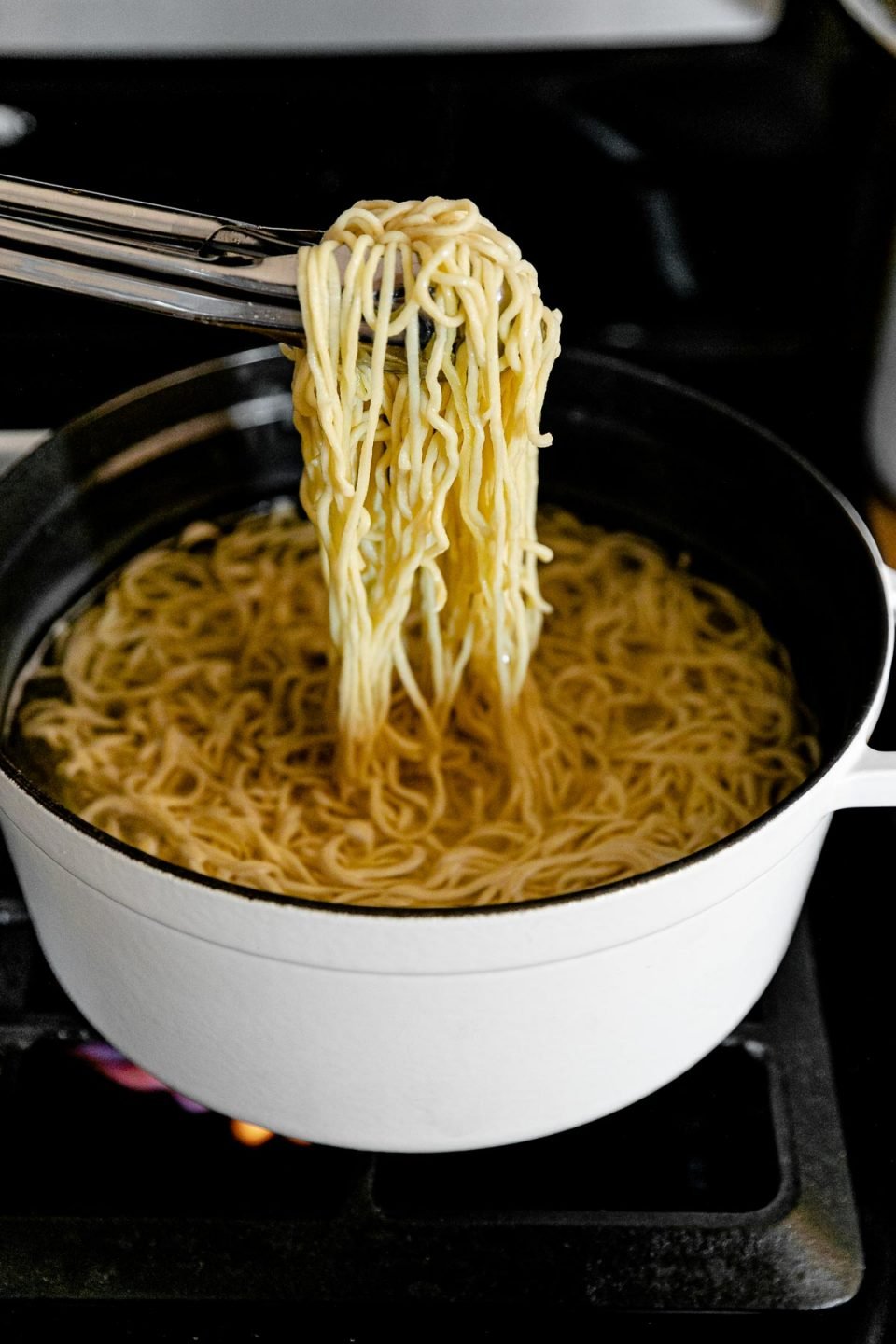
How to cook homemade pasta:
- Boil water: Bring a large pot of generously salted water to a boil. If you’re cooking your pasta immediately, you can begin boiling the water once the fresh pasta dough is rested, just before you begin to roll out & cut the pasta. Tip! ⇢ Be sure to use a big pot, which gives the pasta enough room to move about as it cooks & prevents sticking.
- Heat the sauce: Add your pasta sauce of choice to a second pot or skillet over medium-low heat.
- Cook the pasta: Add the pasta to the boiling water – the water will likely stop boiling once the pasta is added & when it returns to a boil the pasta should nearly be done! How long to cook homemade pasta? ⇢ Begin checking for doneness after 1 minute, cooking the pasta no more than 2-3 minutes – fresh pasta cooks very quickly!
- Finish the pasta: Dip a liquid measuring cup in the boiling pasta to carefully reserve some of the starchy pasta water. Drain the pasta & immediately transfer to the warm sauce. Toss the pasta with the sauce, cooking 1-2 minutes until everything is melded together nicely. Tip! ⇢ Adjust as needed so the sauce evenly coats the pasta. If the mixture is too thick, toss in a little of the reserved pasta water; if the mixture is too loose, crank up the heat or toss in a handful of parmesan cheese!
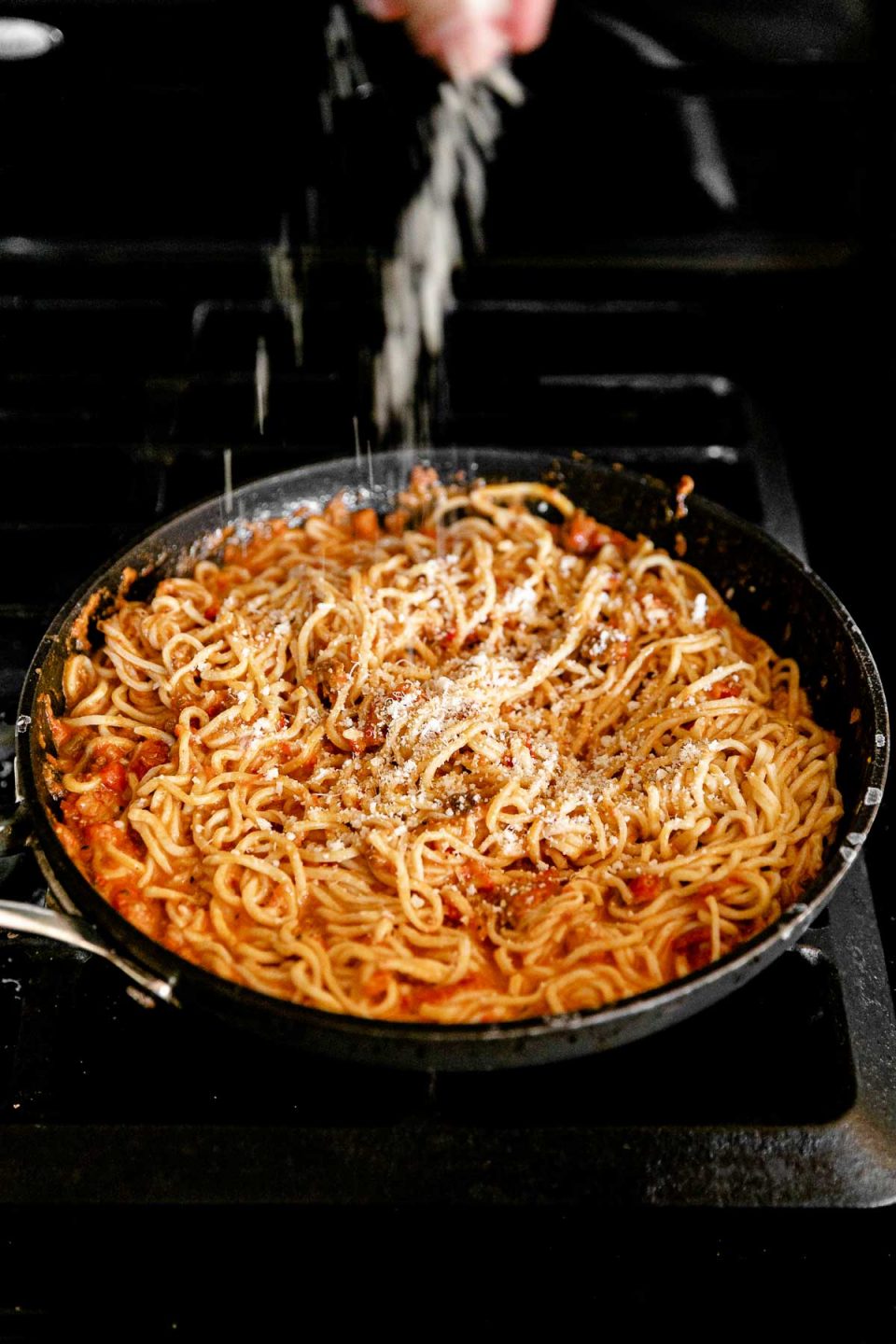
Best Pasta Dishes to Make with Your Homemade Pasta:
The fun part about learning how to make homemade pasta is that it’s a single technique that you can put to use in an infinite number of ways. Use this fresh pasta recipe to make any of your favorite pasta dishes at home. Here are a few of my personal favorites:
- PWWB Best-Ever Bolognese (pictured) – A recipe I’ve tweaked & perfected over 10+ years, this is my personal favorite recipe on PWWB & it’s seriously the best bolognese sauce ever.
- Weeknight Bolognese – A slightly easier & quicker bolognese sauce recipe.
- Ragu – AKA slowly simmered Italian goodness, ragu is a hearty meat sauce perfect for pairing with fresh pasta. Try my Slowly Braised Lamb Ragu or my Slowly Braised Pork Ragu.
- Lasagna
- The Classics – Creamy Marsala Pasta with Sausage, Spicy Italian Sausage and Peppers Pasta, or Pasta all’Amatriciana
- Something New – Seared Scallop Pasta with Kale Pesto or Mascarpone Pasta with Chicken
- All PWWB Pasta Recipes
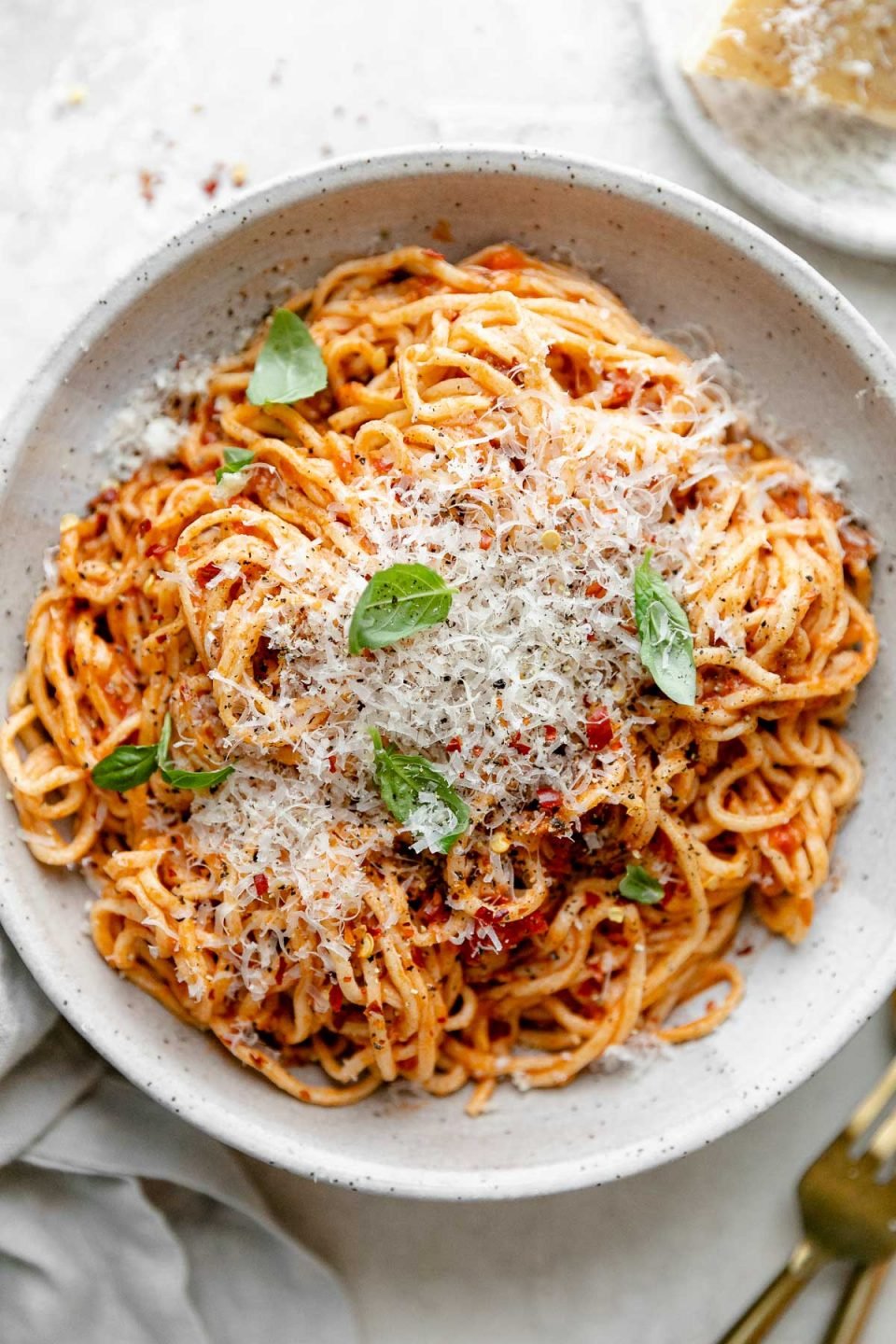
I cannot wait for you to try this Fresh Pasta Recipe! Learning how to make homemade pasta is one of my favorite kitchen skills I’ve learned this year, & I know you’ll love it just as much as I do.
If you do give it a try, be sure to let me know! Leave a comment with a star rating below. You can also snap a photo & tag @playswellwithbutter on Instagram. I LOVE hearing about & seeing your PWWB creations!
Print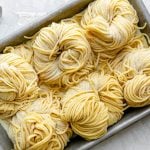
How to Make Homemade Pasta (Fresh Pasta Recipe)
- Prep Time: 45 minutes
- Resting Time: 60 minutes
- Cook Time: 3-5 minutes
- Total Time: 2 hours
- Yield: serves 4
- Category: Pasta Recipes, Techniques & How-Tos
- Method: By Hand, Without Machine, With Machine, KitchenAid
- Cuisine: Italian
Description
Learn how to make homemade pasta by hand, with a machine, or using a KitchenAid stand mixer (my bonus shortcut method!). This simple fresh pasta recipe is complete with step-by-step photos & detailed explanations of every step along the way – the perfect starting point for learning how to make homemade pasta dough as a beginner!
Be sure to refer to the blog post, above, for extra fresh pasta tips & tricks!
Ingredients
- 1 ½ cups Bob’s Red Mill Organic Unbleached All-Purpose Flour (180 grams), plus extra for dusting
- ½ cup Bob’s Red Mill Semolina Flour (82 grams), plus extra for dusting
- 1 teaspoon kosher salt
- 2 large eggs + 2 large egg yolks, at room temperature
- 2 tablespoons extra virgin olive oil
- 2–4 tablespoons water
Instructions
Kneading Fresh Pasta Dough by Hand:
- Mix the flours: Add the all-purpose flour, semolina flour, & kosher salt to a large mixing bowl. Whisk to combine. Turn the flour mixture on a clean, sturdy work surface, using your hands to bring it together in a pile. Create a large well in the center of the flour mixture. Add the eggs, egg yolks, olive oil, & 2 tablespoons of water to the well.
- Mix the pasta dough: Use a fork to break up the eggs & whisk the egg mixture. Once the eggs are whisked, gradually mix flour from the edges of the well into the mixture. Once the dough is too thick to continue mixing with the fork, use your hands to bring the dough together. Since the dough will be rather sticky at this point, it’s helpful to use a bench scraper to scrape the loose flour into the dough ball. Continue mixing by hand until the dough comes together into a ball. (If you have difficulty getting the dough ball to form, see Recipe Notes, below, for Troubleshooting tips.)
- Knead the pasta dough: Knead the pasta dough for 8-10 minutes. Be sure to really use your body weight to roll & stretch the dough, as this helps develop the glutens in the flour, creating homemade pasta with a beautiful springy, chewy texture. I find it’s easiest to place the heel of my palm on the surface of the dough closest to me, then forcefully push down & forward, stopping just as the heel of my palm reaches the center of the dough ball. I rotate the dough ball a quarter turn, then repeat. Avoid tearing the dough as you knead, as this breaks the glutens. The pasta dough will be ready once the dough ball is smooth & supple. It will feel very tight & tense, but the surface should be very smooth. You can press your finger on the dough & it should bounce back pretty quickly.
- Rest the pasta dough: Tightly wrap the pasta dough in plastic & set aside to rest at room temperature for 1 hour or refrigerate for later use (see “Make-Ahead Pasta” in the Recipe Notes, below).
Kneading Fresh Pasta Dough in a Stand Mixer: In order to knead properly, creating fresh pasta with a nice, toothsome texture, the mixer needs enough dough for the dough hook to work it against the sides of the bowl. I suggest doubling this fresh pasta recipe if you plan to use this stand mixer method. Use the “SCALE 2X” button at the top of the Ingredients List, above, & the recipe card will automatically calculate proper measurements in the Ingredients List.
- Mix the flours: Add the all-purpose flour, semolina flour, & kosher salt to the mixing bowl of a stand mixer fitted with its paddle attachment. Mix on low, just to combine.
- Mix the pasta dough: Use your hands to create a large well in the center of the flour mixture. Add the eggs, egg yolks, olive oil, & 2 tablespoons of water to the well. Mix on low, just until combined into a shaggy dough. Swap the paddle attachment with the dough hook. Knead on medium speed for 8-10 minutes, until the dough is smooth & supple. It will feel very tight & tense, but the surface should be very smooth. You can press your finger on the dough & it should bounce back pretty quickly.
- Rest the pasta dough: Turn the pasta dough on a lightly floured surface. Knead a few times by hand, just to bring the dough together into a smooth ball. Tightly wrap the pasta dough in plastic & set aside to rest at room temperature for 1 hour.
Rolling Out Fresh Pasta Dough with Pasta Roller:
- Prep: Use a knife or bench scraper to divide the rested dough into 4 pieces. Cover the pasta dough with a kitchen towel until you’re ready to begin rolling it out. Set up your pasta roller according to manufacturer instructions. If you plan to cook your pasta immediately, this is a good time to begin boiling your pasta water, as well (see “Cooking Fresh Pasta” Step 1, below).
- Roll out the pasta: Lightly dust 1 of the 4 pieces of fresh pasta dough with flour. Use your hands to press the dough into a thin, even layer. With the machine set to its widest setting, pass the dough through the rollers. Fold the dough in half, pressing down on it to seal the edges, then give it a quarter turn & run it through the machine again. Repeat folding & passing through at the wides setting 1-2 more times, until the sheet of pasta is about as wide as the roller. Adjust the pasta roller to its next setting & run the dough through. Continue running the dough through the roller, adjusting to its next setting after each pass through, until the sheet of pasta reaches your desired thickness. Once the pasta begins to get thin, I suggest catching it using the back of your hand (vs your fingers) to avoid tearing. If the dough begins to stick to the machine at any point, simply dust it with a little extra flour. If desired, you can also dust the rollers with a little flour, too. Once rolled to your desired thickness, dust the sheet of pasta with flour & cover with a kitchen towel. Repeat the process with the remaining 3 pieces of fresh pasta dough.
- Cut the pasta: Once all of the pasta is rolled, cut the pasta as desired. Leave the sheets whole for lasagna or filled pastas, use a sharp knife to cut into thicker noodles (e.g. pappardelle), or use the your pasta machine’s attachments to cut into another desired shape (e.g. spaghetti, fettuccini, tagliatelle, etc.). Dust the cut pasta with semolina flour & transfer the cut pasta to a small baking sheet. Cover with a kitchen towel & repeat until all of the pasta dough is cut. At this point you can cook & serve your fresh pasta (see “Cooking Fresh Pasta” Step 1, below) or store for cooking later (see “Make-Ahead Pasta” in the Recipe Notes, below).
Rolling out Fresh Pasta Dough with a Rolling Pin:
- Prep: Use a knife or bench scraper to divide the rested dough into 2 pieces. Cover the pasta dough with a kitchen towel until you’re ready to begin rolling it out. If you plan to cook your pasta immediately, this is a good time to begin boiling your pasta water, as well (see “Cooking Fresh Pasta” Step 1, below).
- Roll out the pasta: Lightly dust your work surface, a rolling pin, & 1 of the 2 pieces of fresh pasta dough with flour. Roll out the dough as thinly & evenly as possible until the sheet of pasta reaches your desired thickness. If the dough begins to stick to the surface or the rolling pin at any point, simply dust the dough, the surface, & the rolling pin with a little extra flour. Once rolled to your desired thickness, dust the sheet of pasta with flour & cover with a kitchen towel. Repeat the process with the remaining fresh pasta dough.
- Cut the pasta: Once all of the pasta is rolled, cut the pasta as desired. Leave the sheets whole for lasagna or filled pastas or use a sharp knife to cut into noodles (e.g. pappardelle, spaghetti, fettuccini, tagliatelle, etc.). Dust the cut pasta with semolina flour & transfer the cut pasta to a small baking sheet. Cover with a kitchen towel & repeat until all of the pasta dough is cut. At this point you can cook & serve your fresh pasta (see “Cooking Fresh Pasta” Step 1, below) or store for cooking later (see “Make-Ahead Pasta” in the Recipe Notes, below)
Cooking Fresh Pasta:
- Boil water: Bring a large pot of generously salted water to a boil. If you plan to cook your pasta immediately, begin boiling the water just as you start to roll out & cut your pasta.
- Cook the pasta: Add the pasta to the boiling water, stirring often to prevent sticking. The water will likely stop boiling once the pasta is added; when the water returns to a boil the pasta should nearly be done! Check for doneness after 1 minute, cooking the pasta no more than 2-3 minutes – fresh pasta cooks very quickly!
- Finish the pasta: Reserve some of the starchy pasta water for finishing the pasta with the pasta sauce. Drain the pasta. Toss the pasta with your sauce, using the reserved pasta water to loosen up the sauce & bring everything together as needed.
- Serve immediately. Enjoy!
Equipment
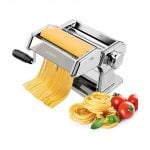 Buy Now →
Buy Now → 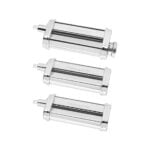 Buy Now →
Buy Now → 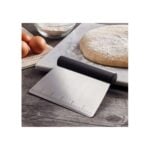 Buy Now →
Buy Now → 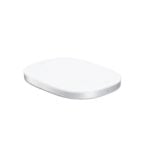 Buy Now →
Buy Now → 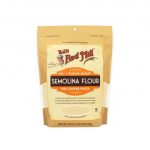 Buy Now →
Buy Now → 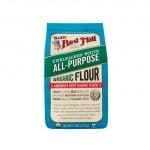
Bob’s Red Mill Organic Unbleached All-Purpose Flour
Buy Now →Notes
- Troubleshooting Fresh Pasta Dough:
- How to fix pasta dough that is too wet! ⇢ Your pasta dough is too wet if it is sticky to the touch & doesn’t come together in a nice ball. Wet pasta dough is a nightmare to roll out since it sticks to everything it touches – your hands, the counter, the pasta rollers or rolling pins, etc. Fortunately, of all the problems you could have, this is the easiest one to fix! Working 1 tablespoon at a time, knead more flour into the dough until it’s barely tacky.
- How to fix pasta dough that is too dry! ⇢ Your pasta dough is too dry if it tears easily as you knead it or if the edges crumble. Working 1 teaspoon at a time, knead more water into the dough until it’s barely tacky. The added moisture will make the surface of the dough ball really slippery & sticky at first, but it will smooth out as you continue to knead.
- Make-Ahead Pasta:
- Make-Ahead Pasta Dough: Fresh pasta dough is very make-ahead friendly! Once it’s kneaded & ready to rest, wrap the homemade pasta dough tightly in plastic. Store in the refrigerator for up to 1 day. Remove from the refrigerator about 30 minutes – 1 hour before rolling & cutting your pasta to allow it to come up to room temperature.
- Make-Ahead Fresh Pasta: Fresh cut pasta is also make-ahead friendly. Once it’s rolled out & cut, let the pasta sit, uncovered, for 15-20 minutes to let it dry ever so slightly, then transfer to an airtight container & refrigerate up to 1 day. This is not my preferred make-ahead method – I prefer cooking pasta as soon as it’s cut, so I like the Make-Ahead Pasta Dough method, above – but it’s totally doable.
Recipe and Food Styling by Jess Larson, Plays Well With Butter | Photography by Rachel Cook, Half Acre House.
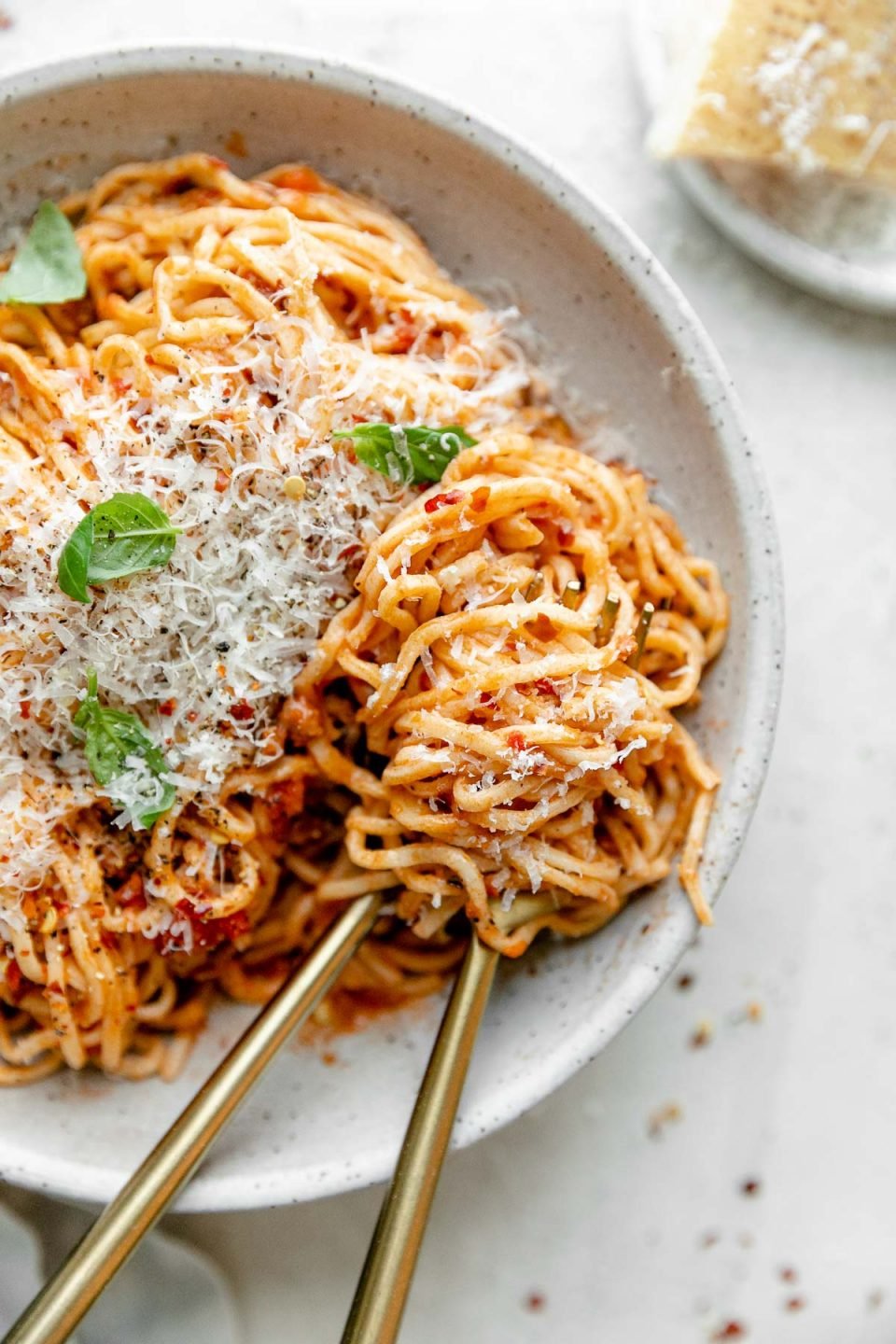

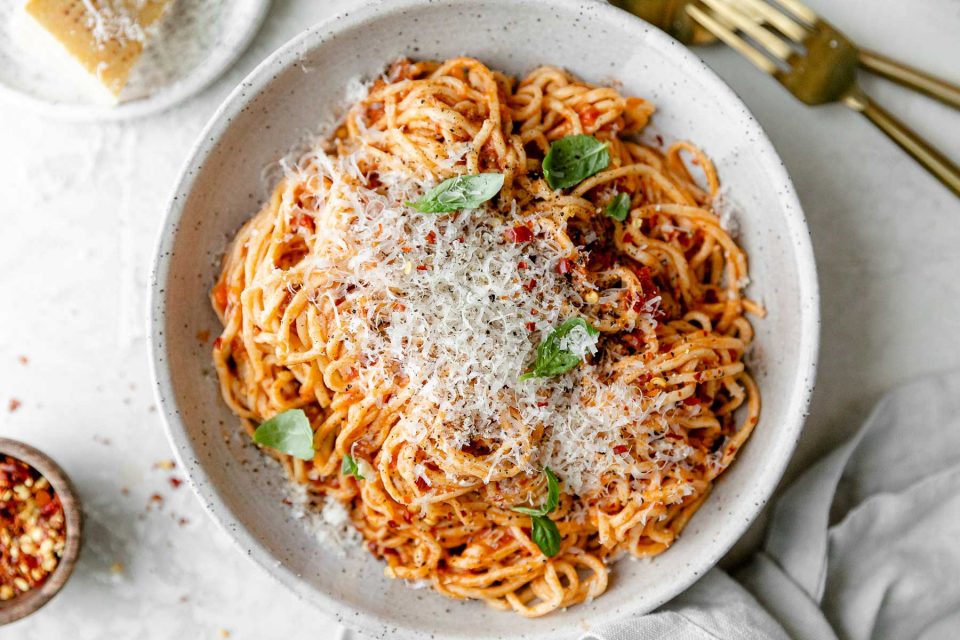
Follow along with Plays Well With Butter on Instagram, YouTube, Facebook, and Pinterest for more unfussy recipes that pack a big punch of flavor!


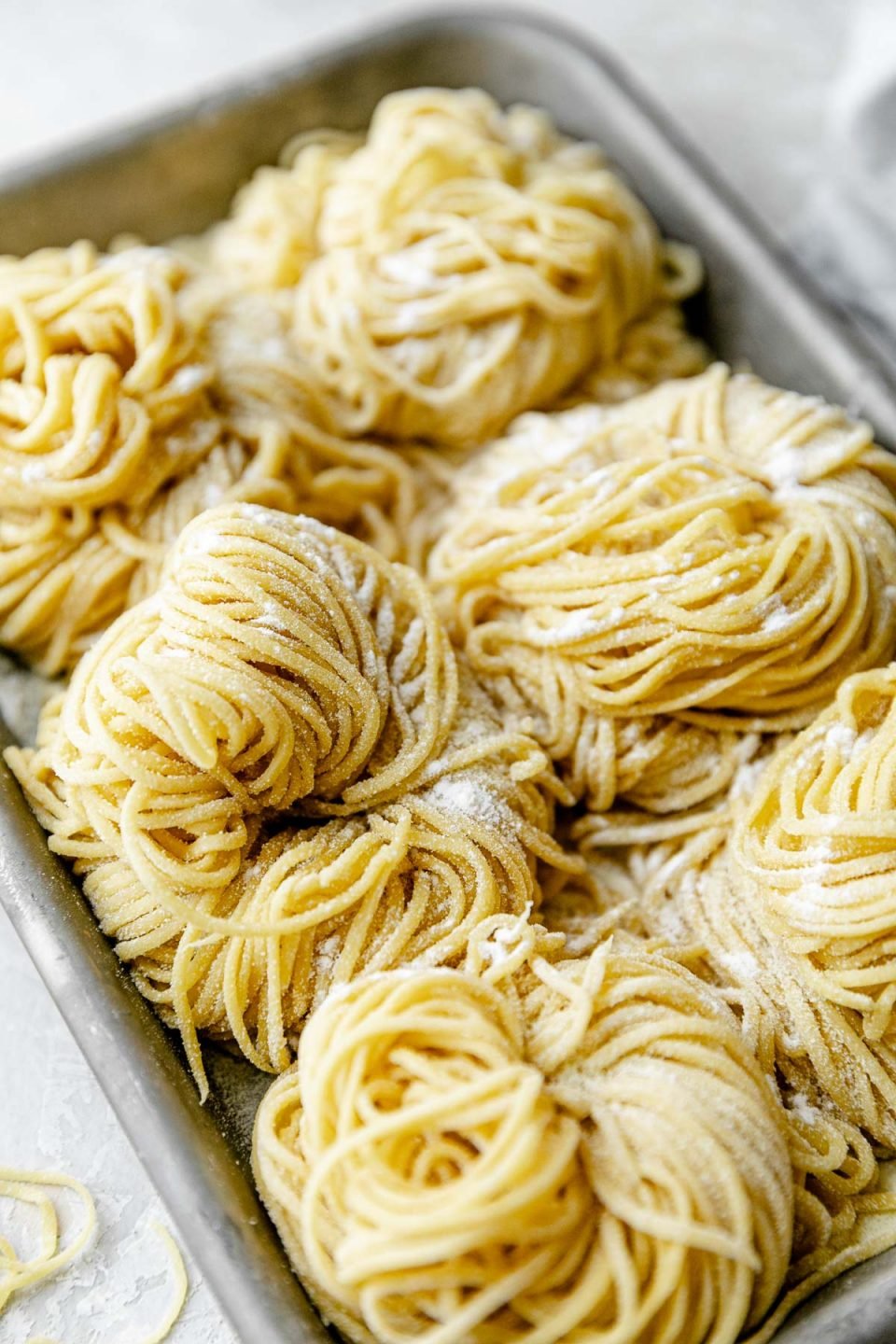
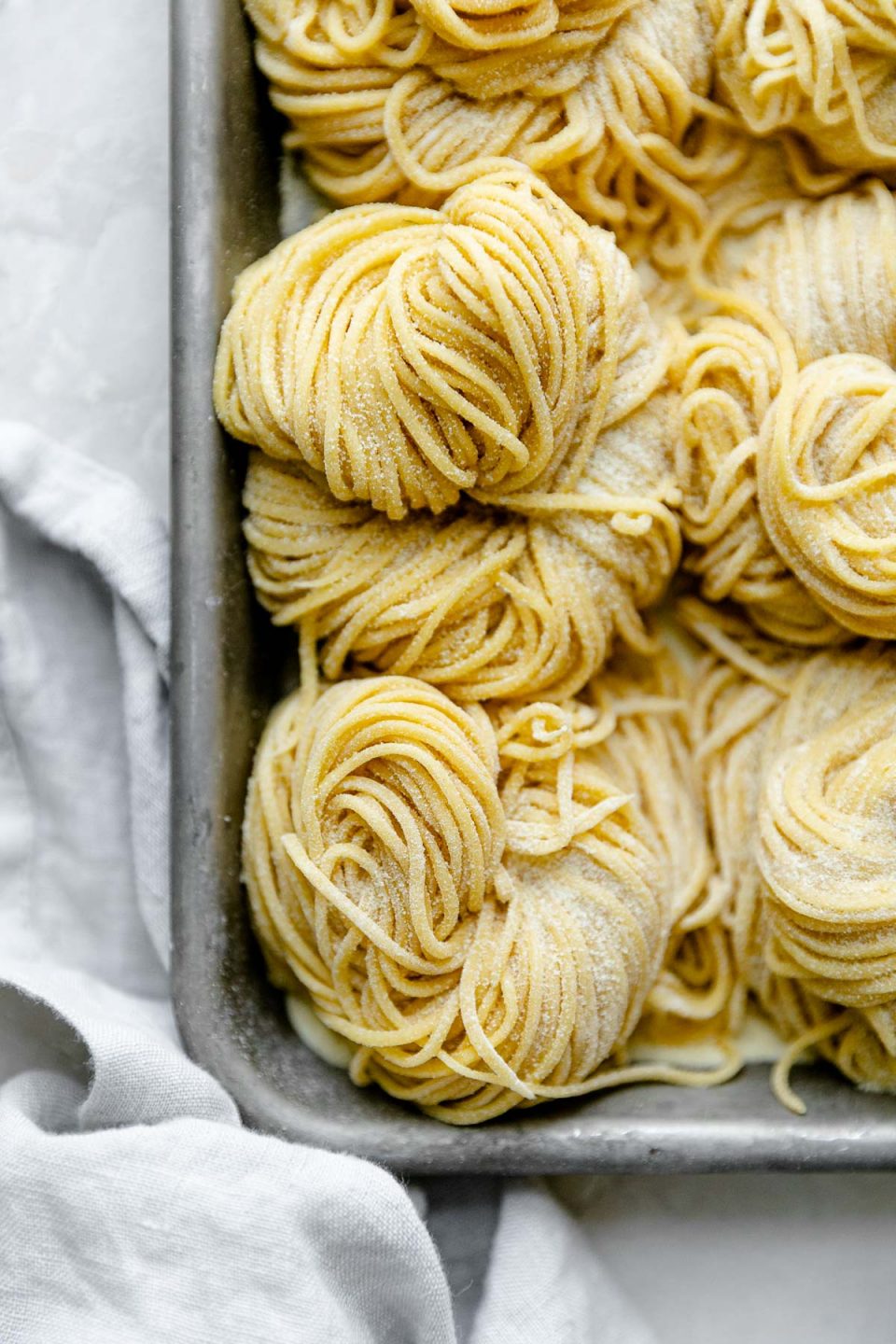
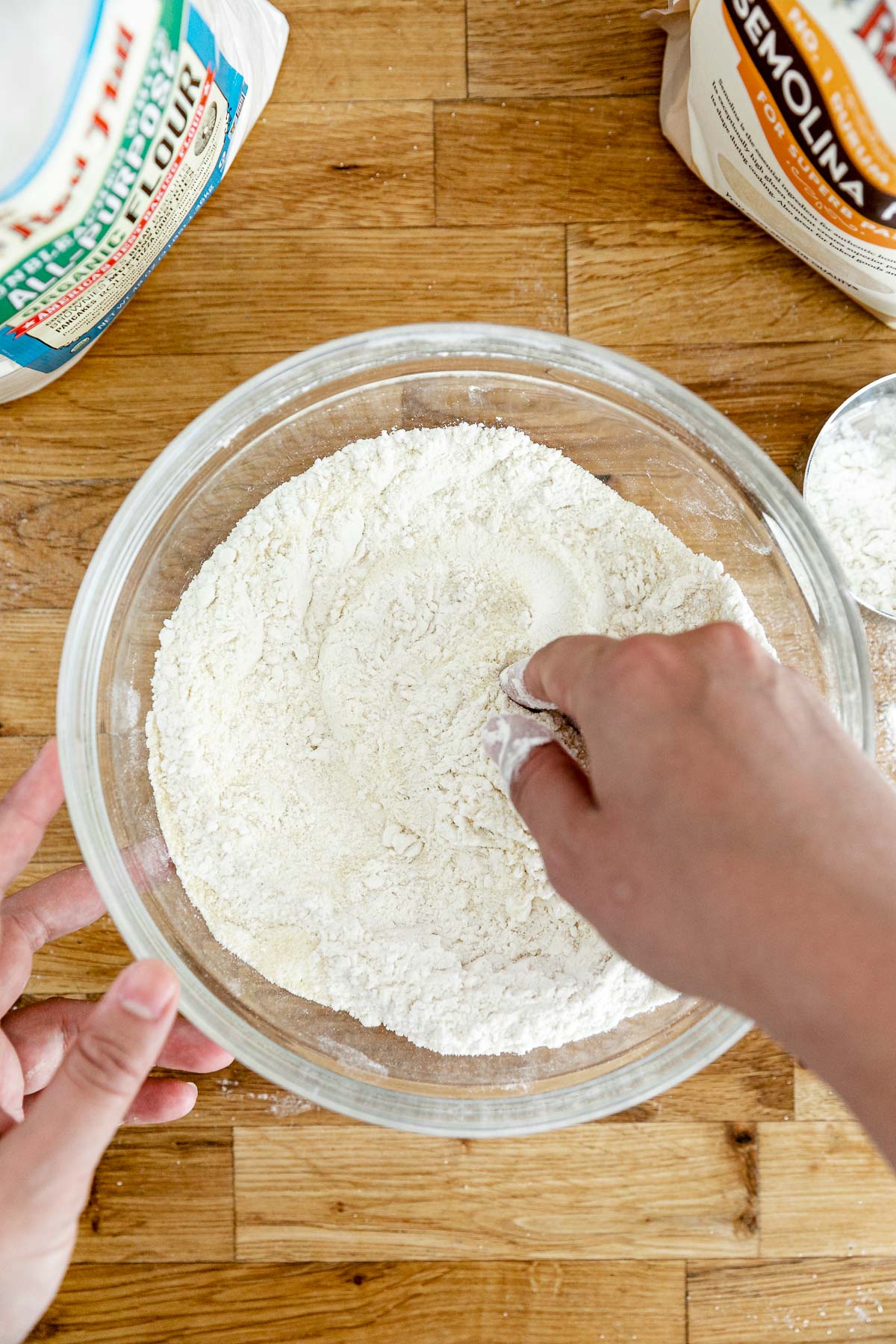
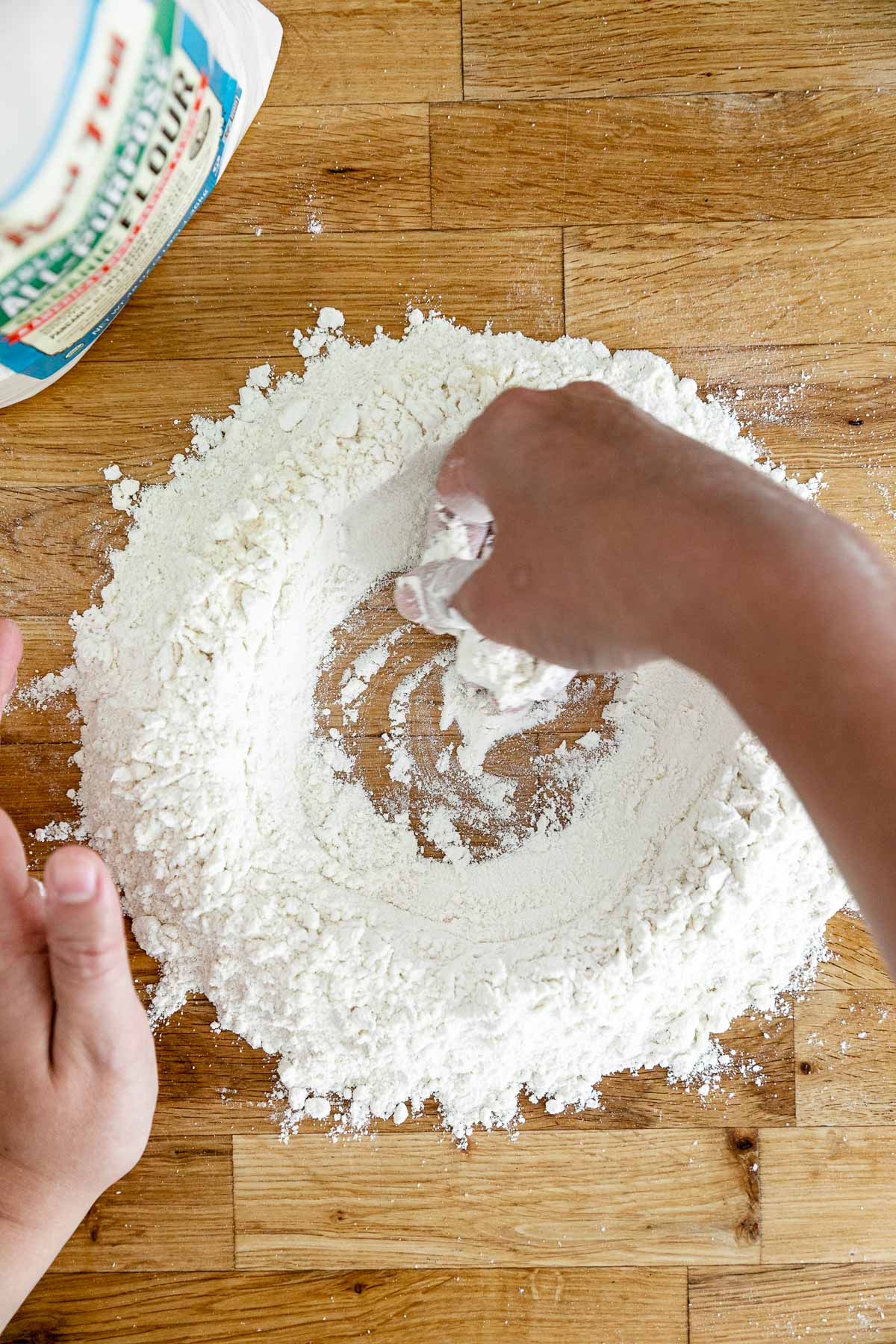
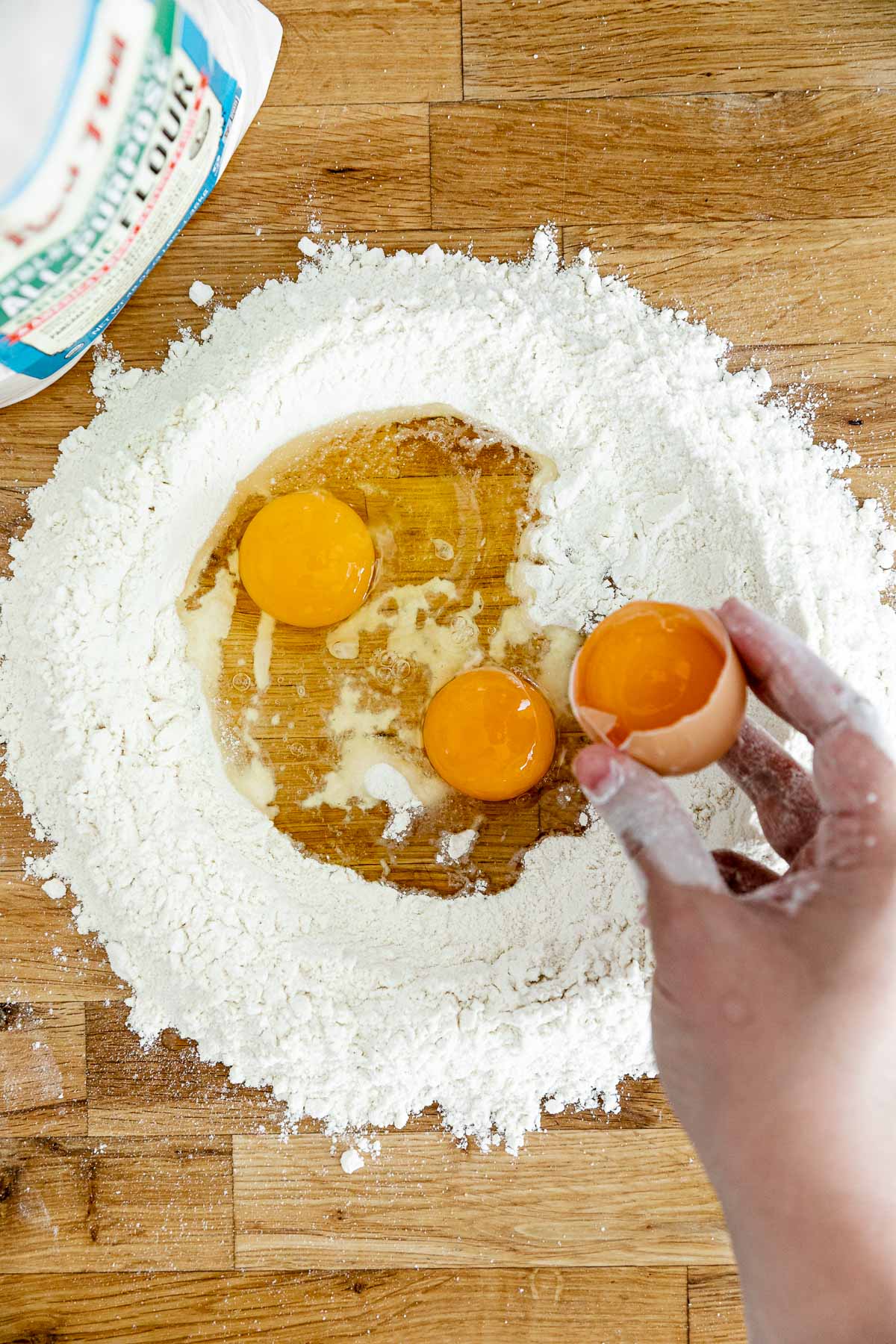
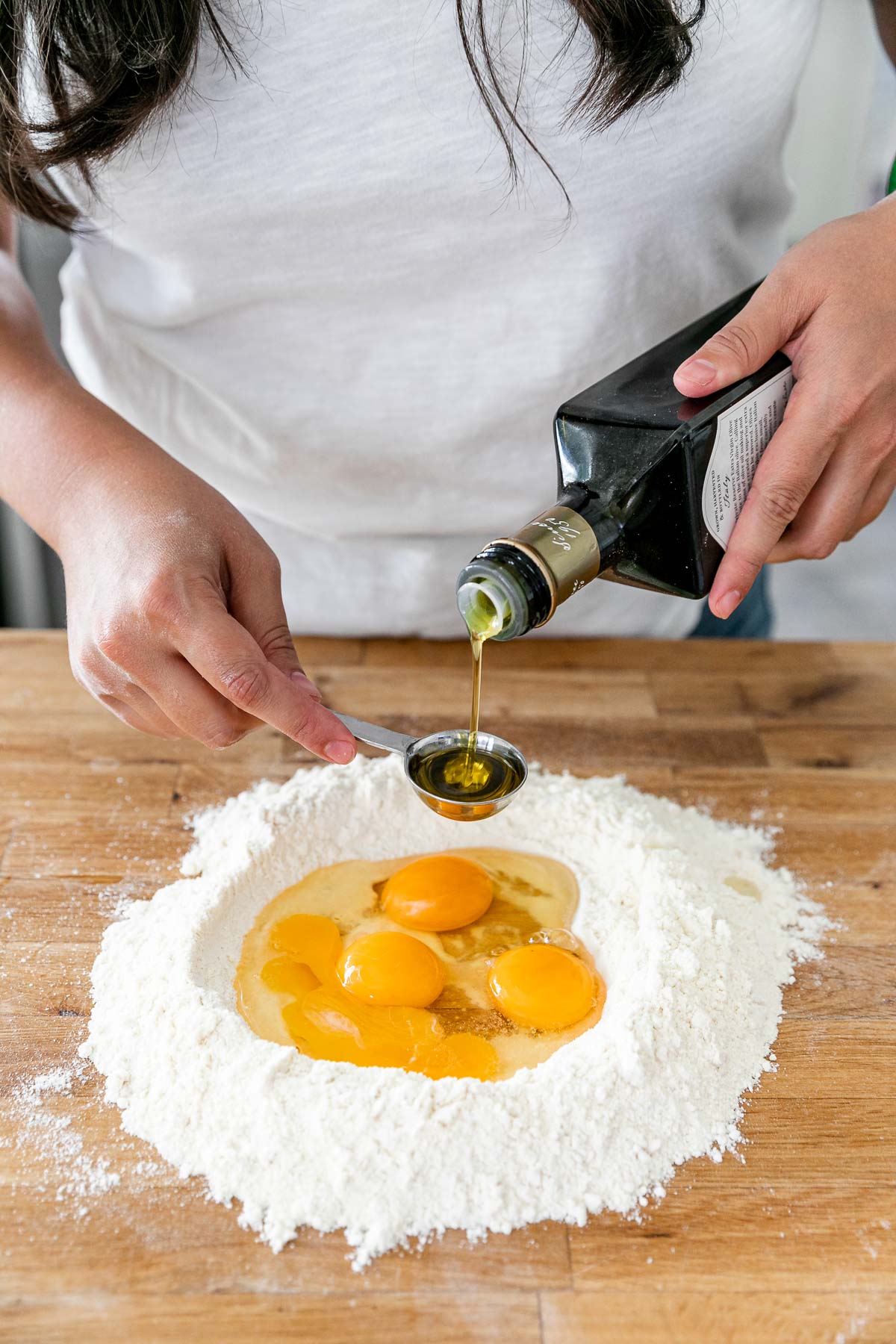
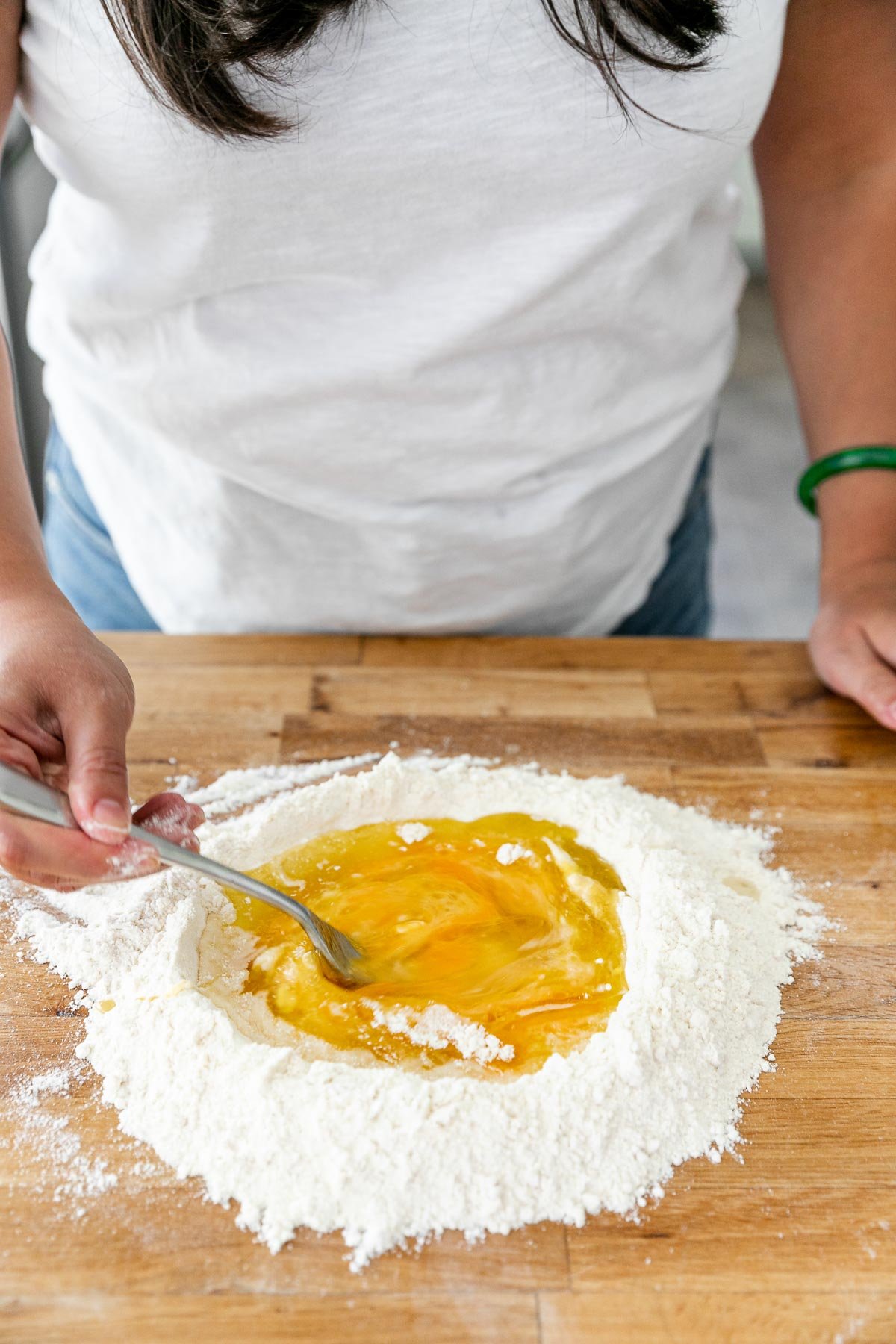
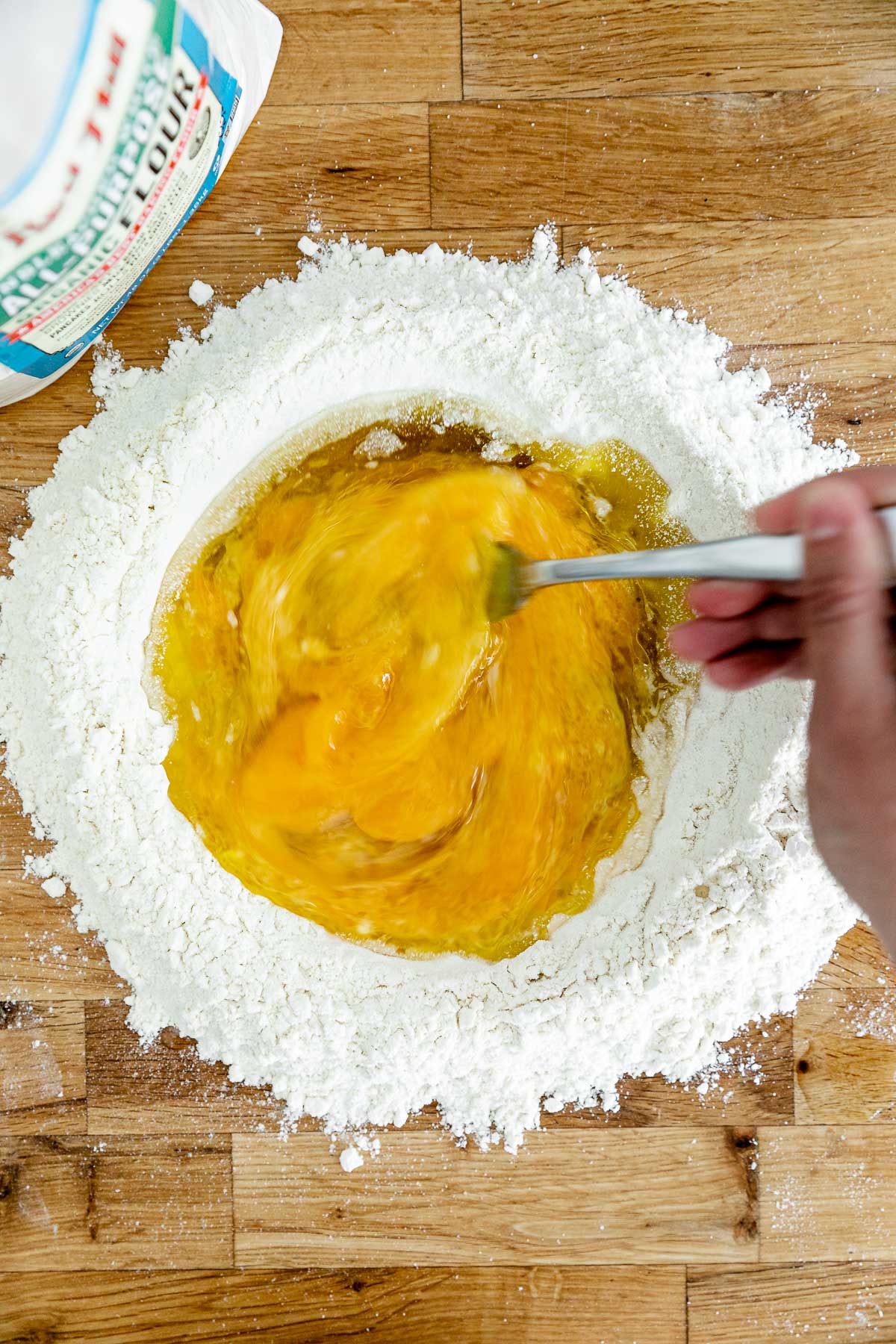
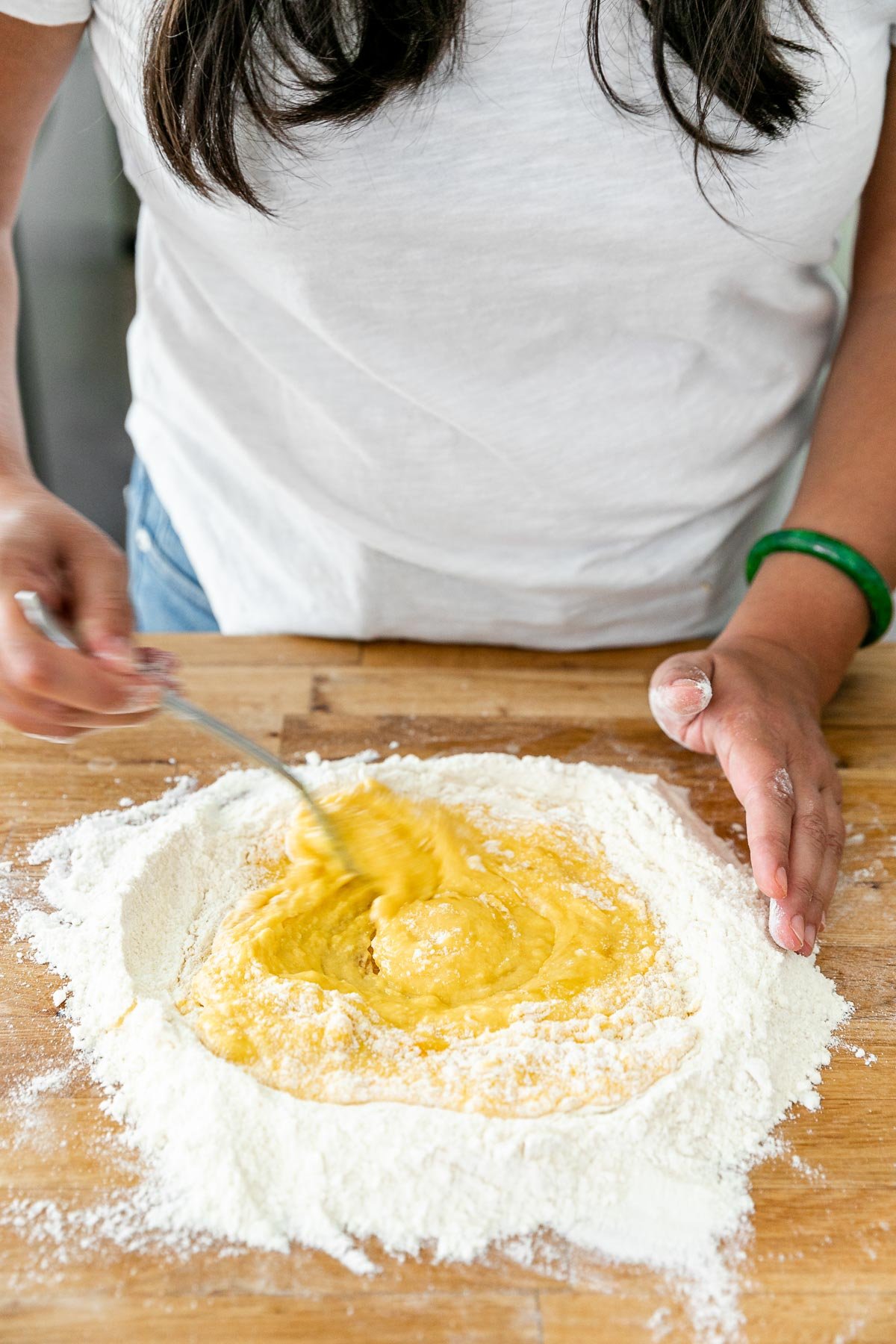
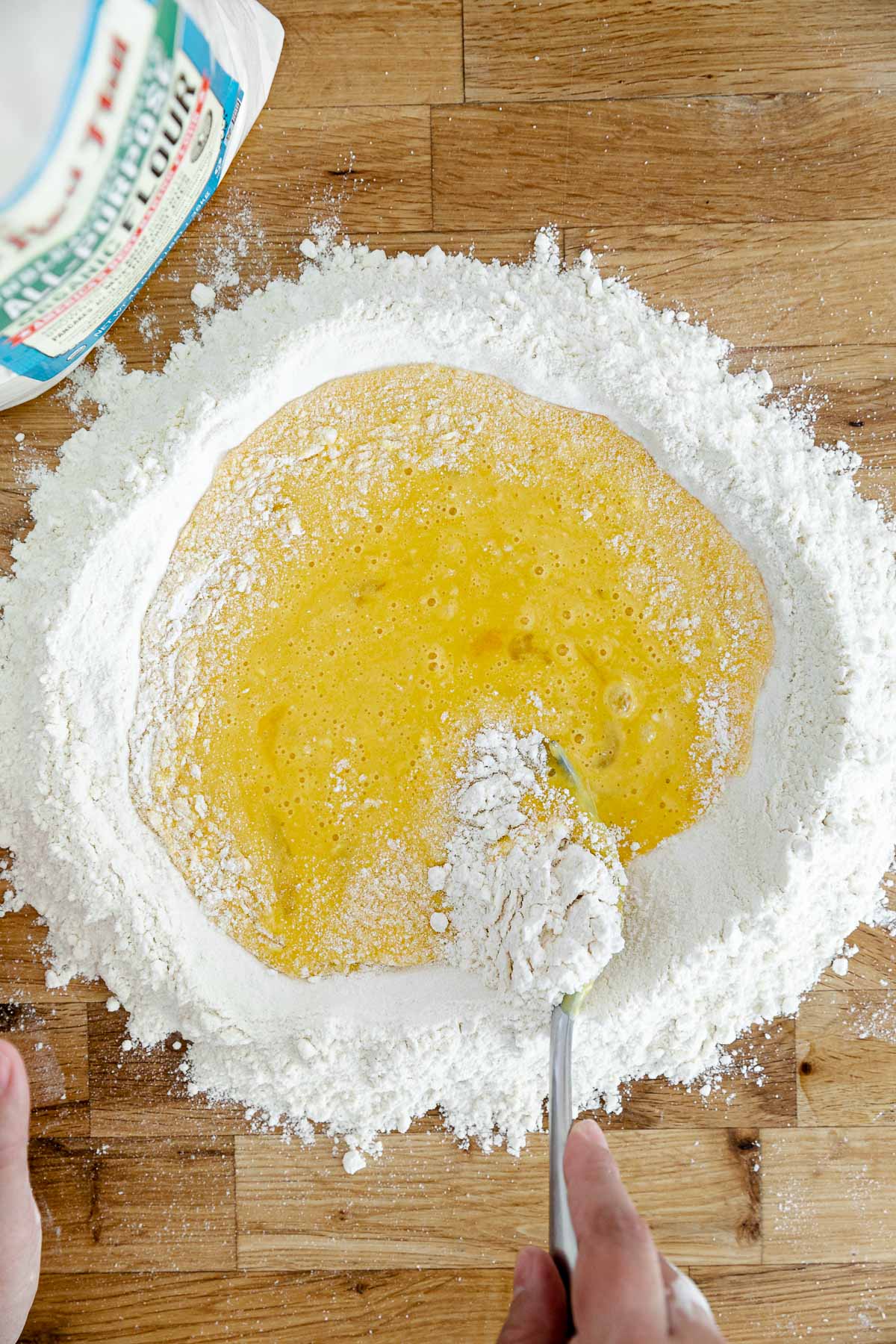
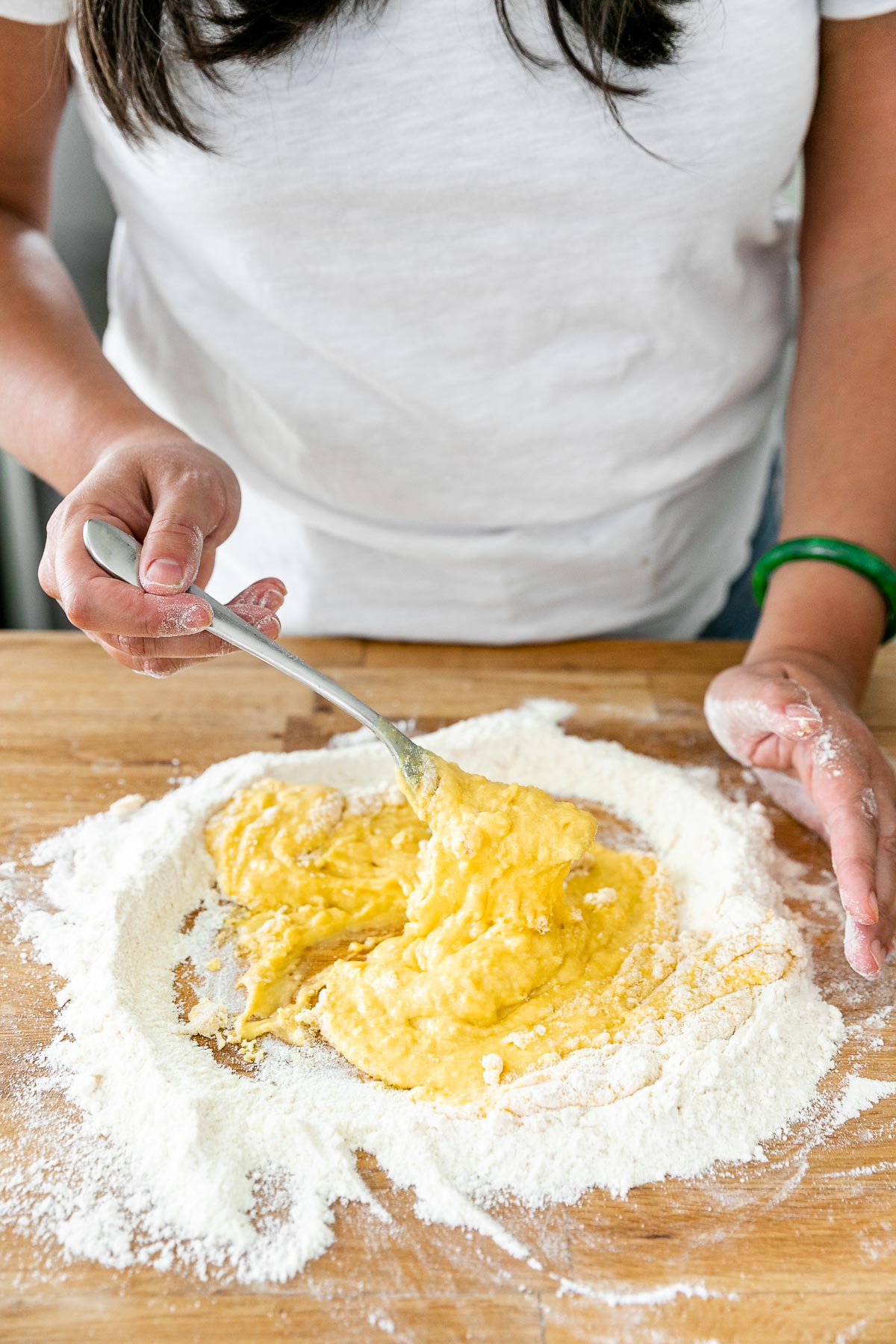
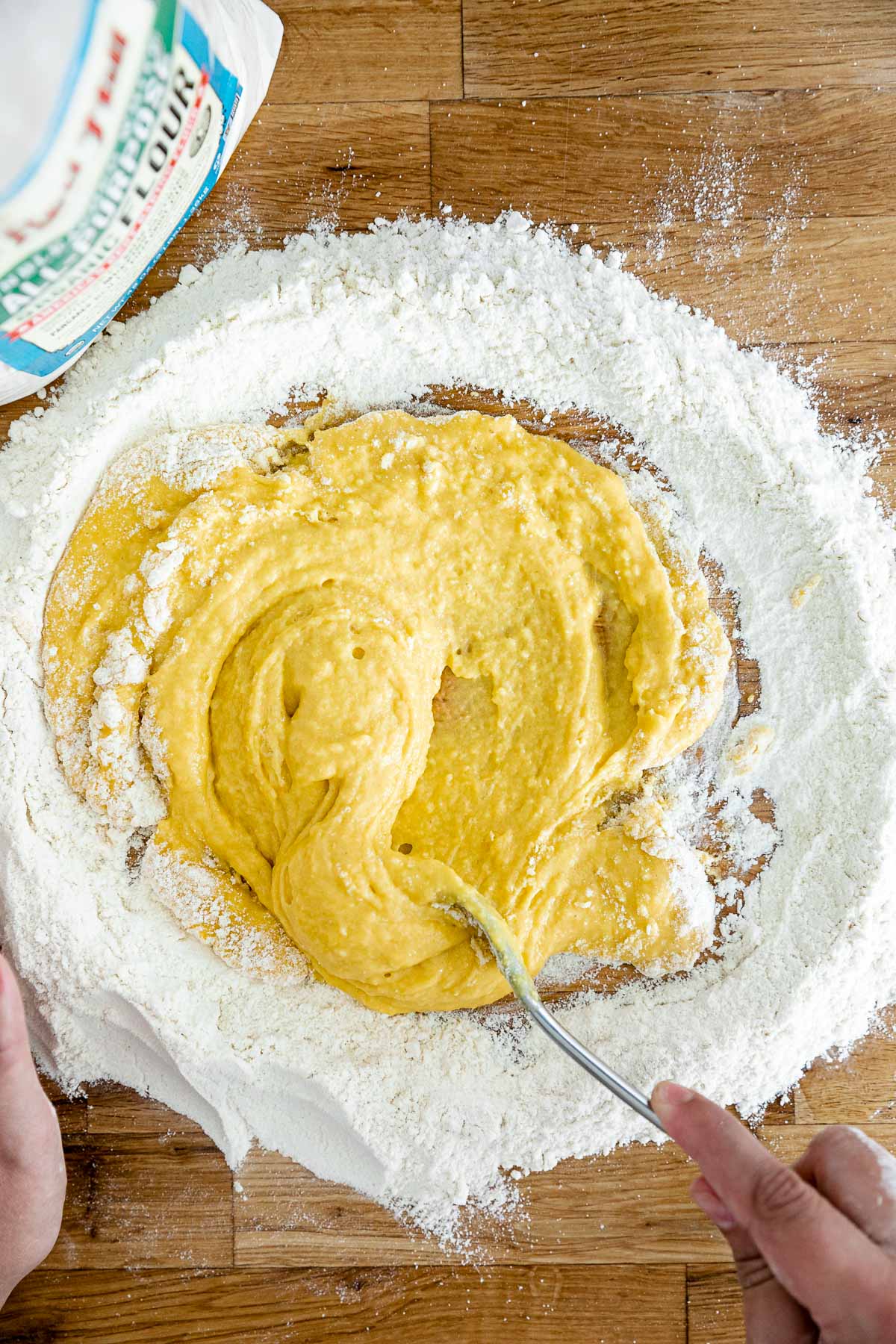
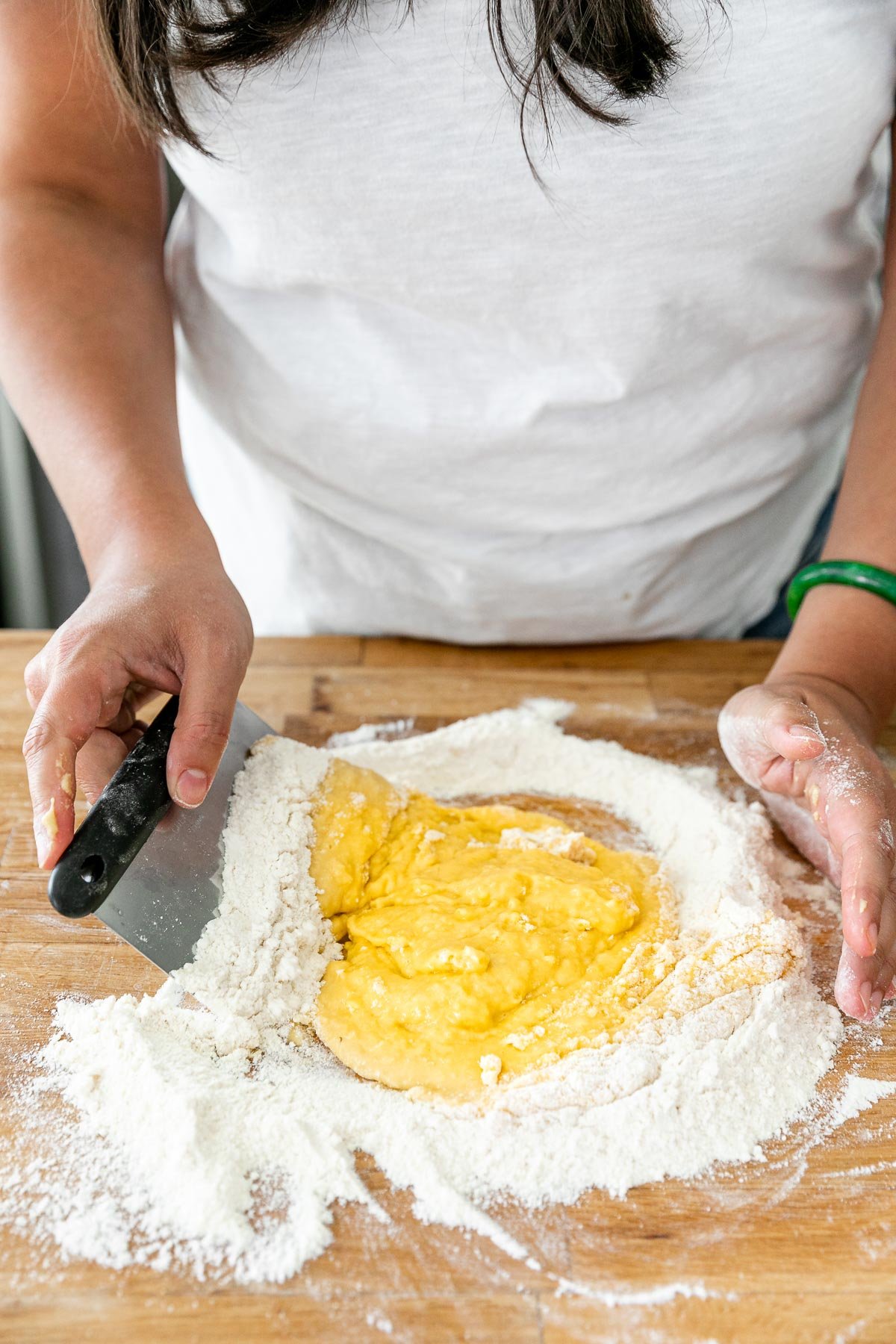
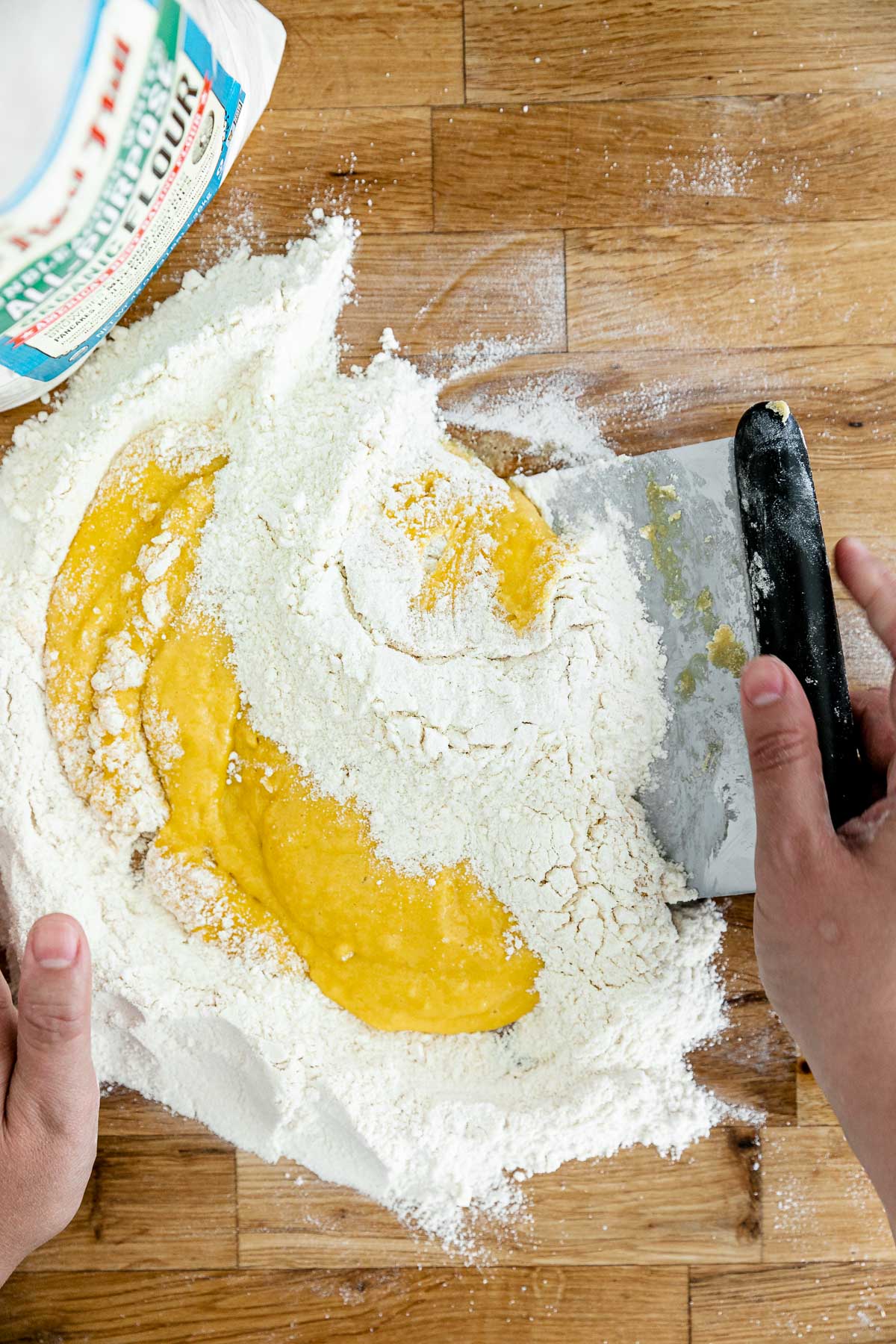
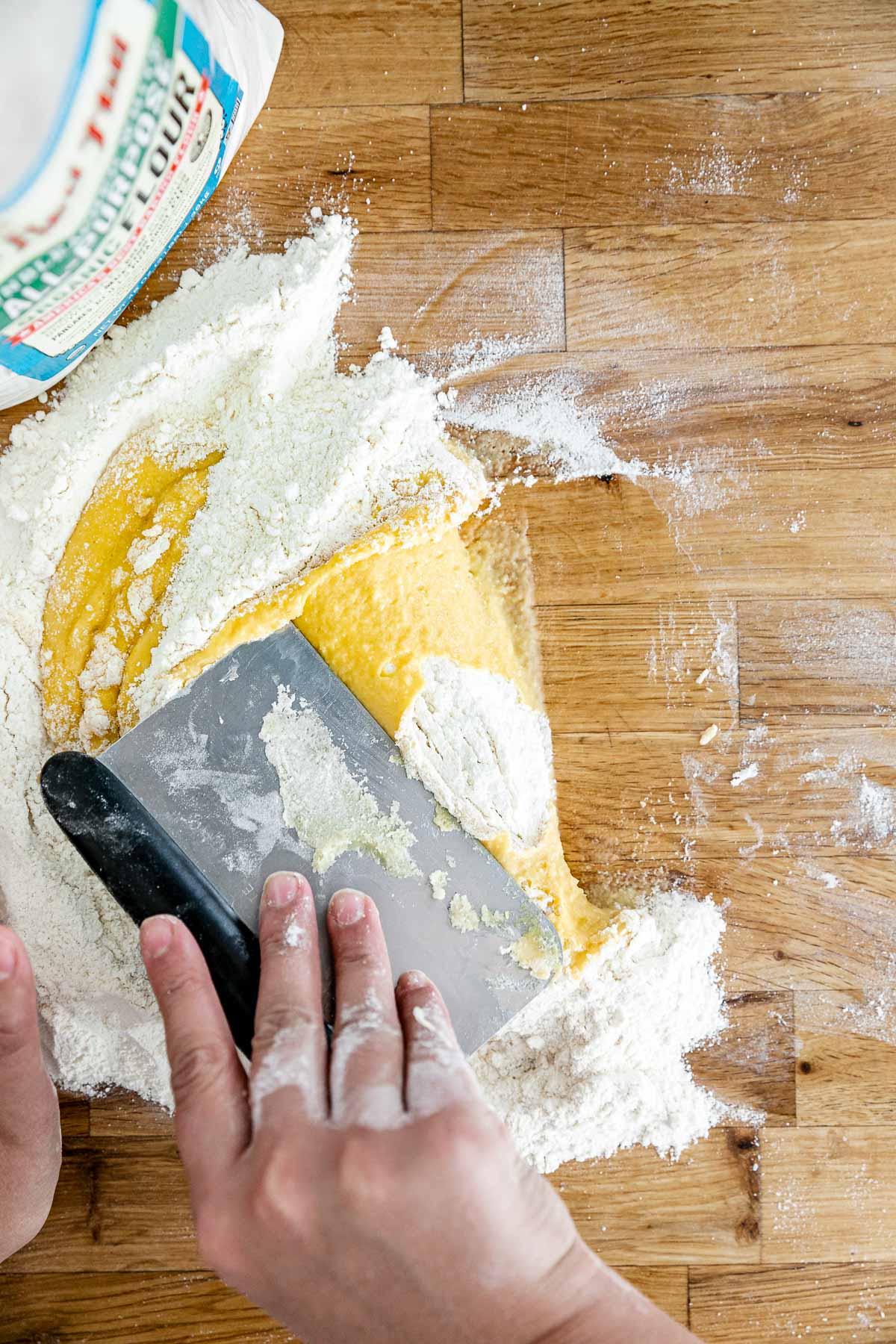
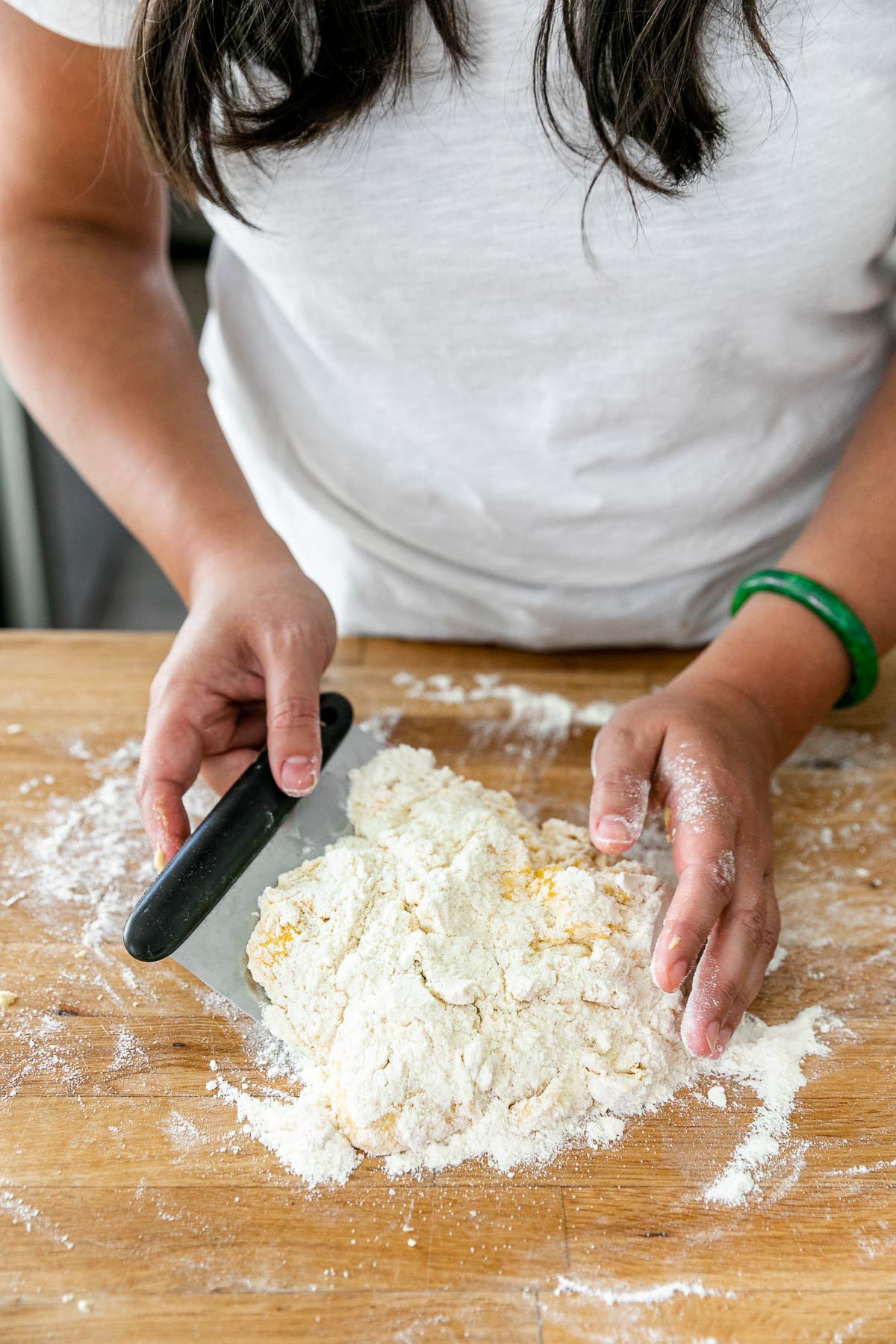
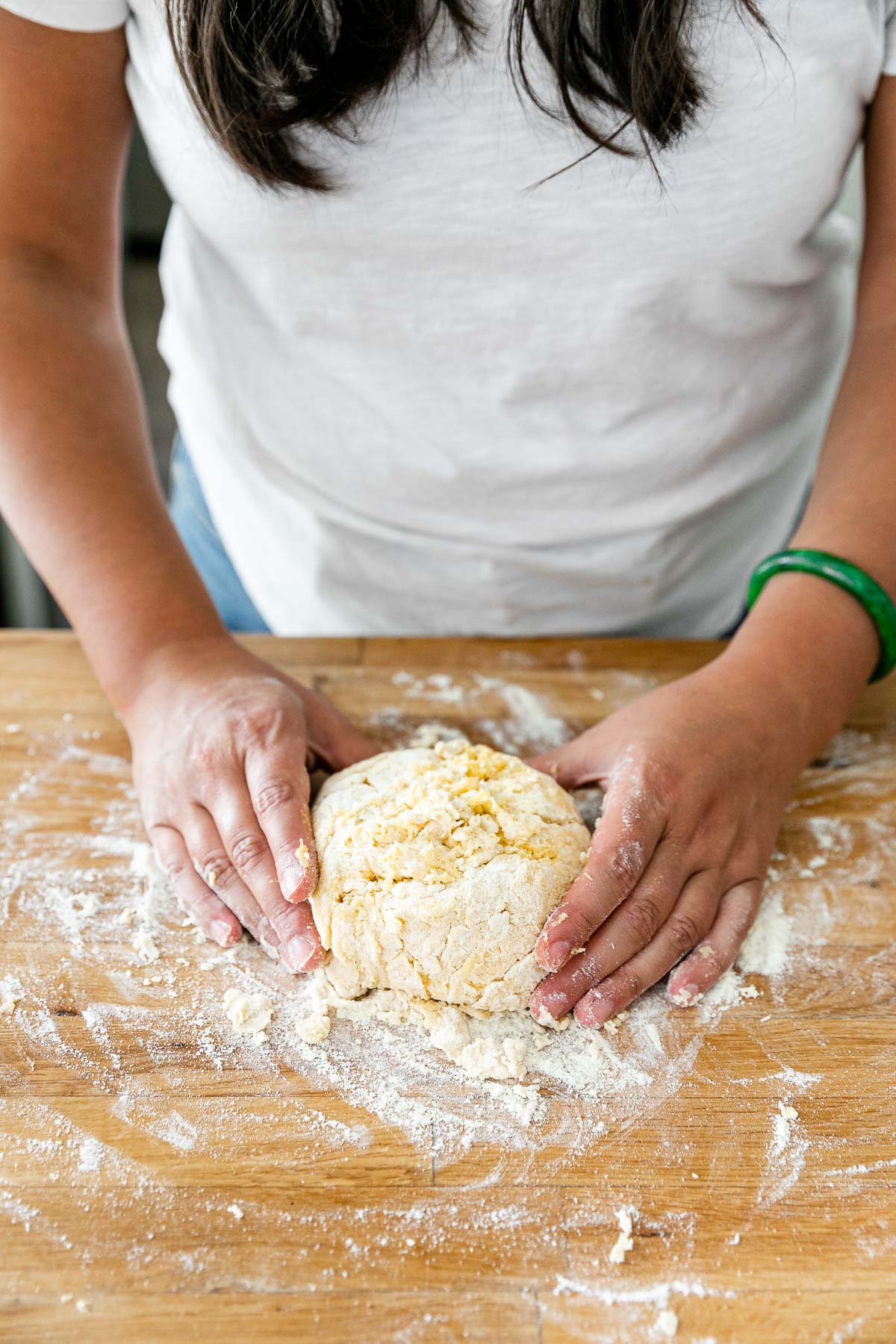
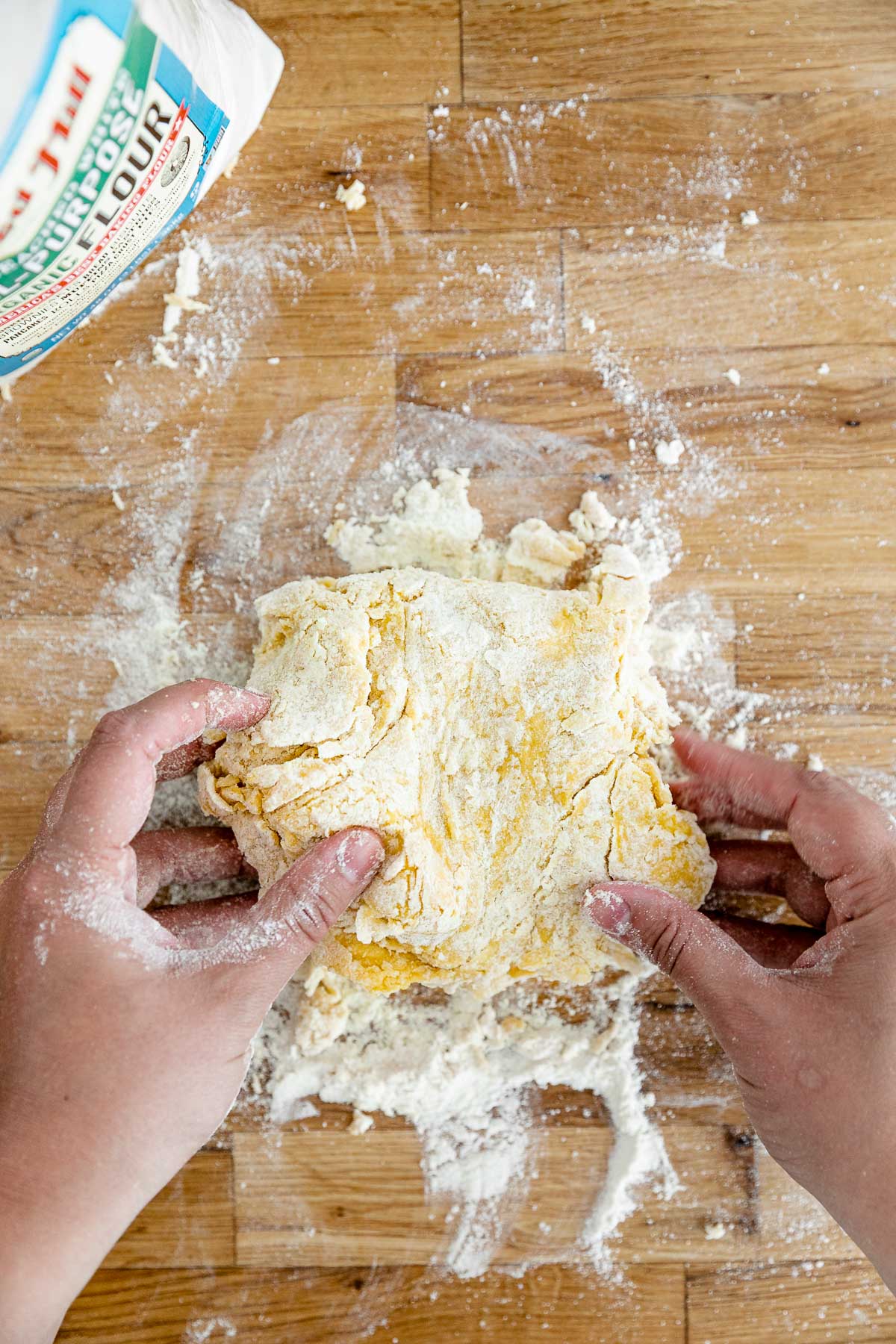
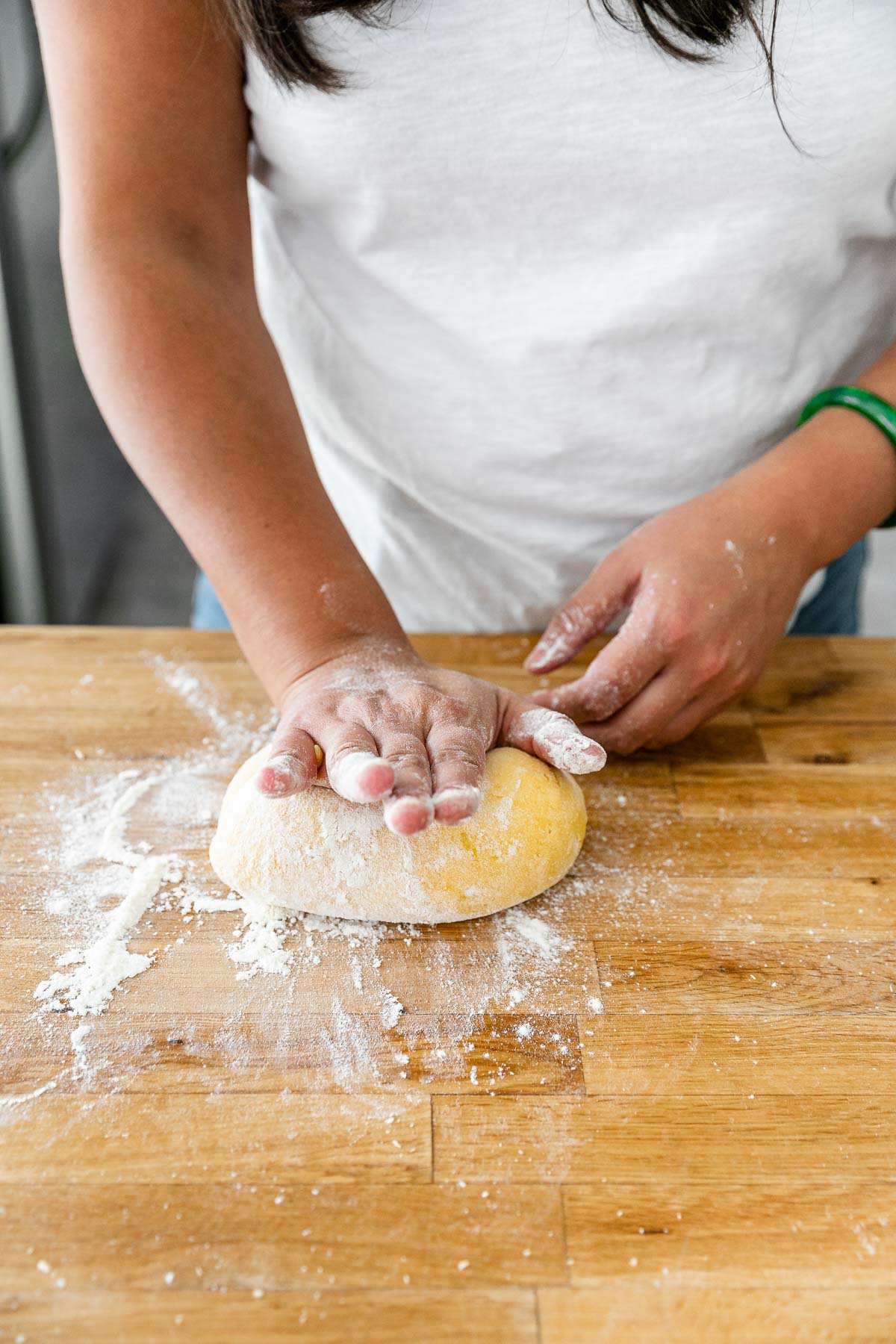
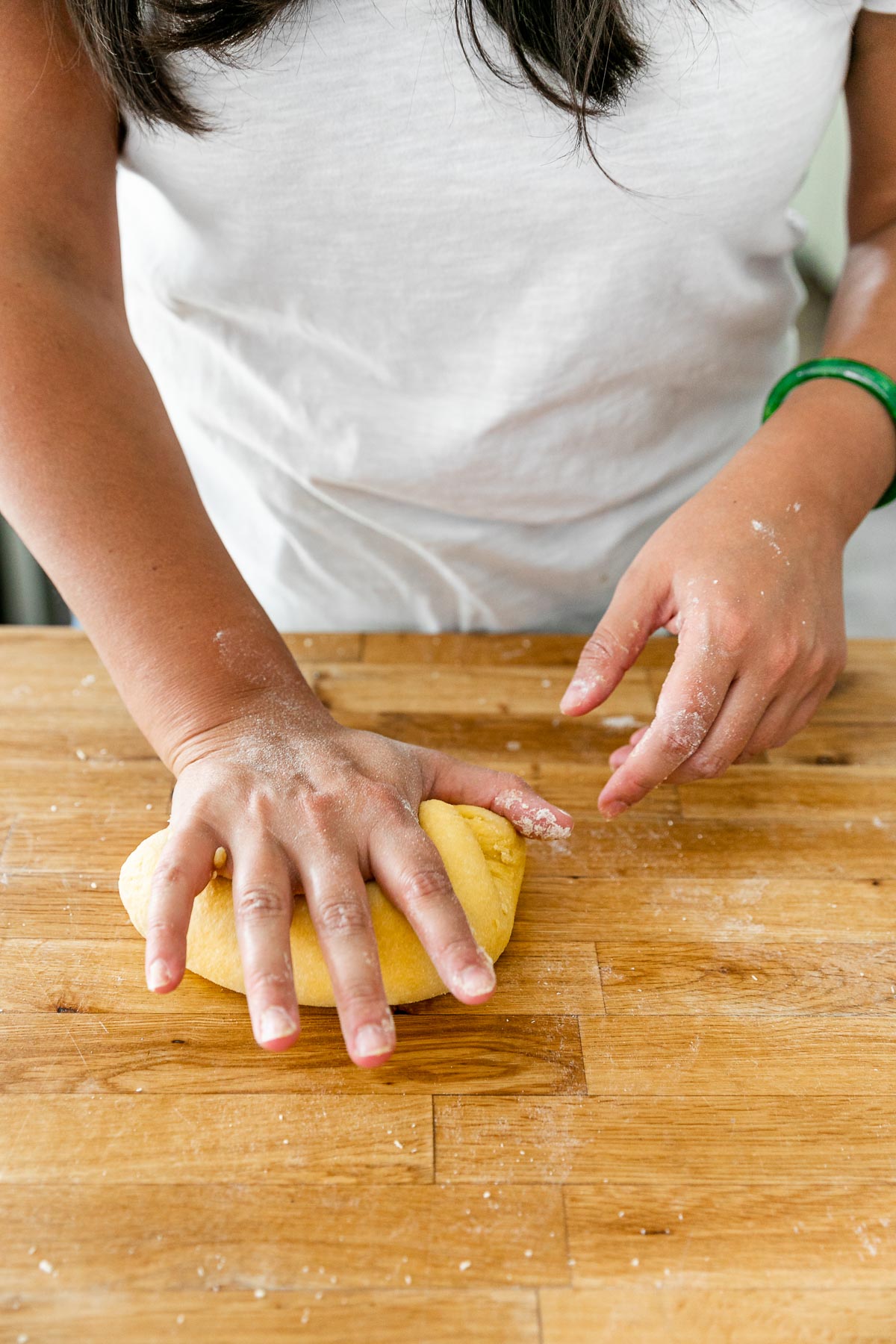
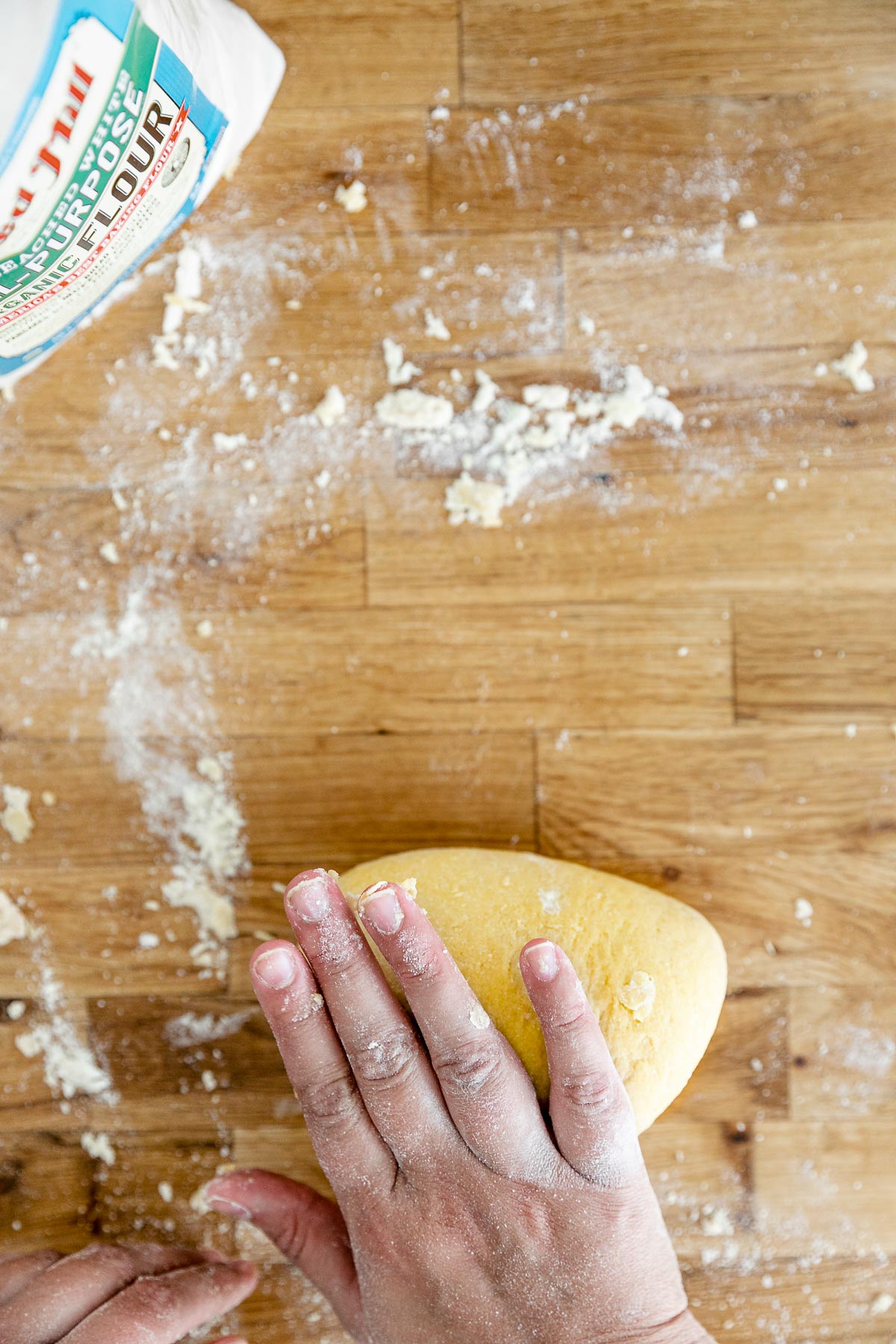
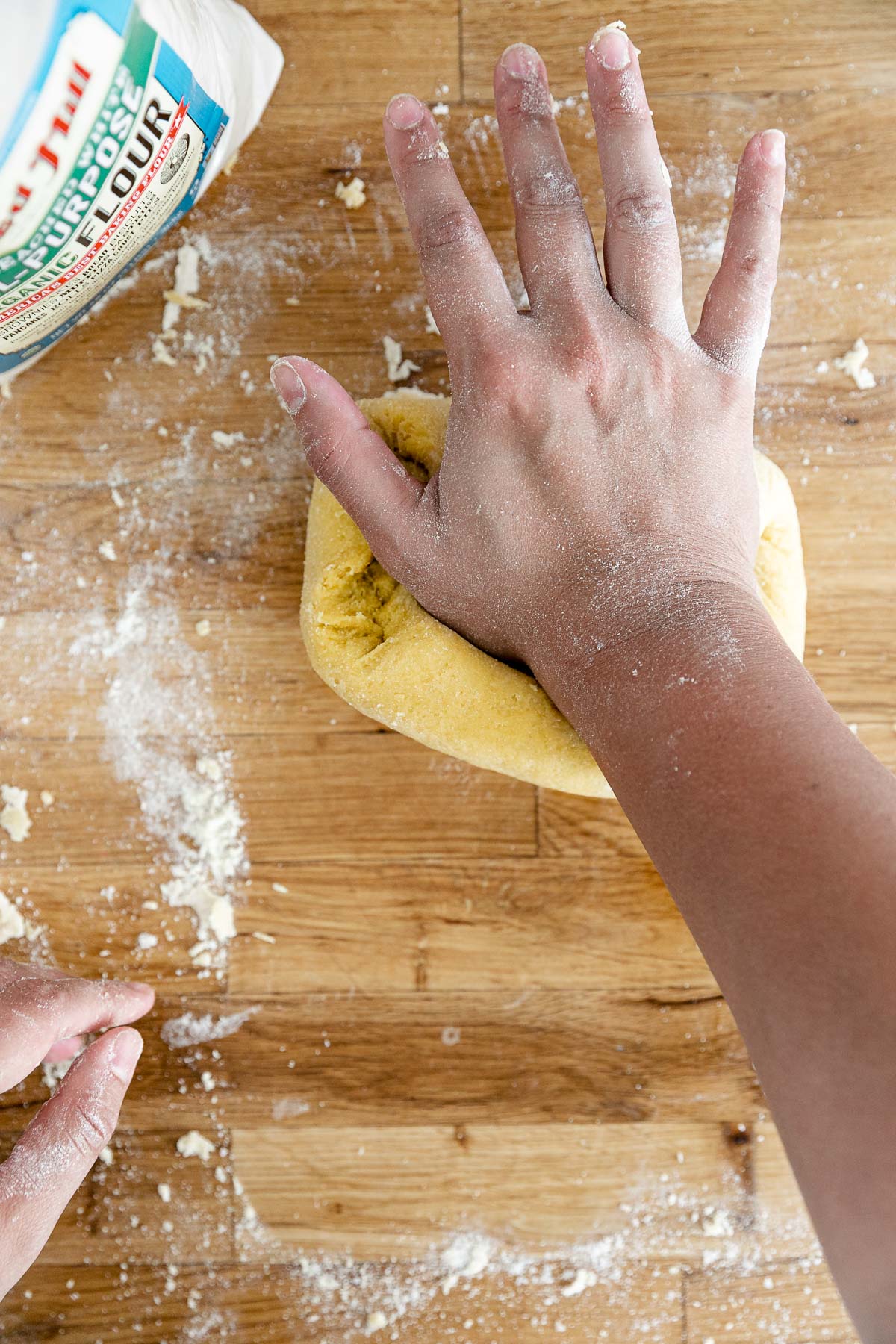
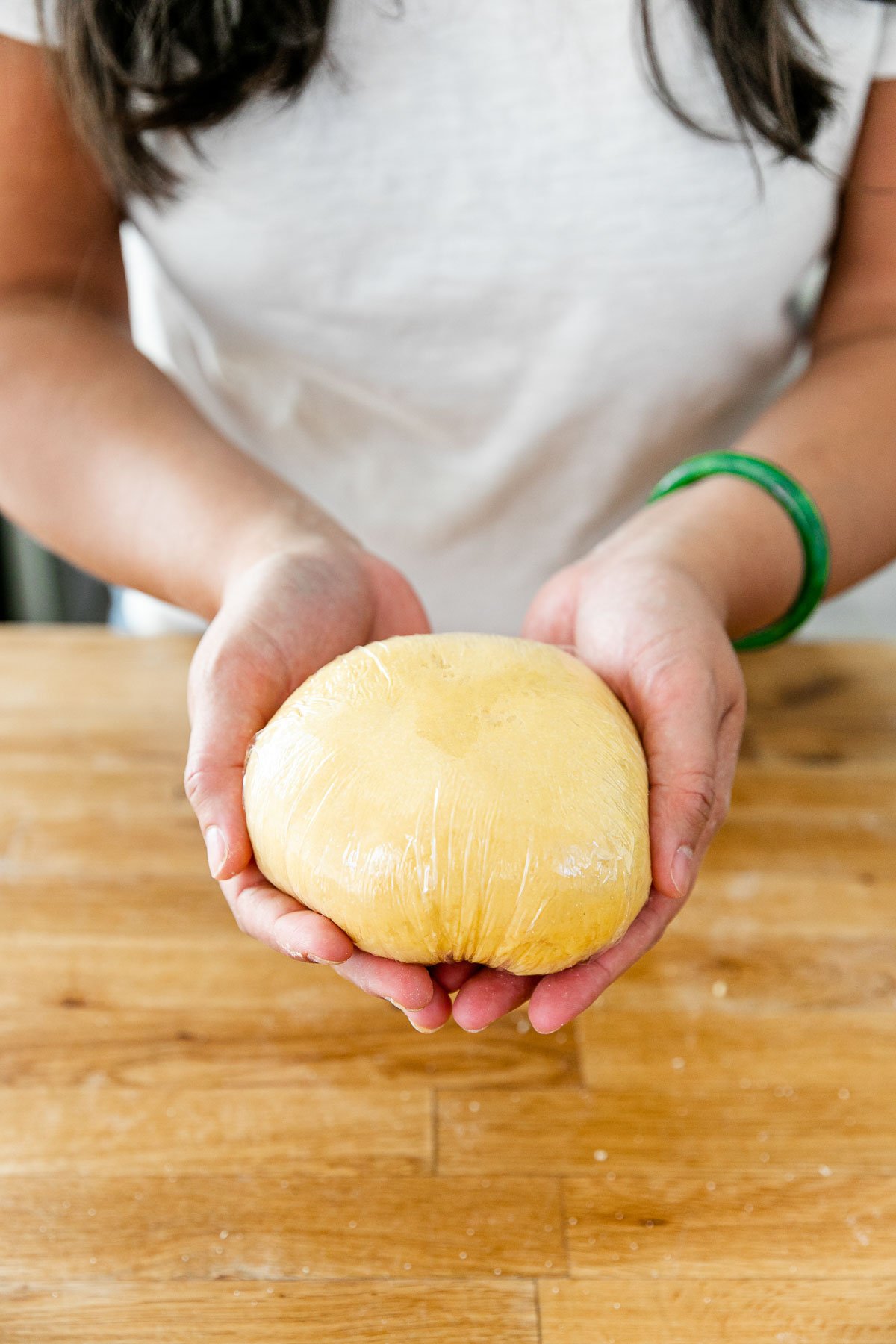
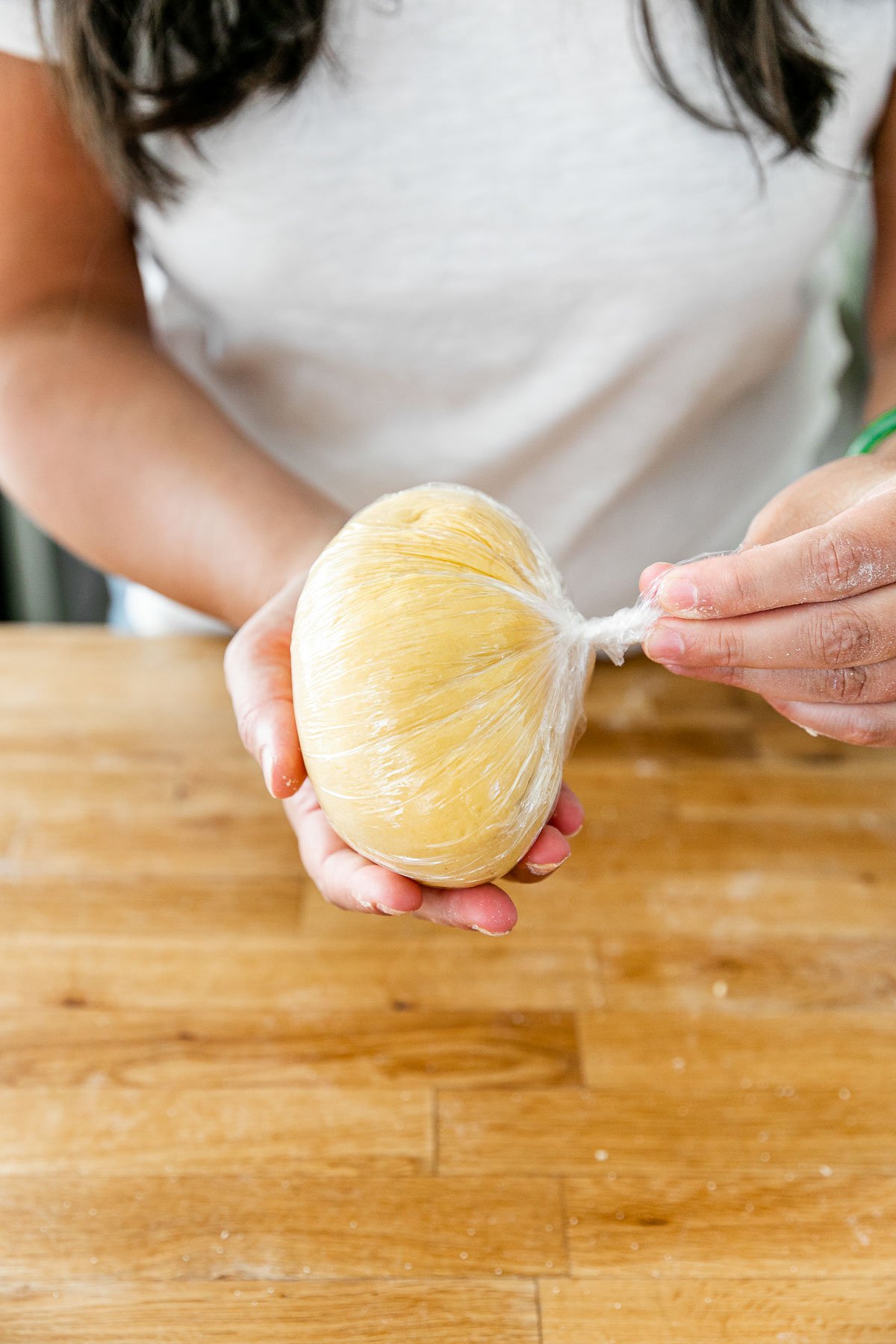
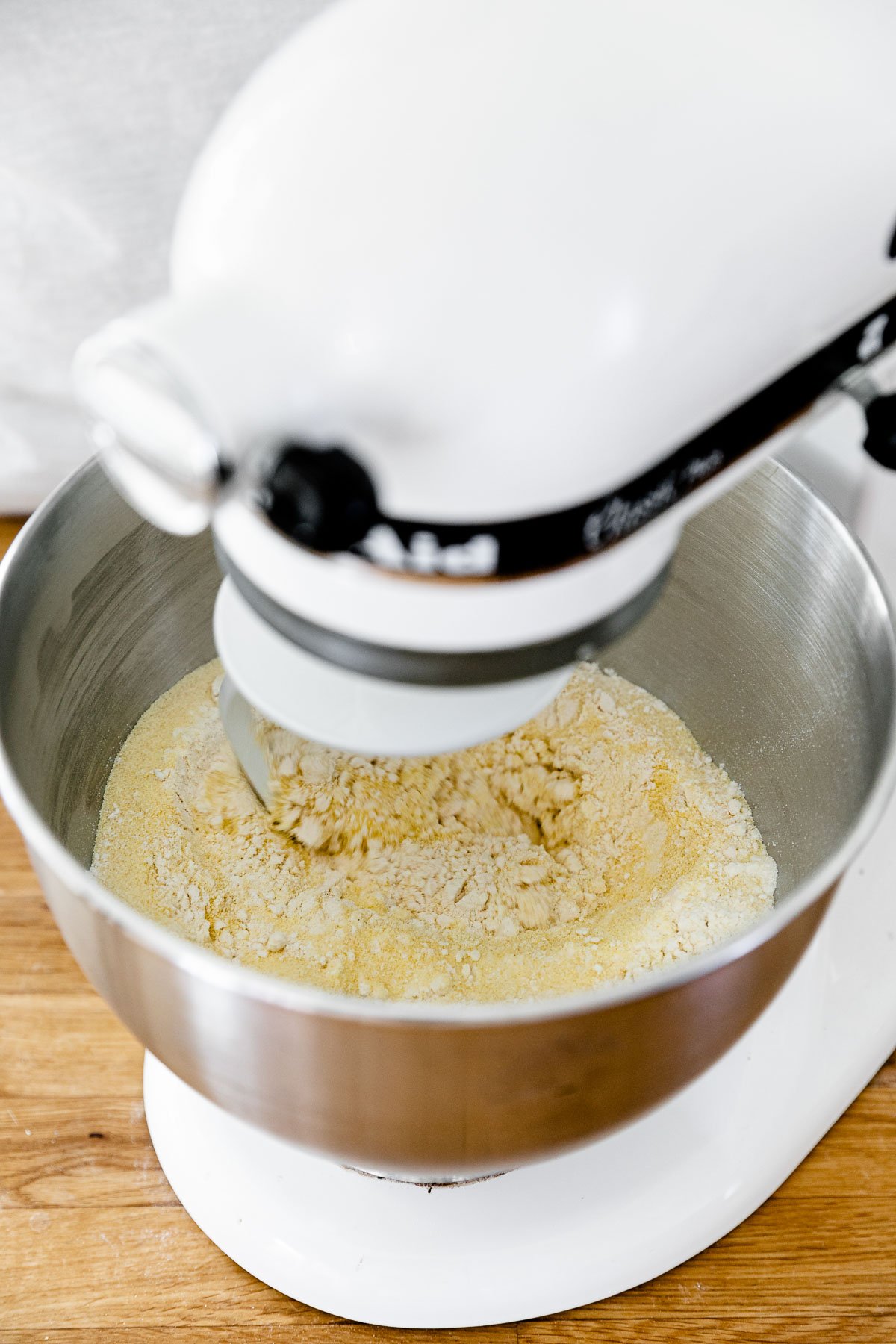
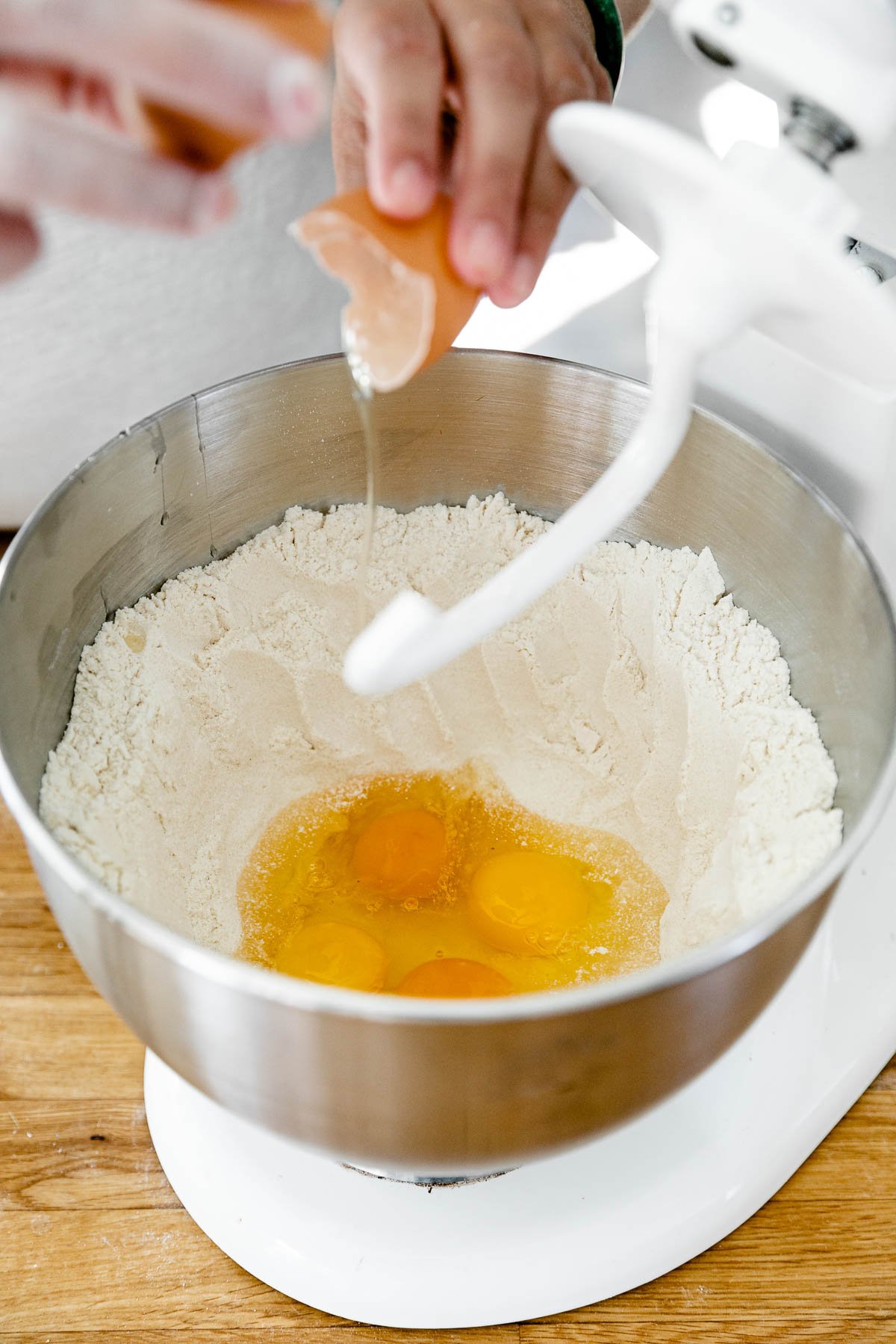
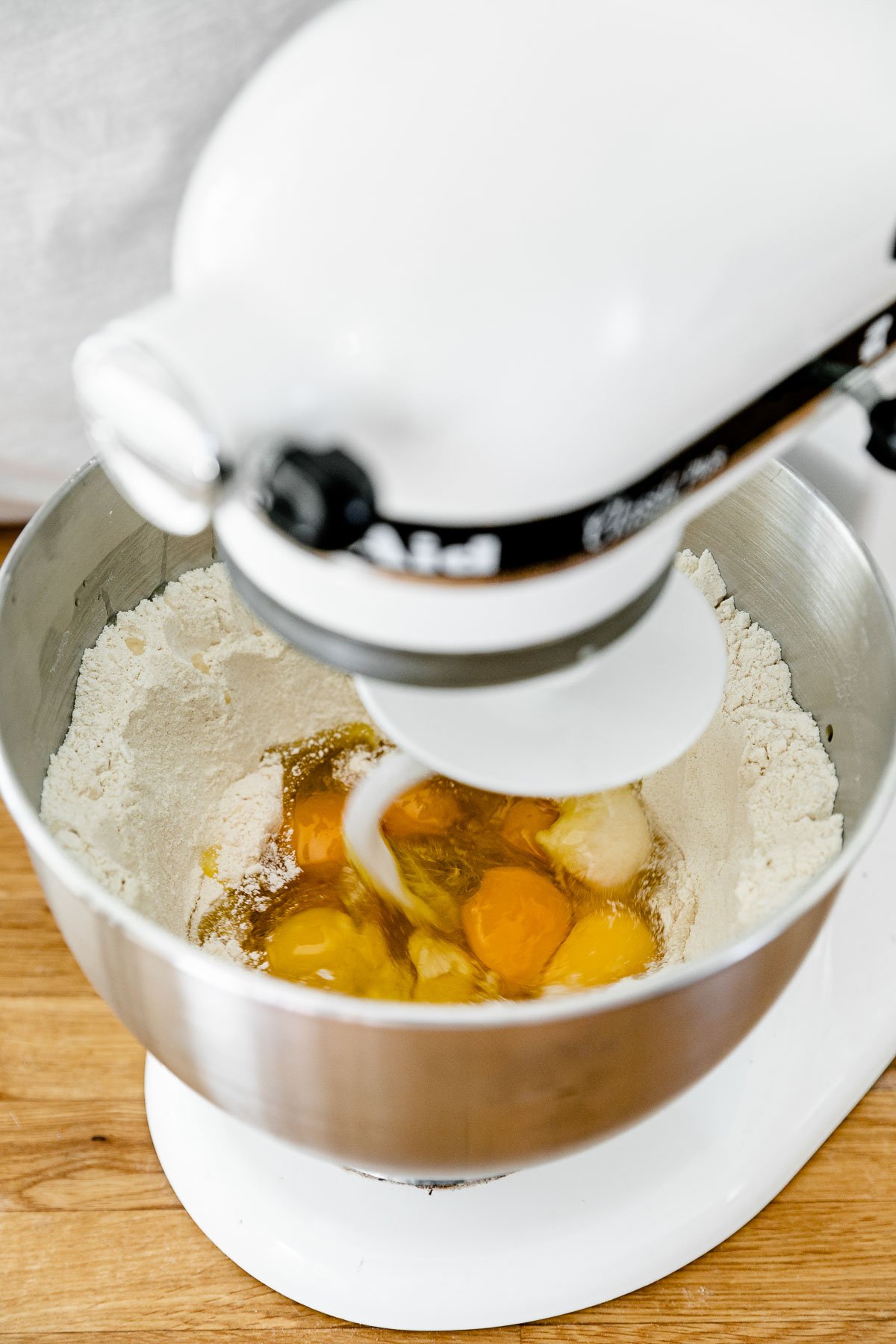
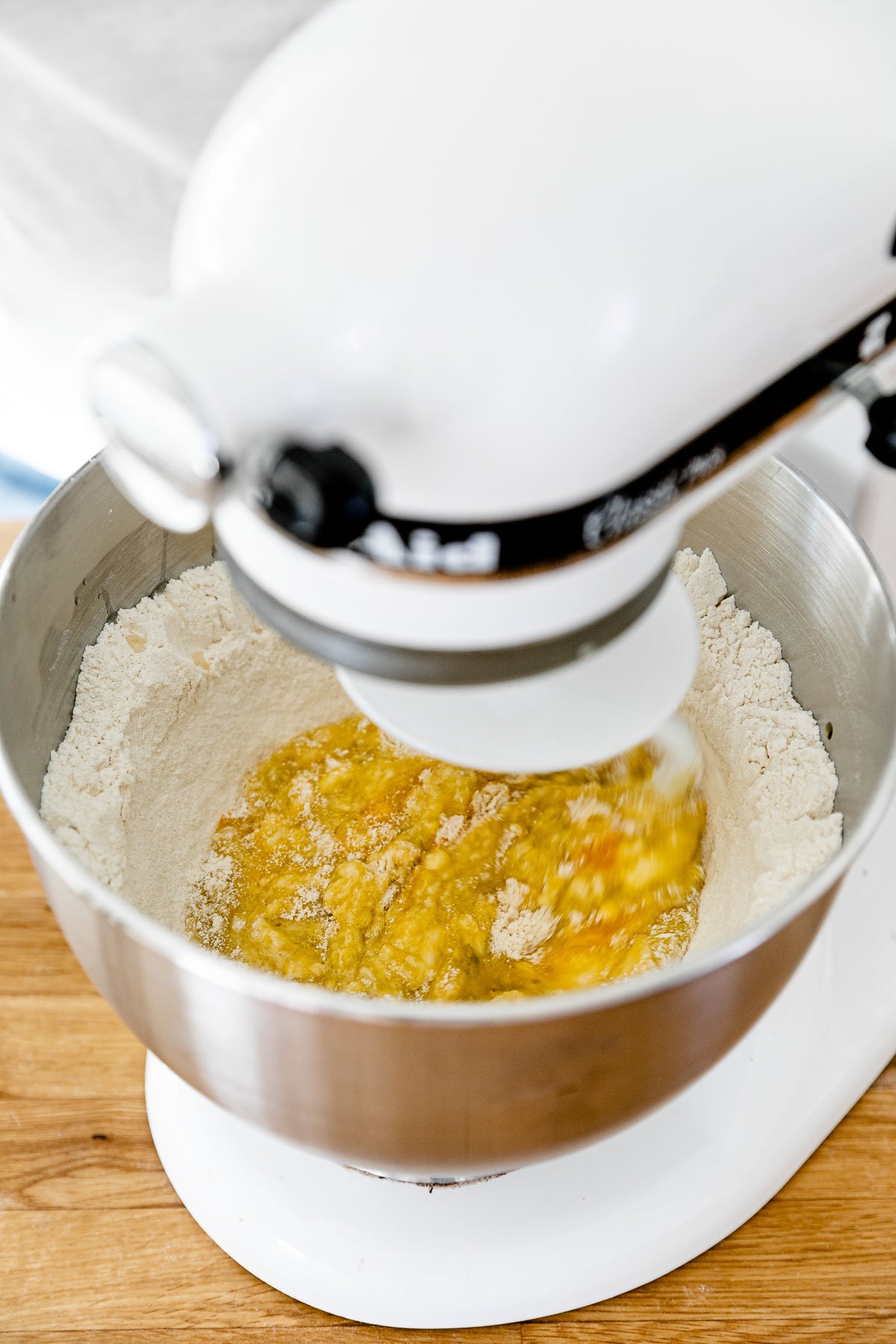
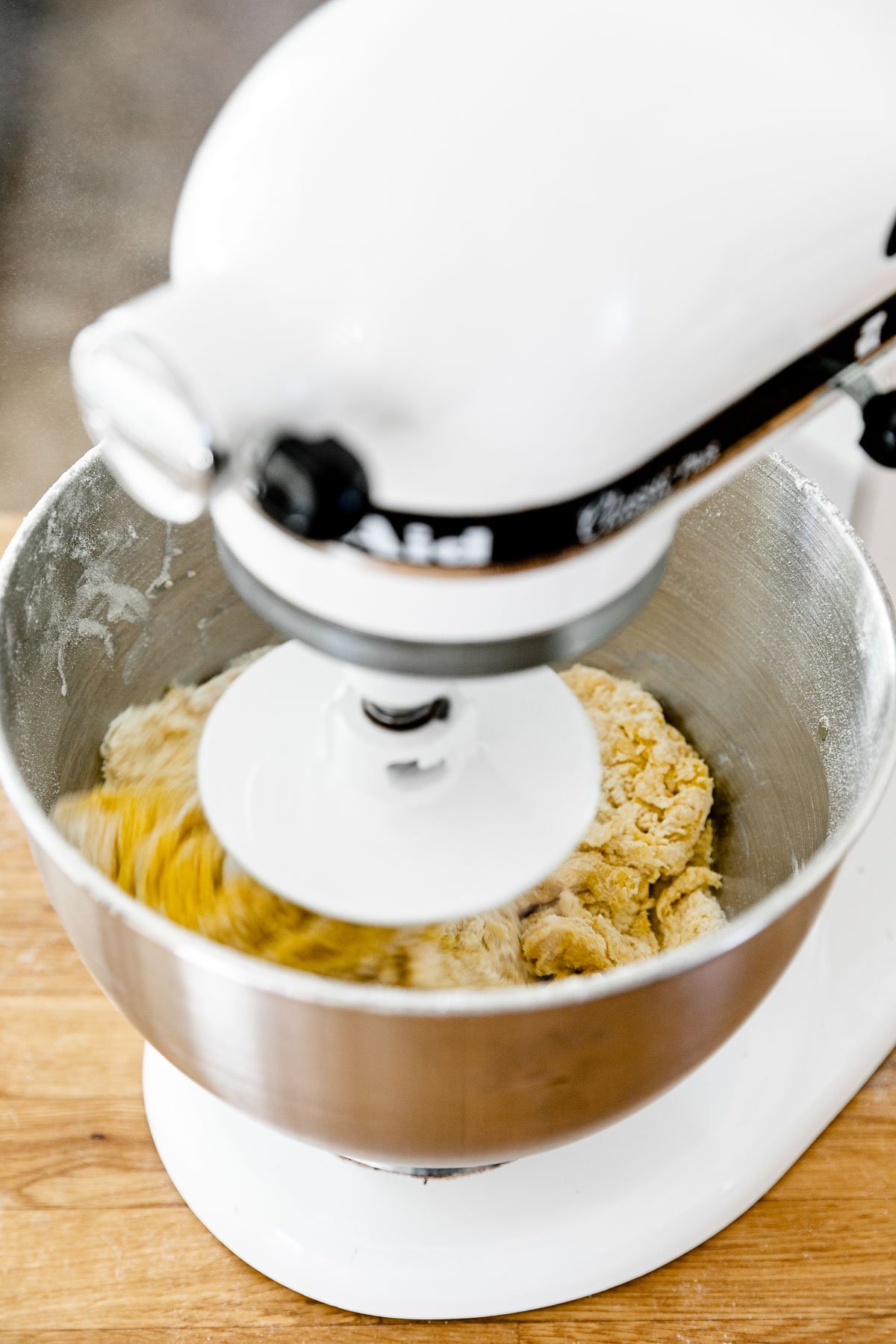
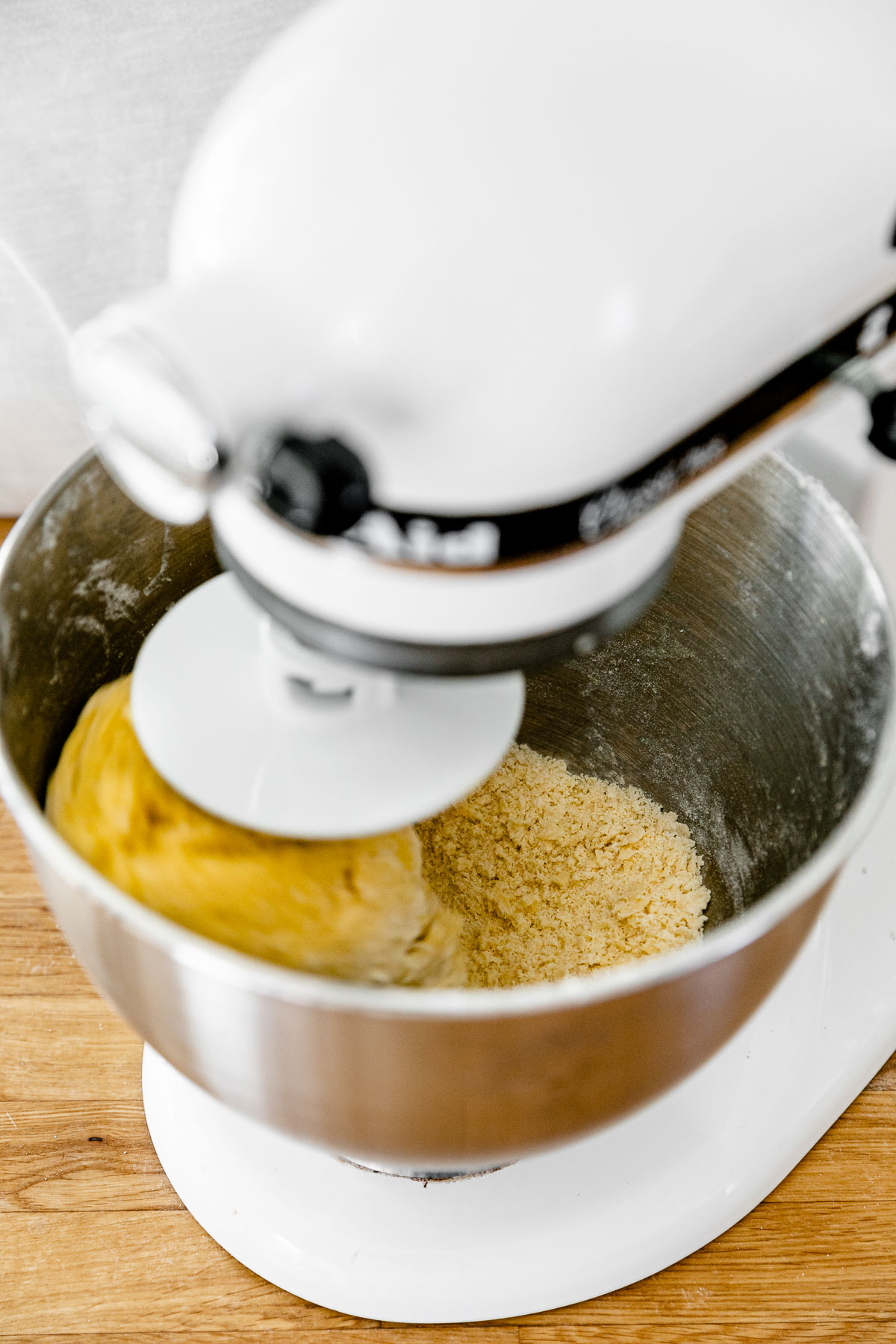
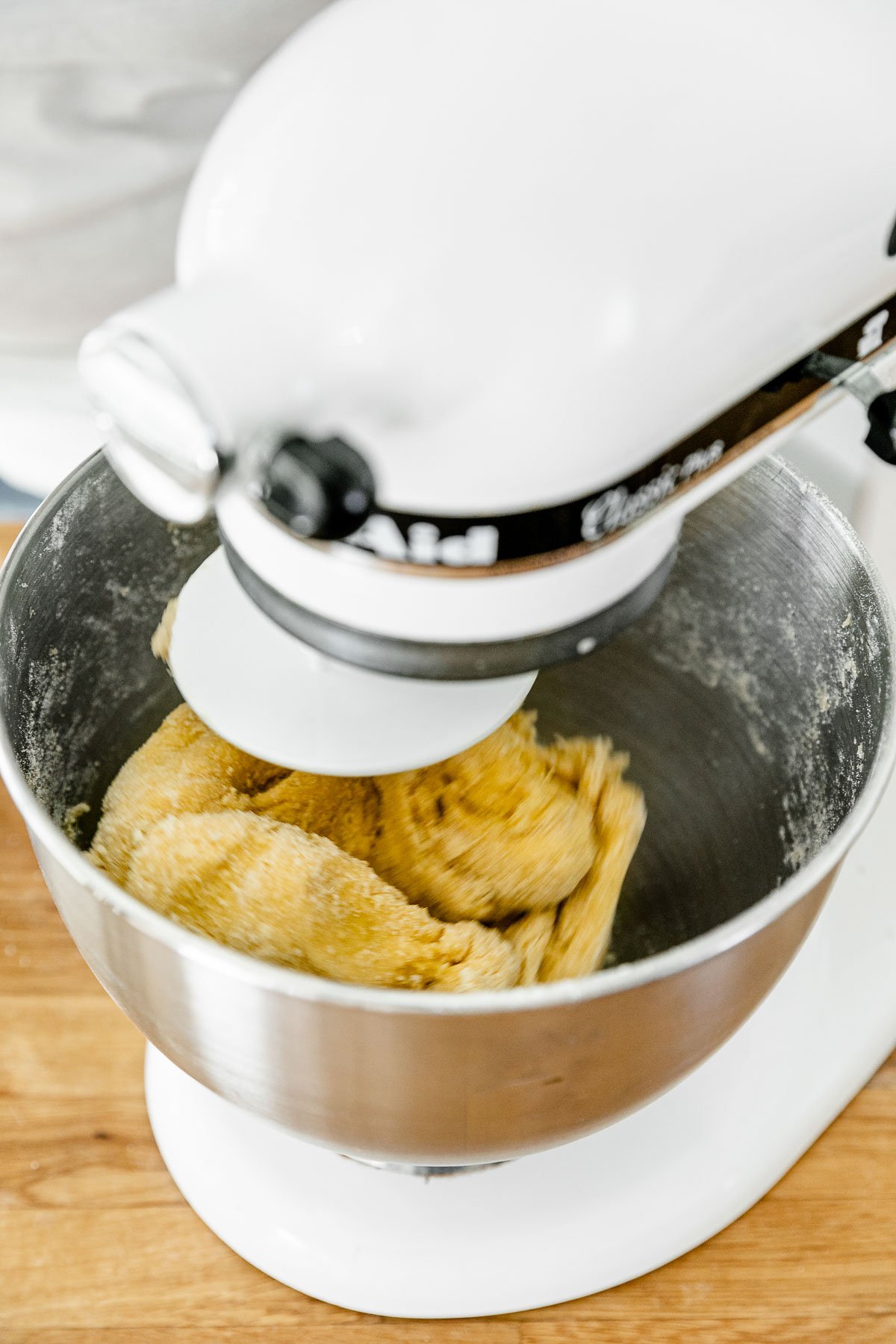
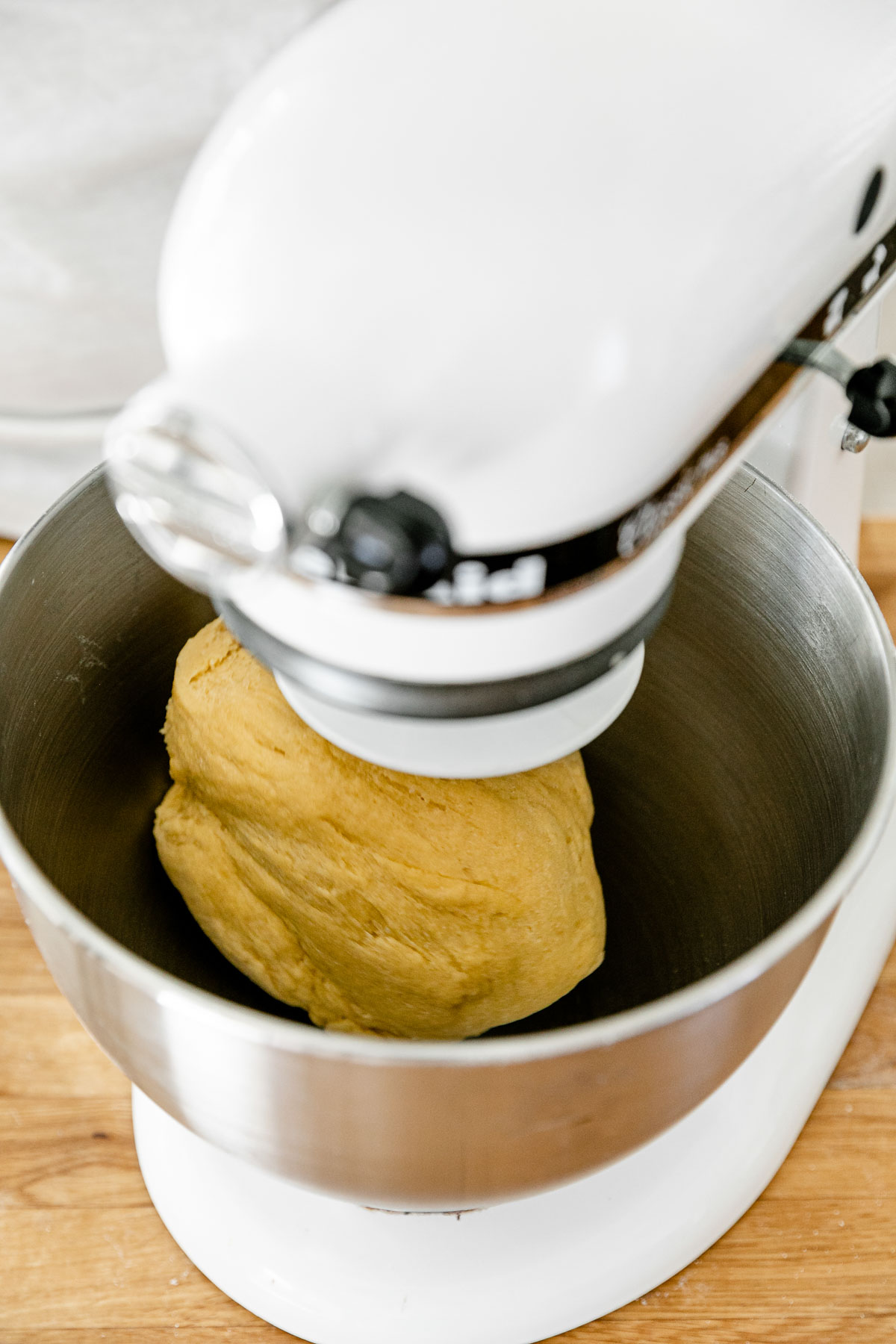
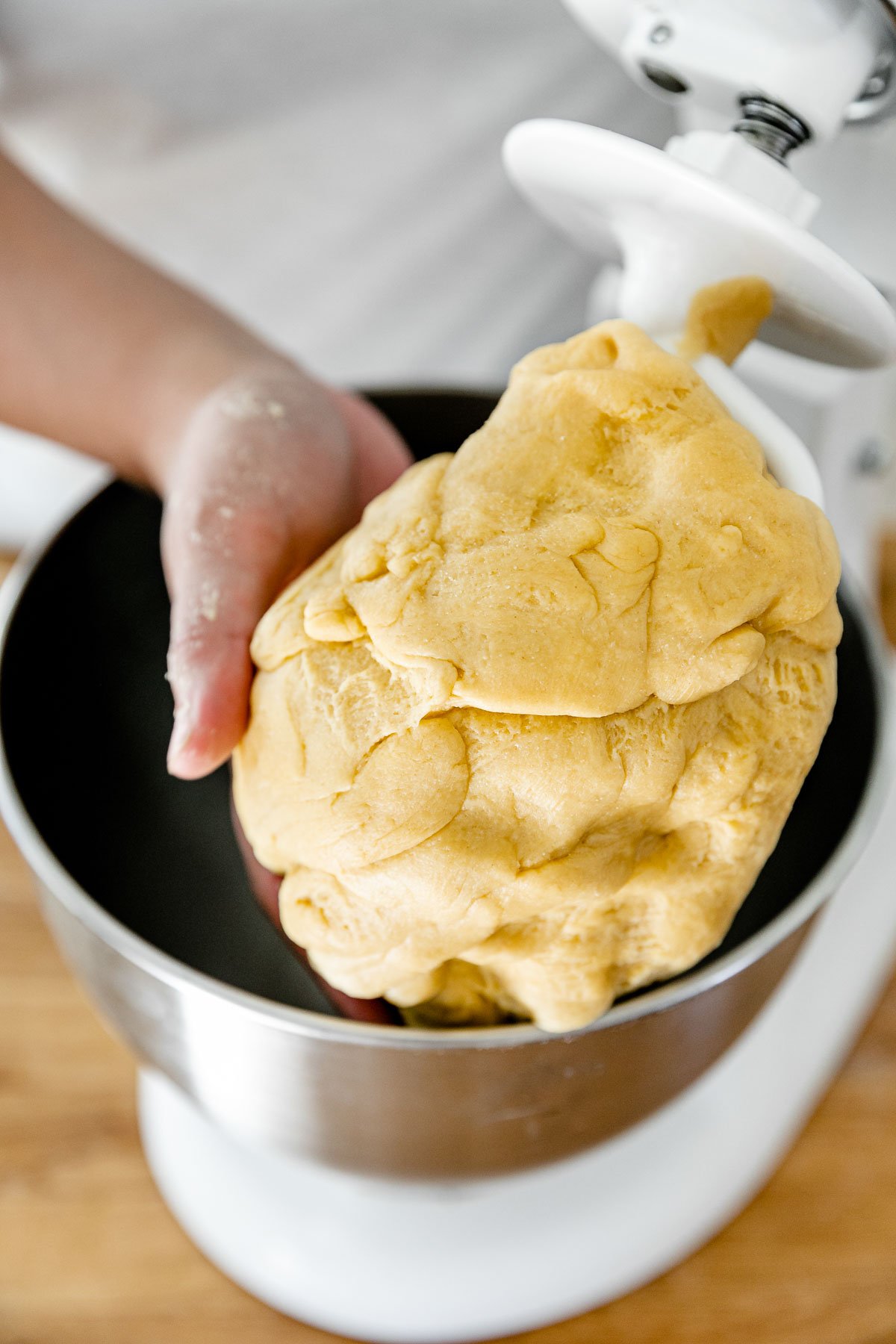
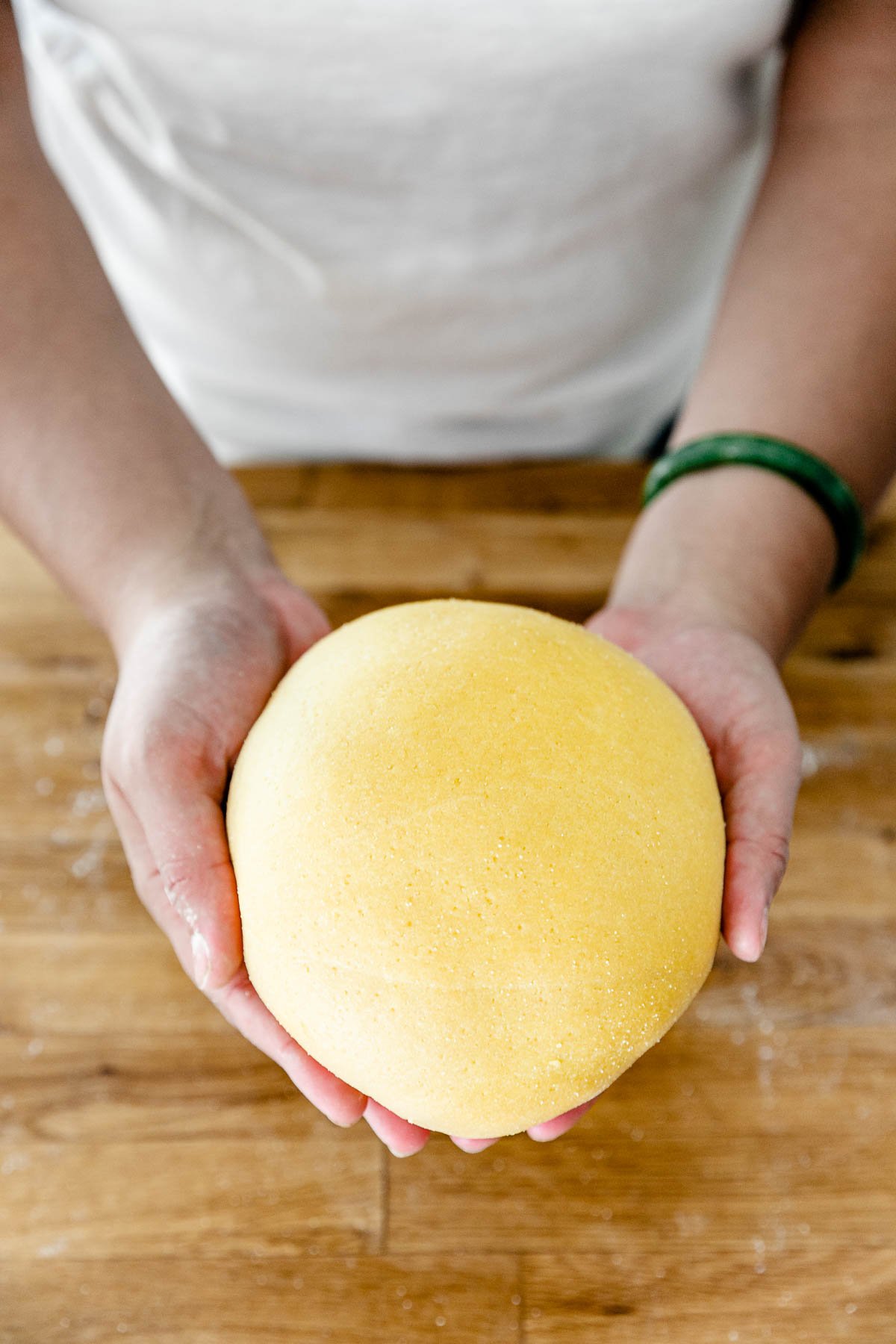
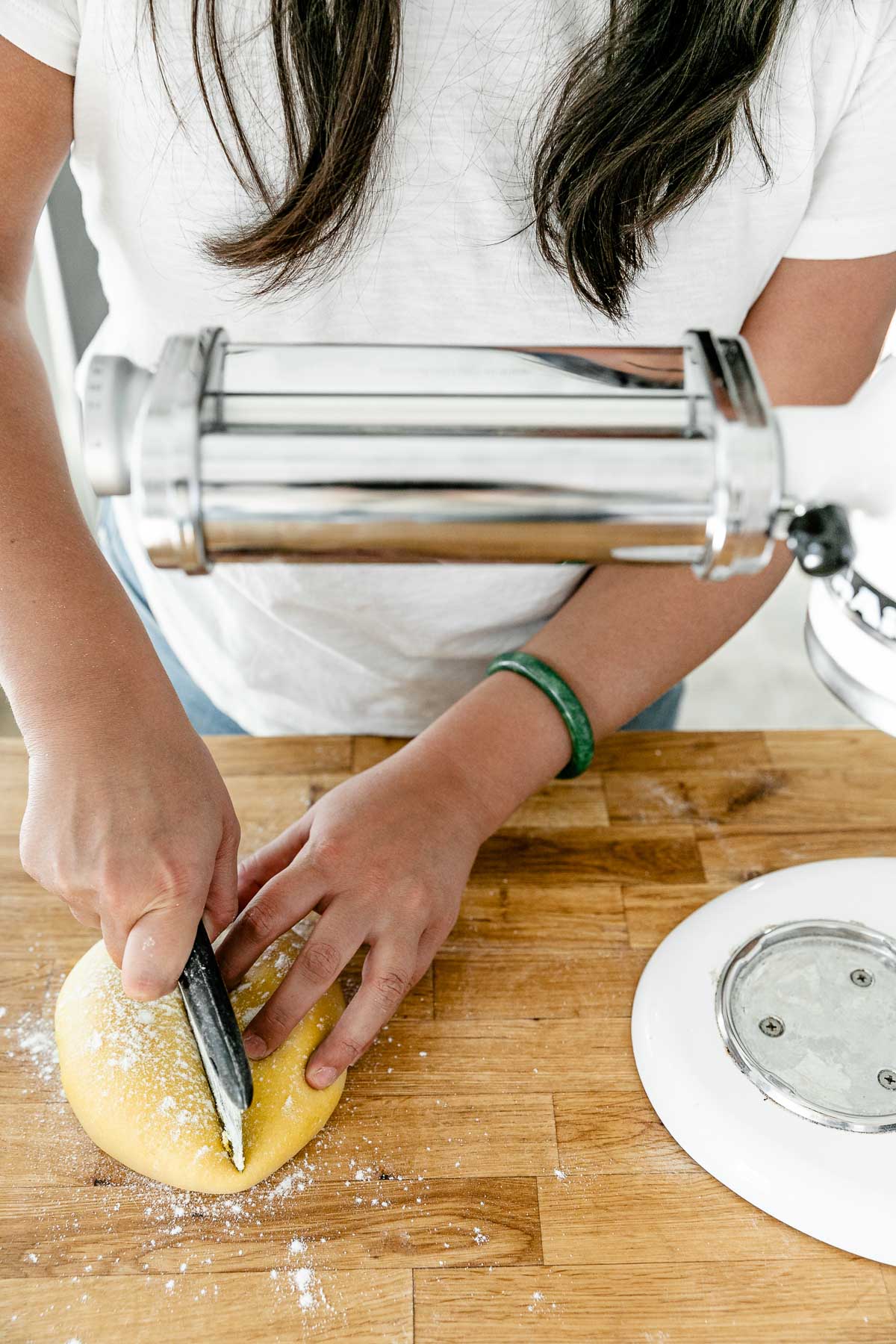
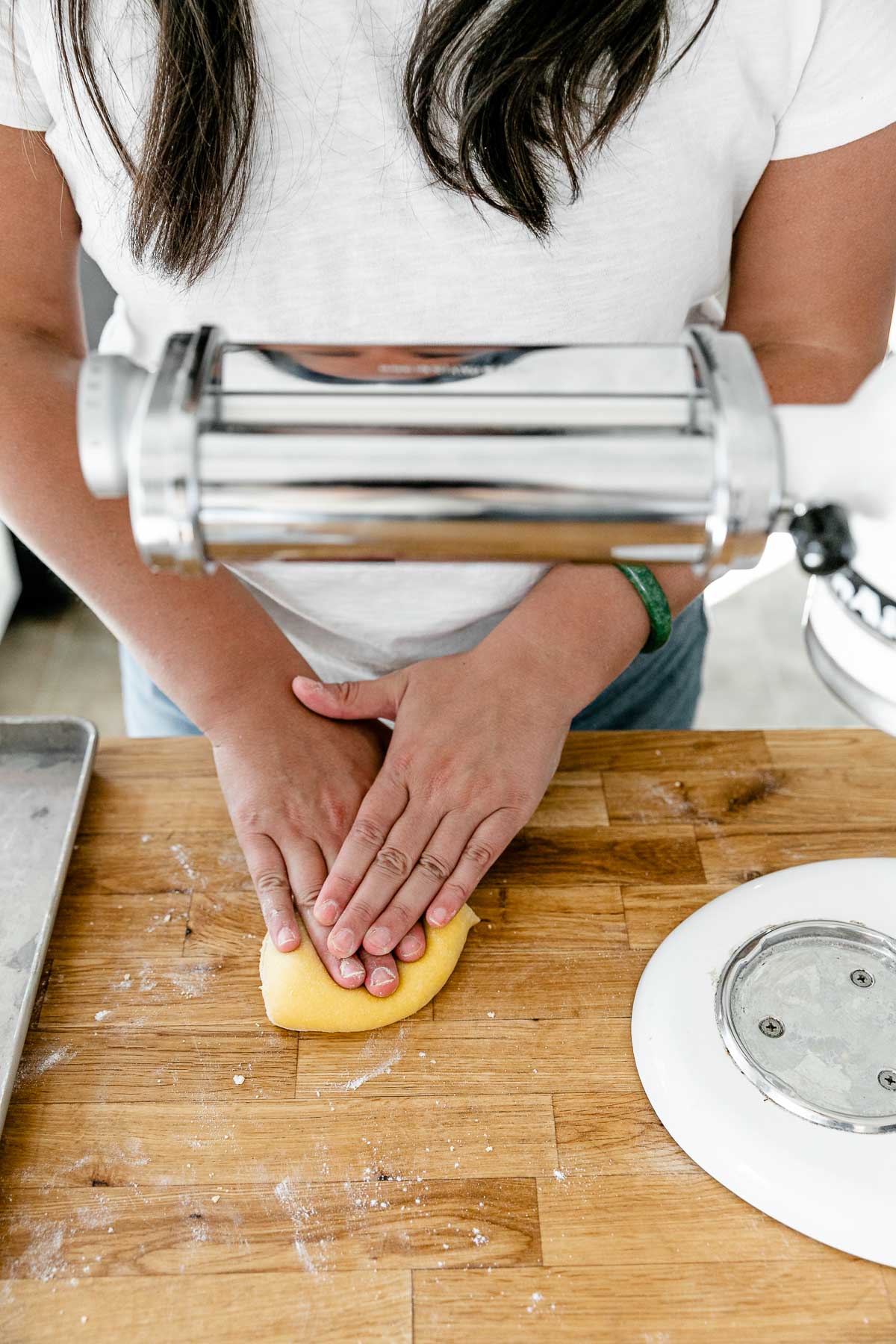
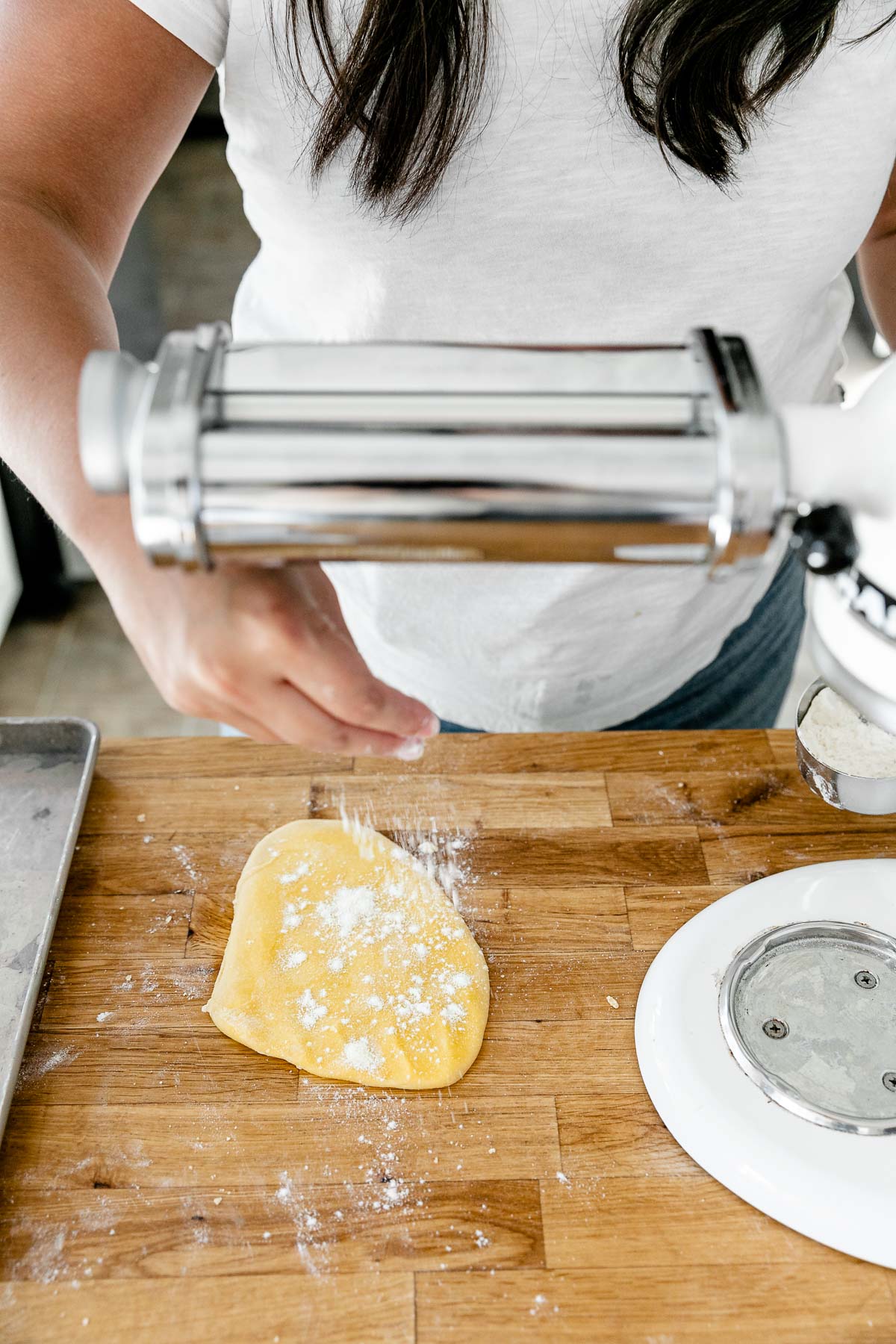
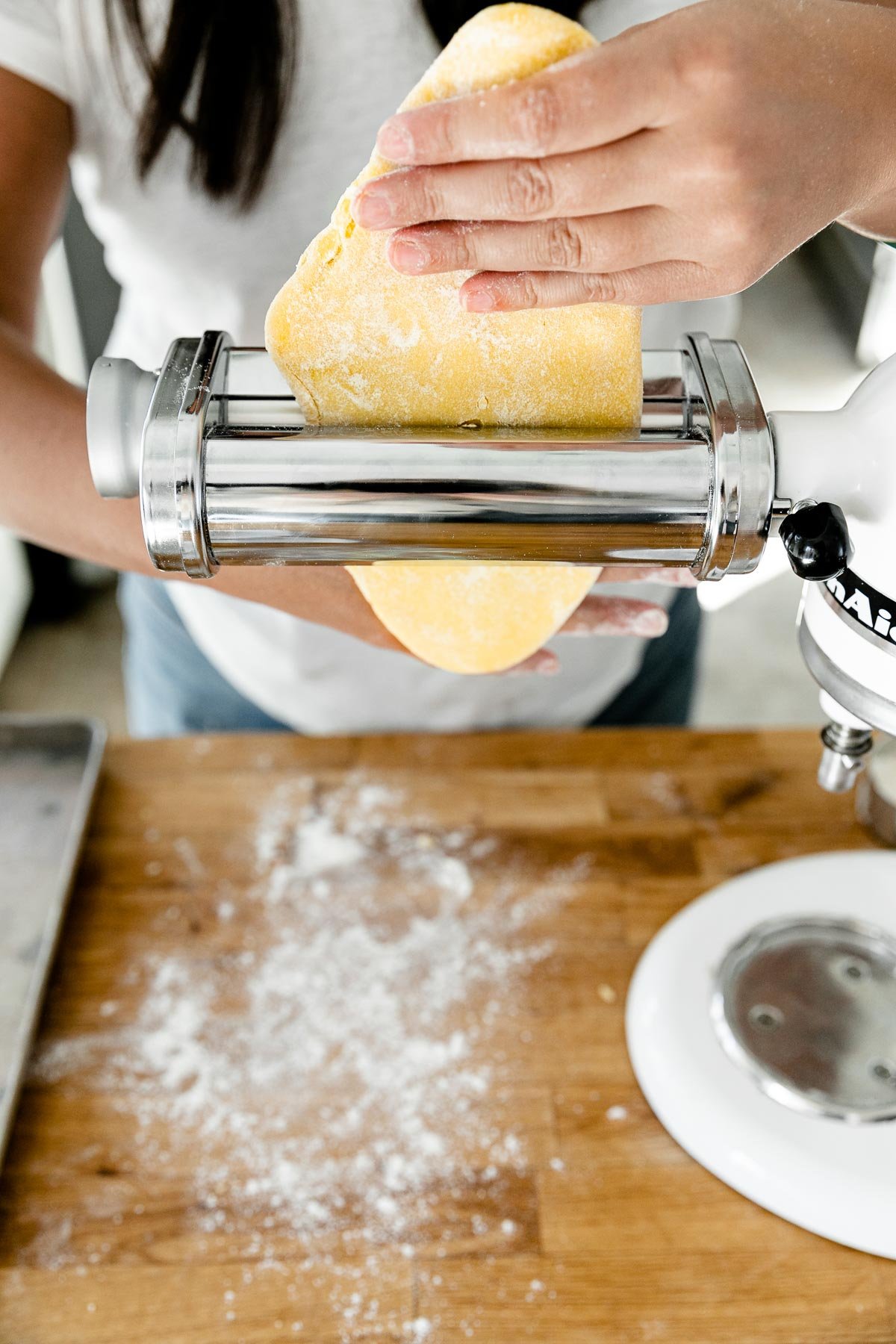

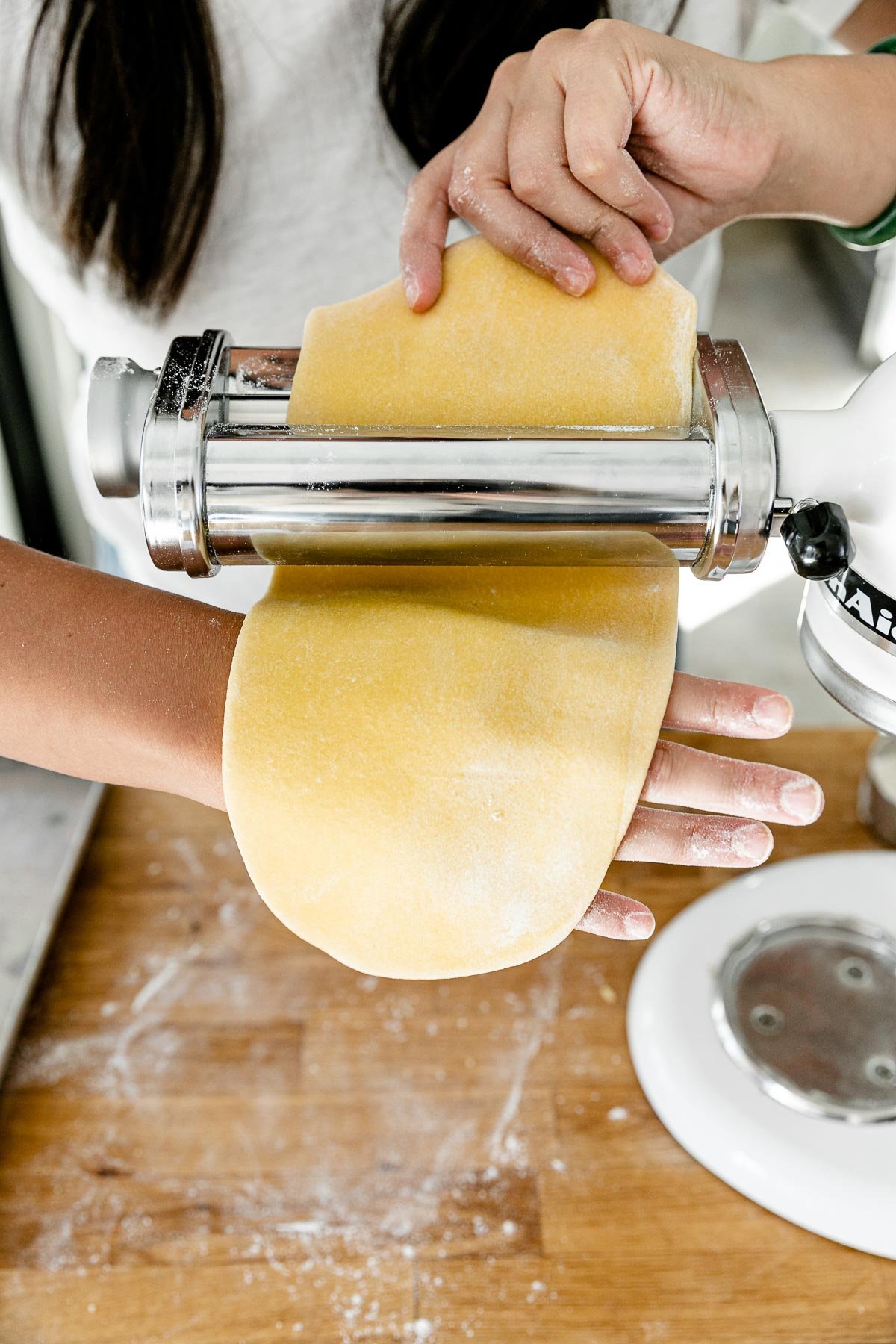
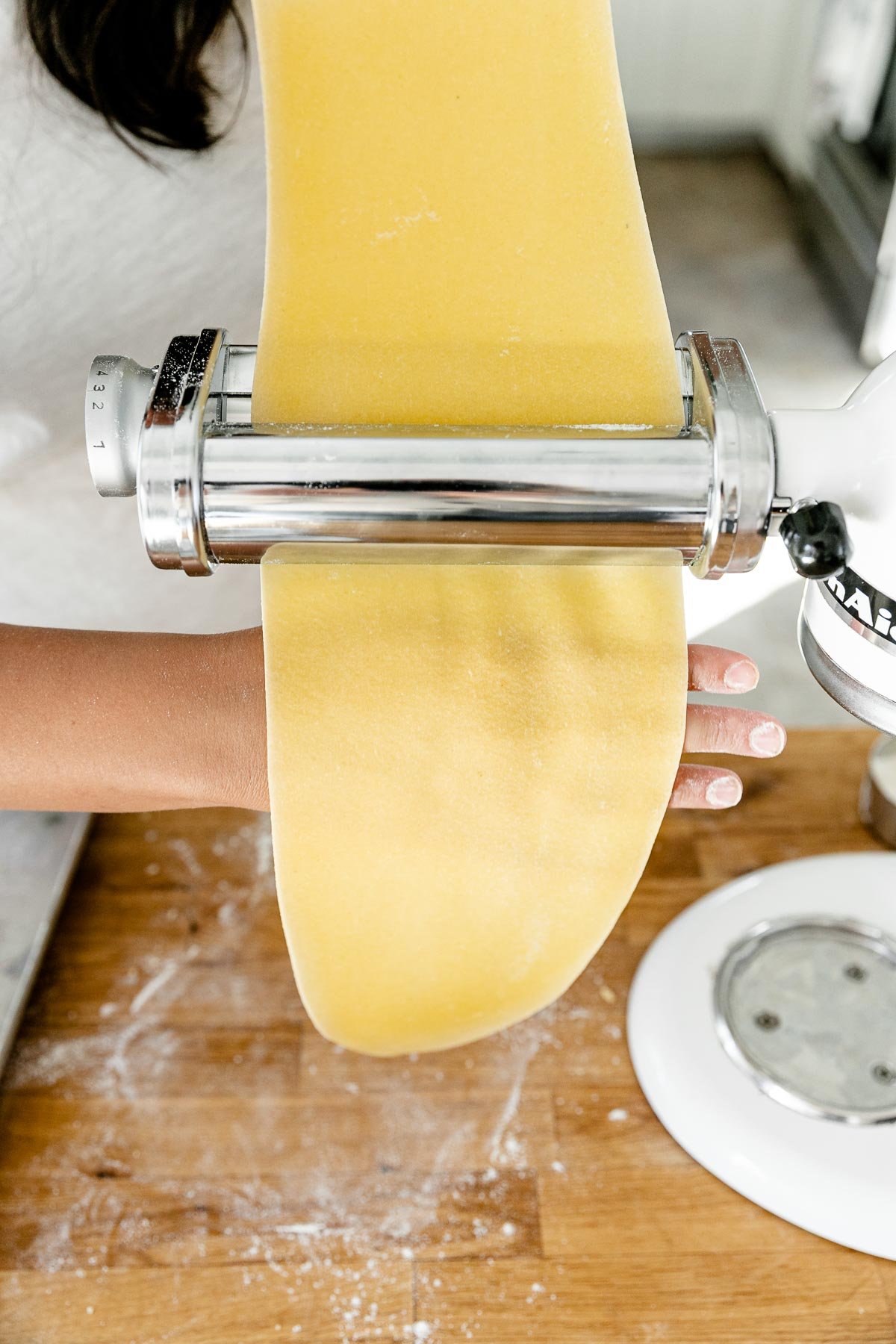
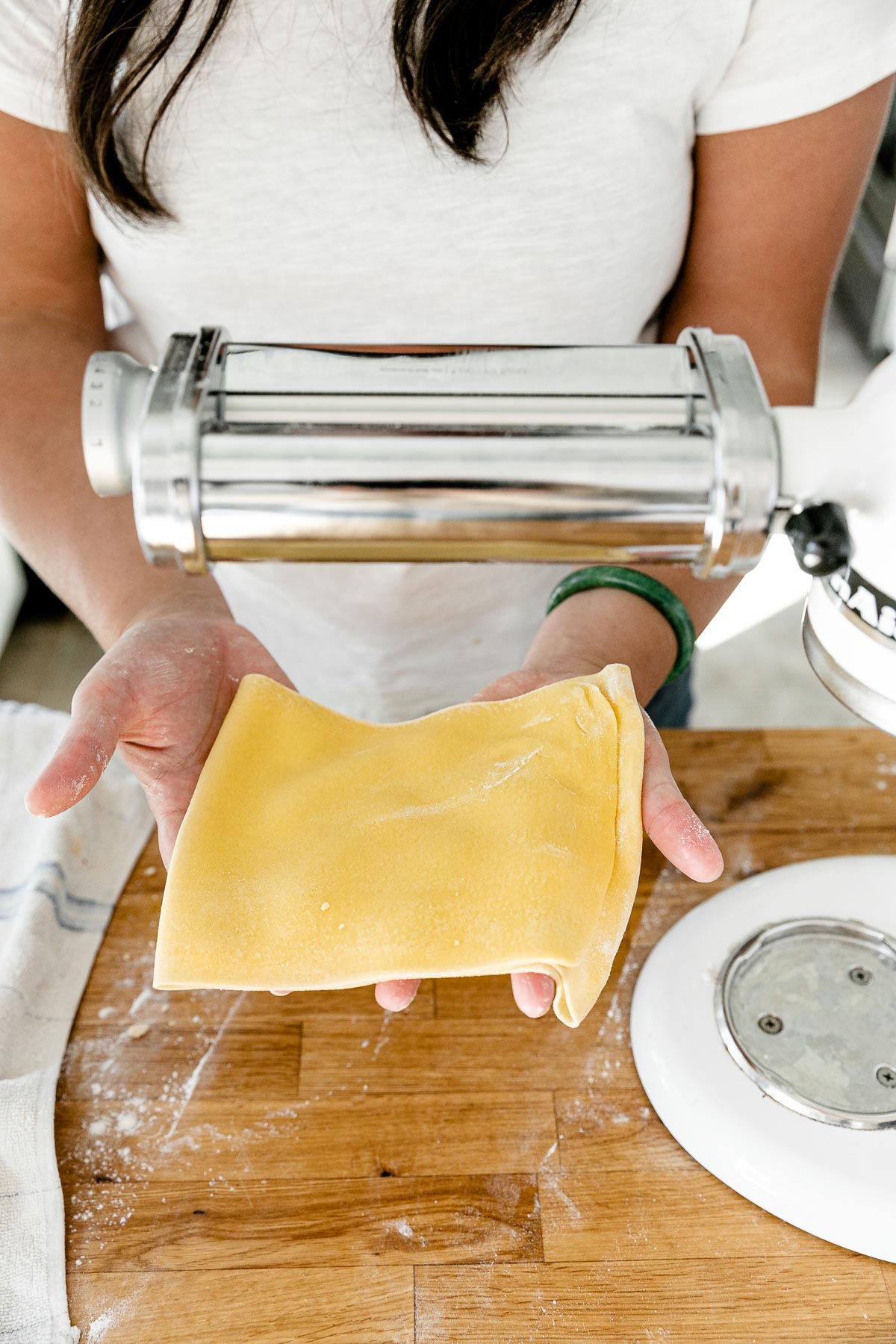
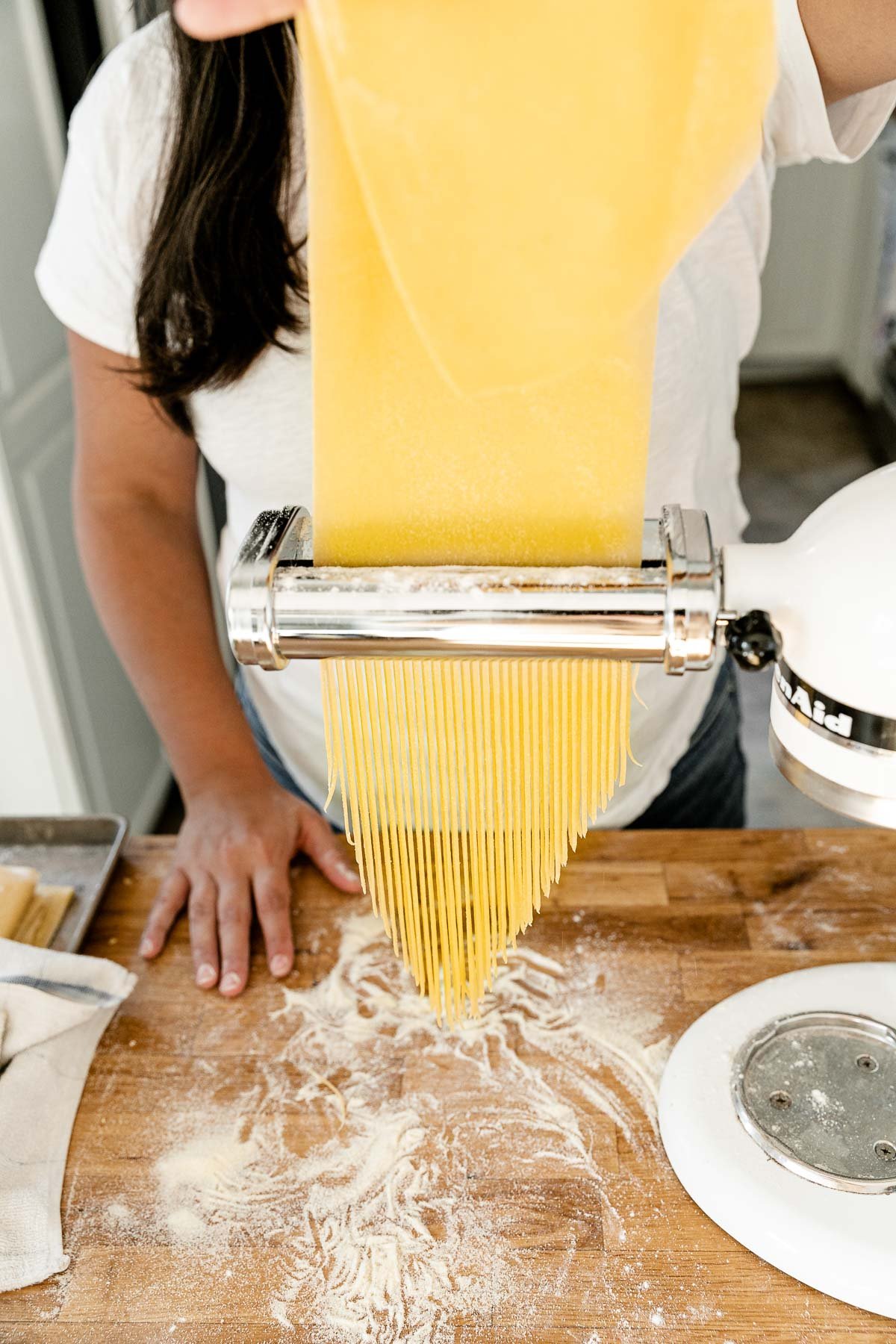
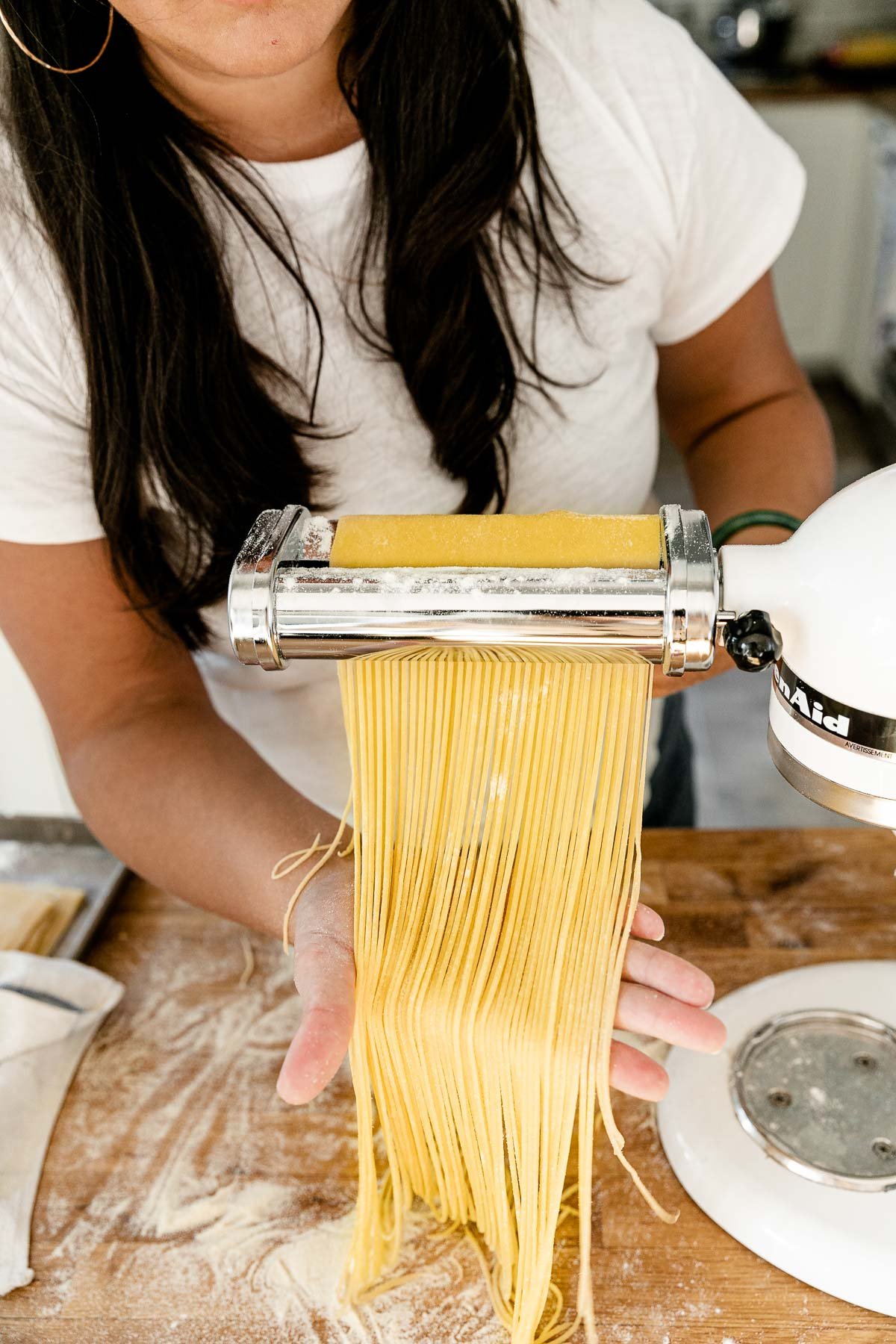
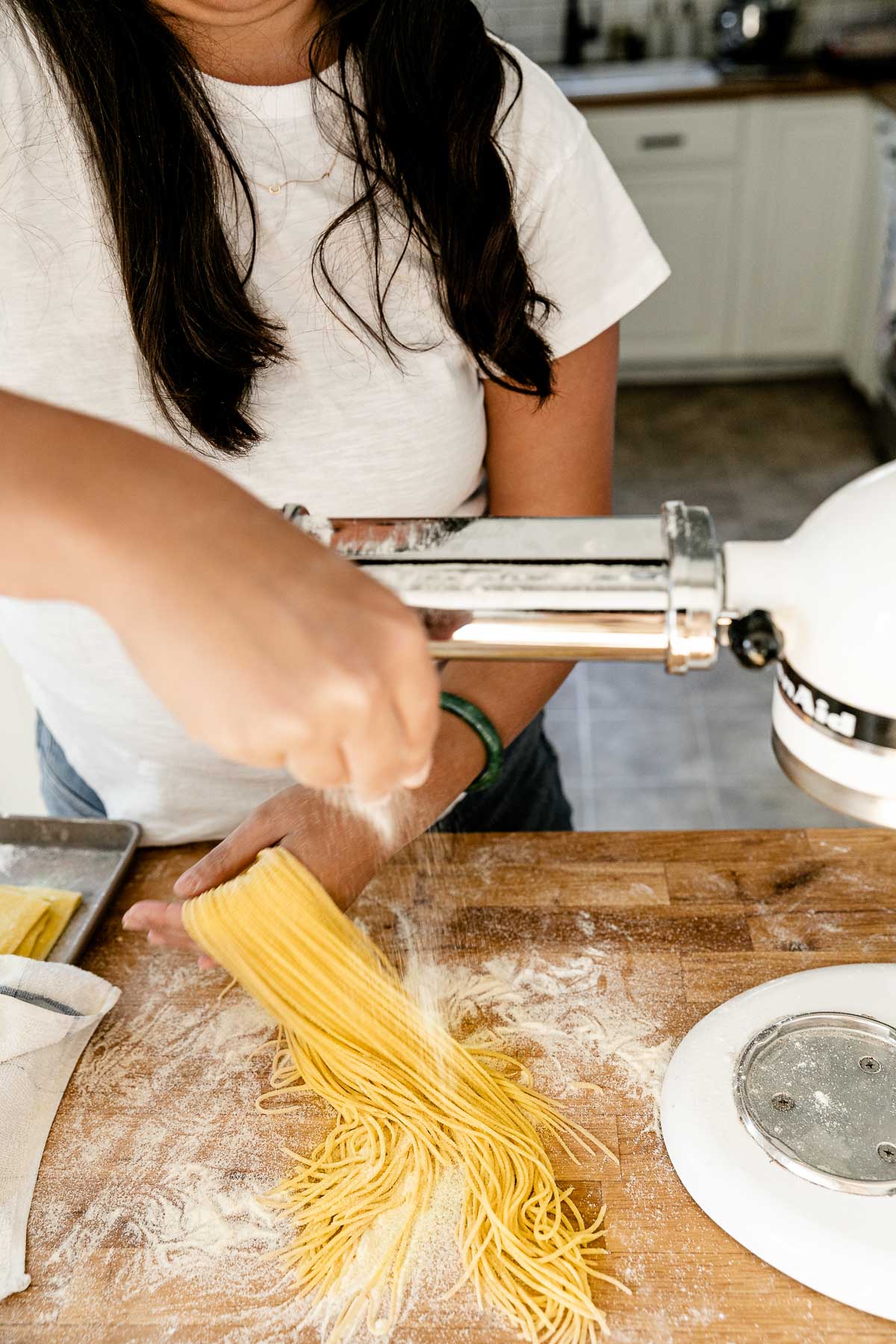

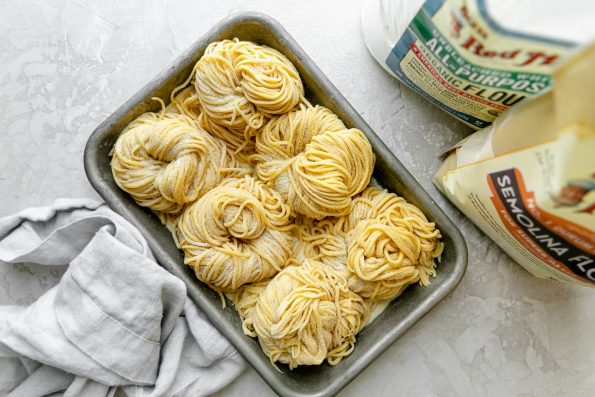
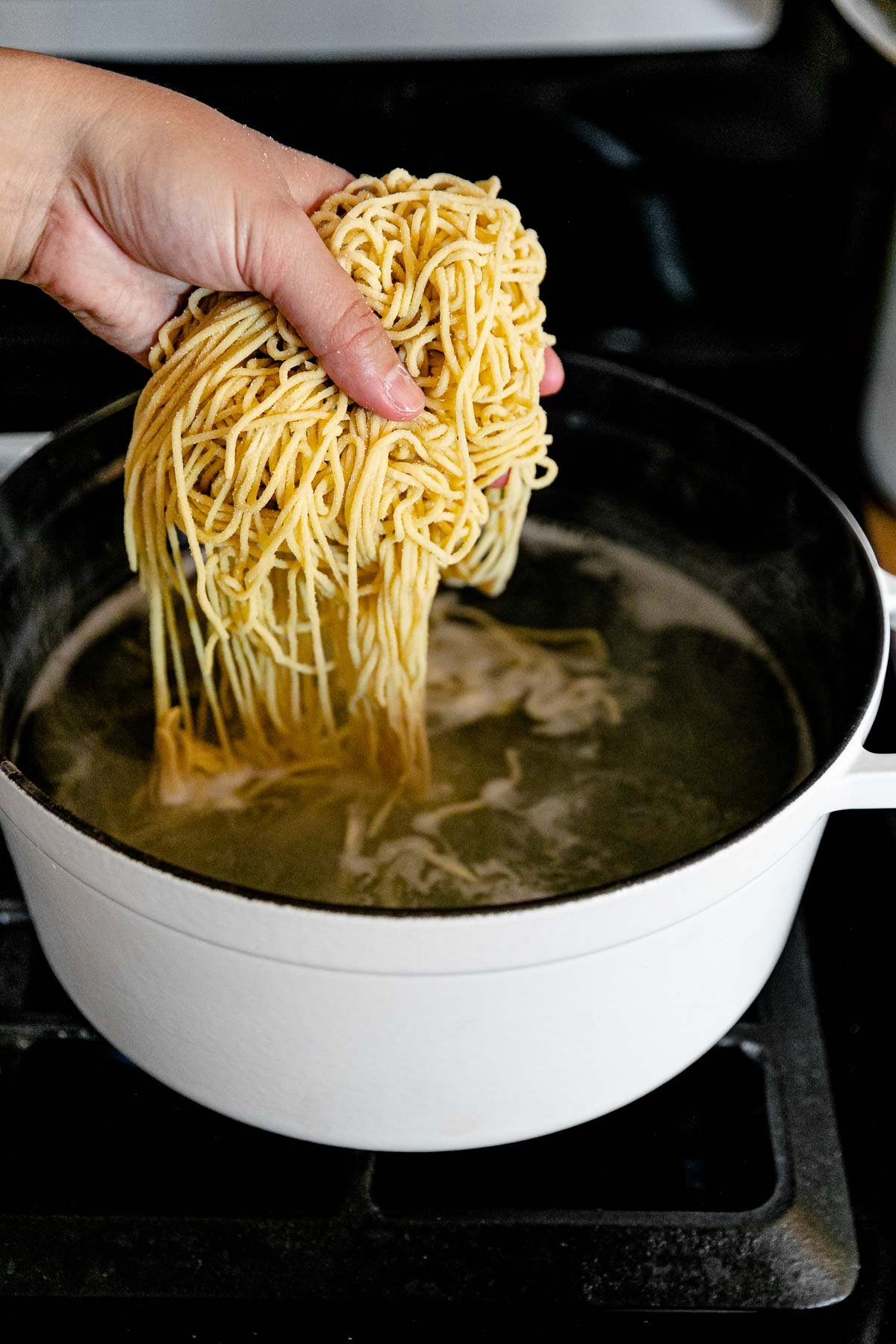
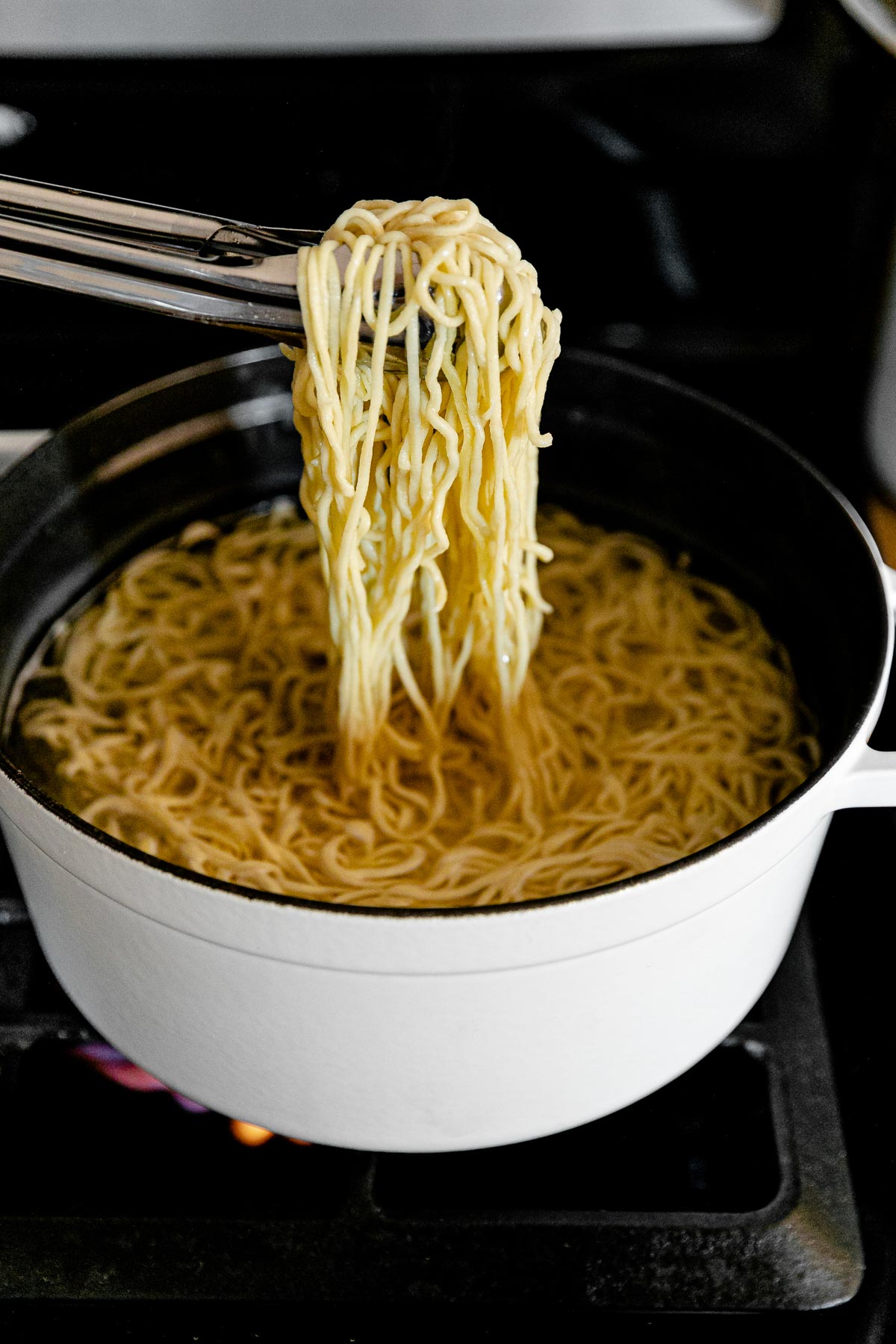
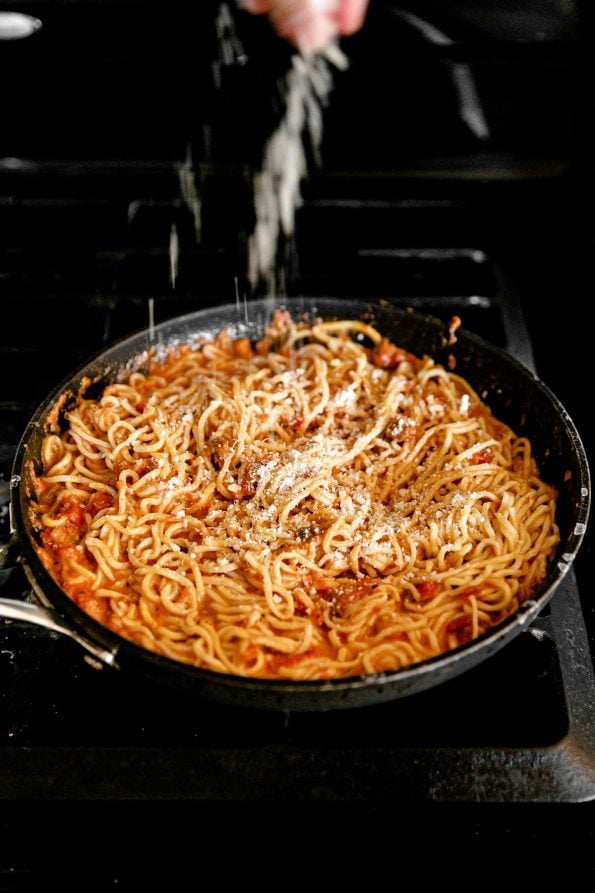
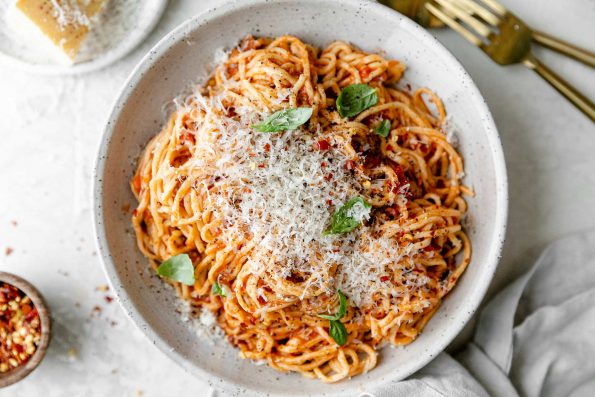
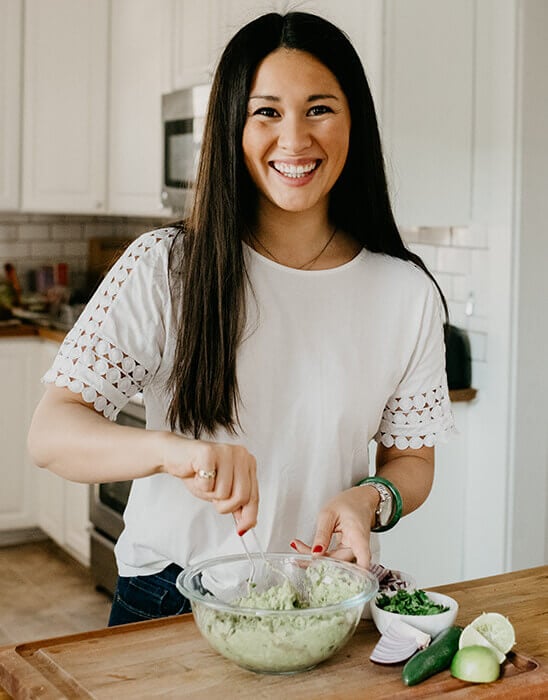
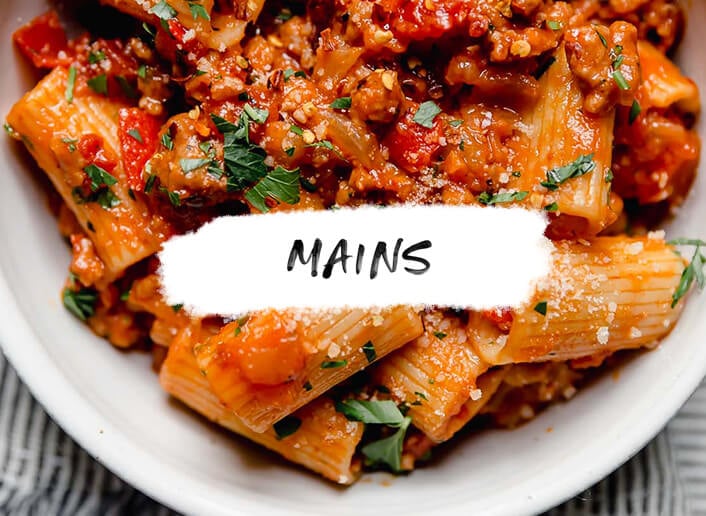
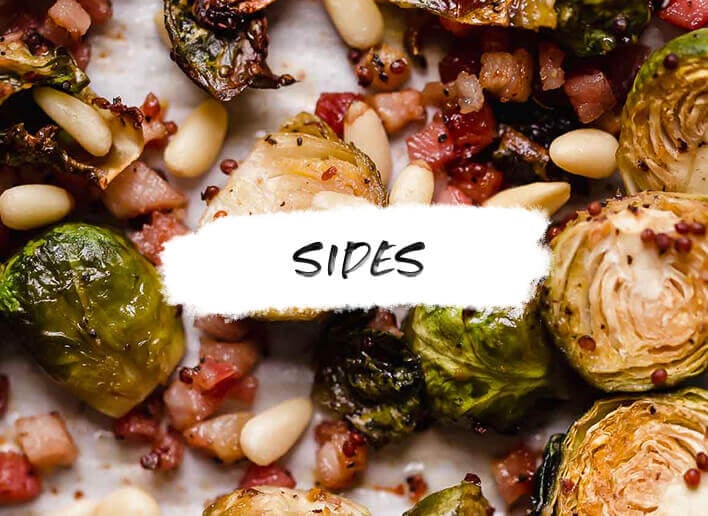

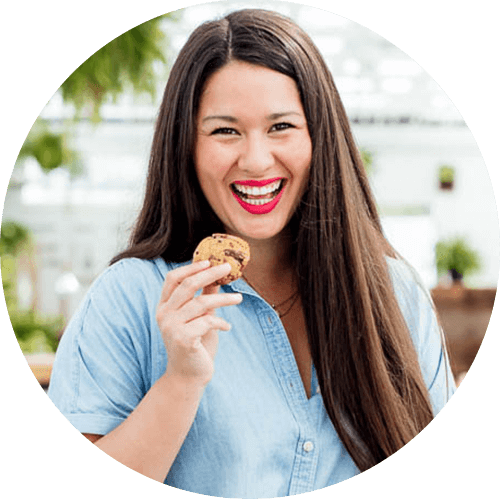


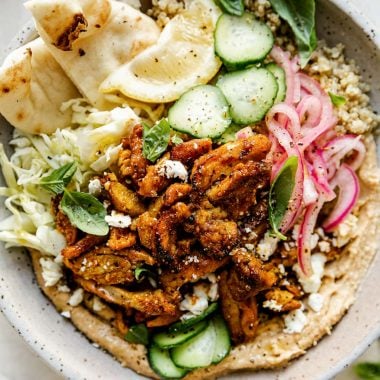
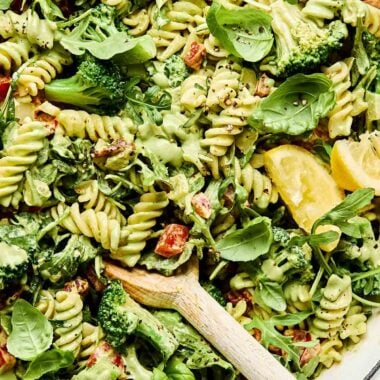
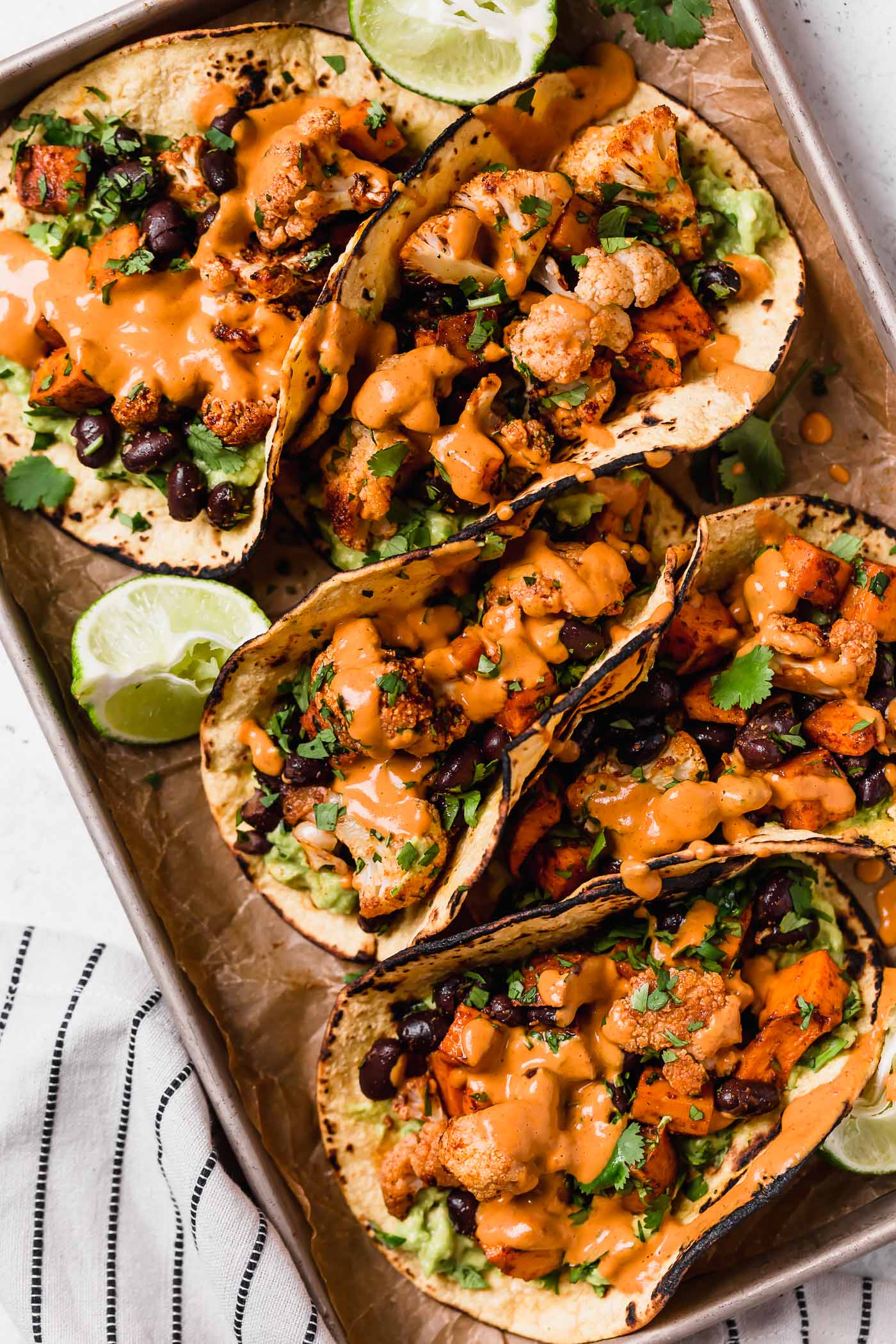
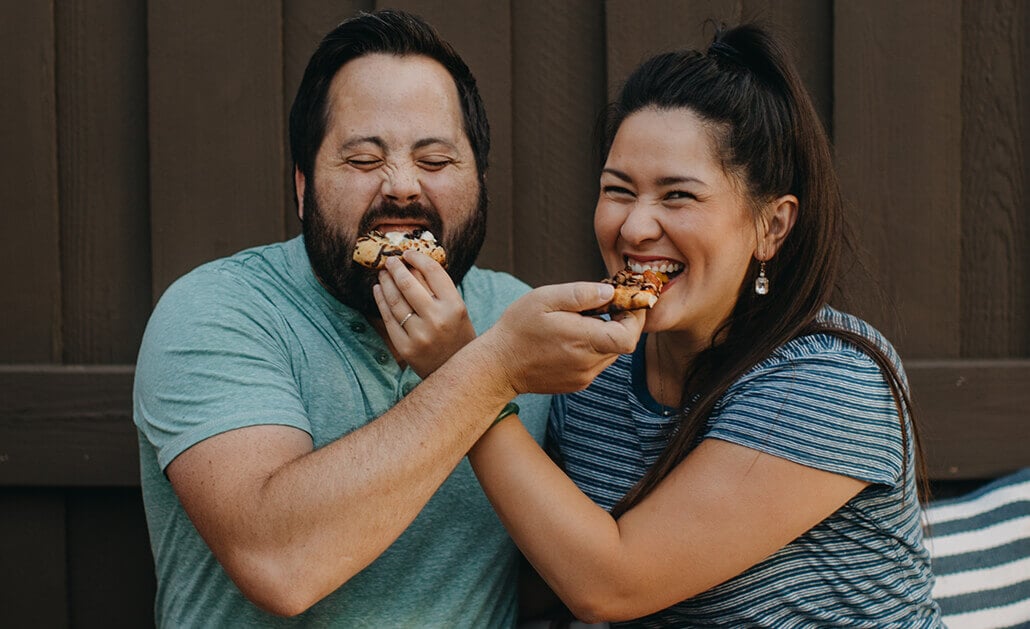
Used the kitchen aid for all aspects of the recipe – ended up with perfect fettuccine. Thank you.
Hi Haley! So glad that this recipe was a success for you, nothing beats making homemade pasta!
This is the first time for me. Perfect instructions! It rolled out perfectly, til my switch on my kitchen aid got stuck , which my husband fixed. At the time I had half the batch, I doubled it as you suggested,, rolled and cut it by hand. After repair, I turned the rest into spaghetti with my kitchen aid attachment, of course. Thank you for inspiring me and hopefully it taste s as good as it looks!
So awesome to hear Edie! Congrats! It definitely sounds like a success & we are so glad that the instructions were helpful. If you are looking for a simple sauce to pair with your fresh pasta check out our Quick & Simple San Marzano sauce, enjoy!!
I’ve attempted several pasta dough recipes and this one is the best one! I don’t need another one ever again. The directions are clear and thorough, the texture of the pasta is wonderful! As usual, Jess has an amazing recipe for us. Love love love. Thank you!